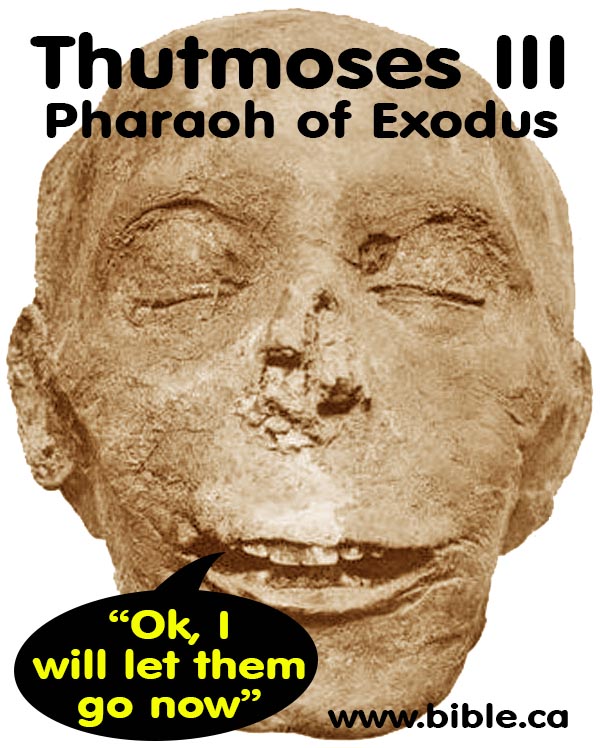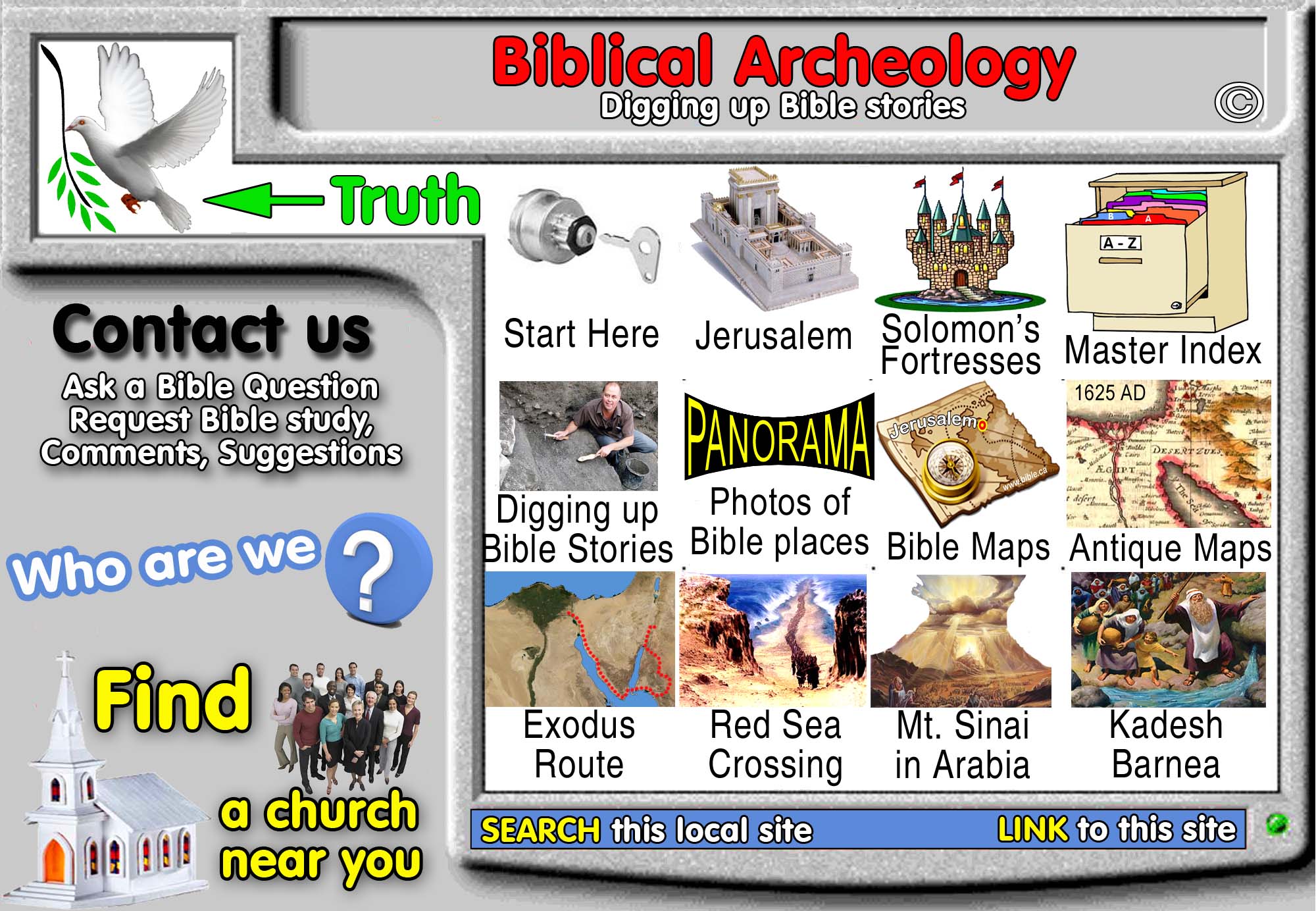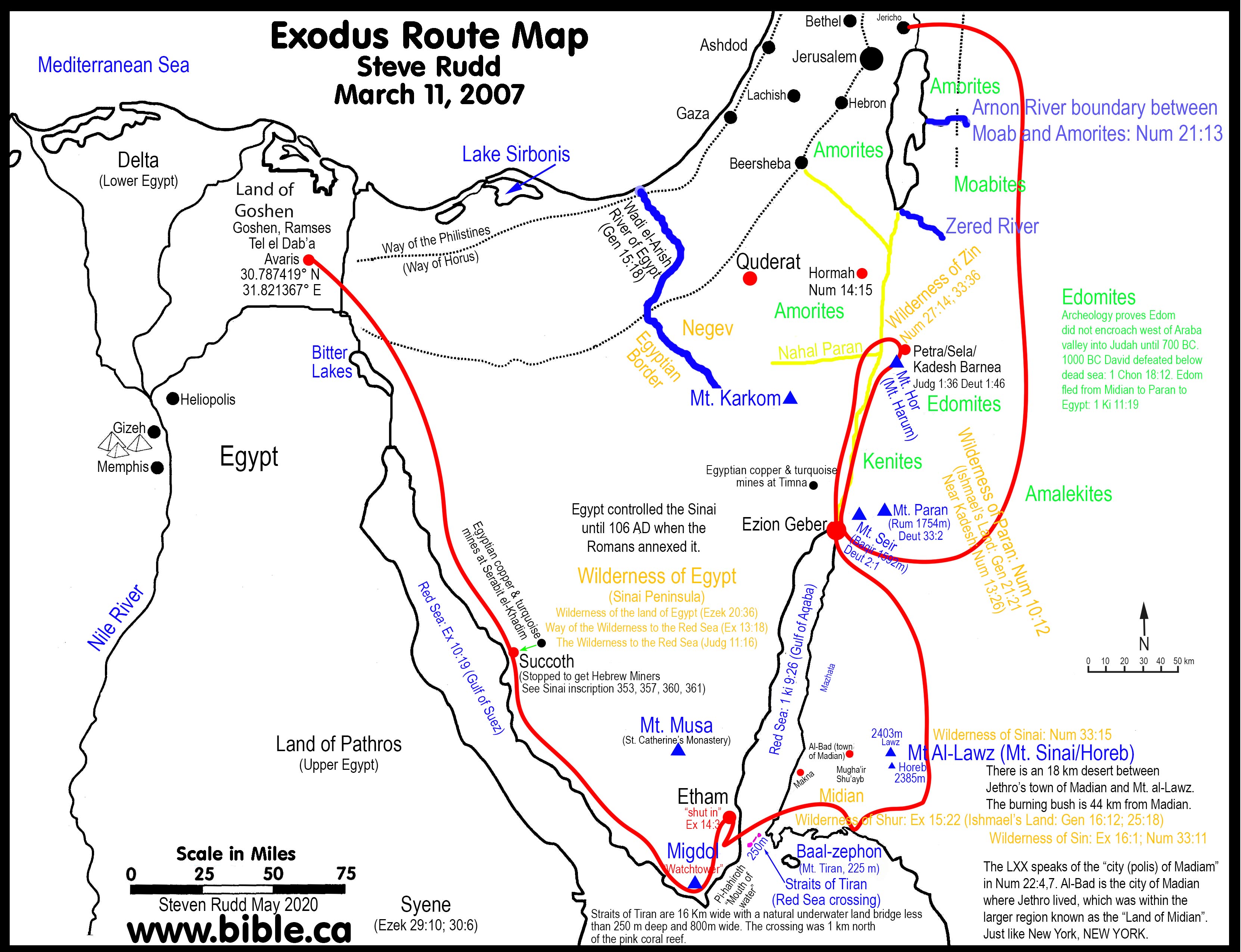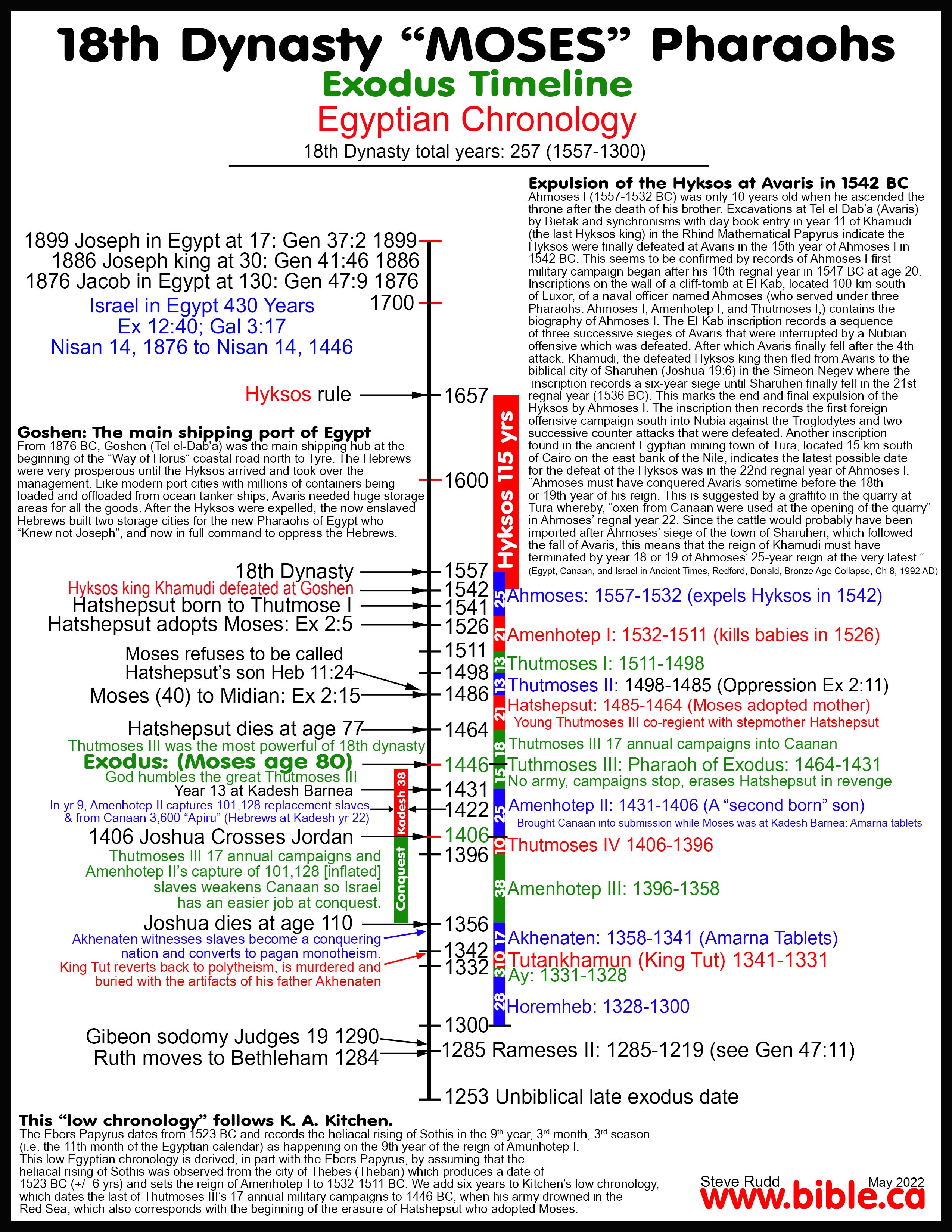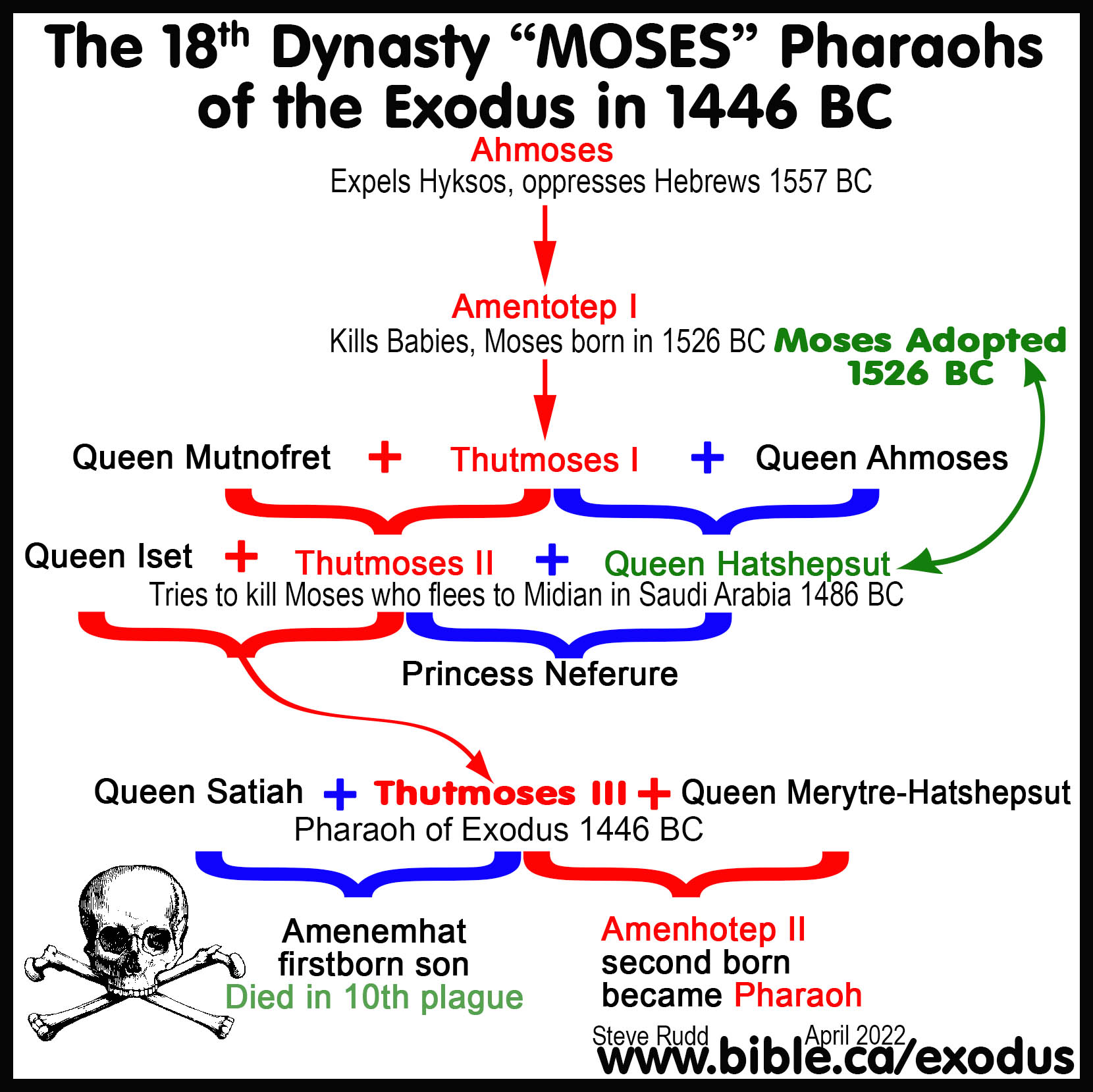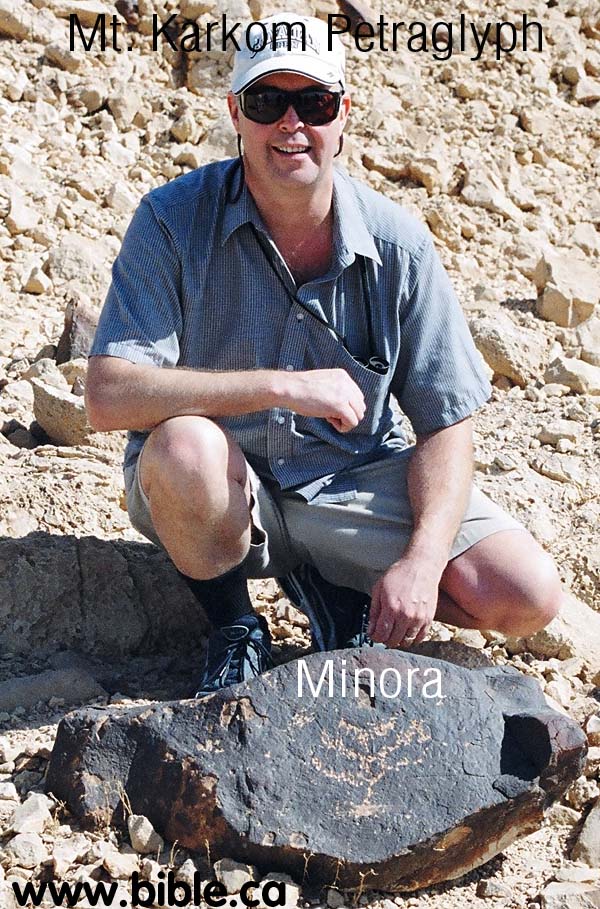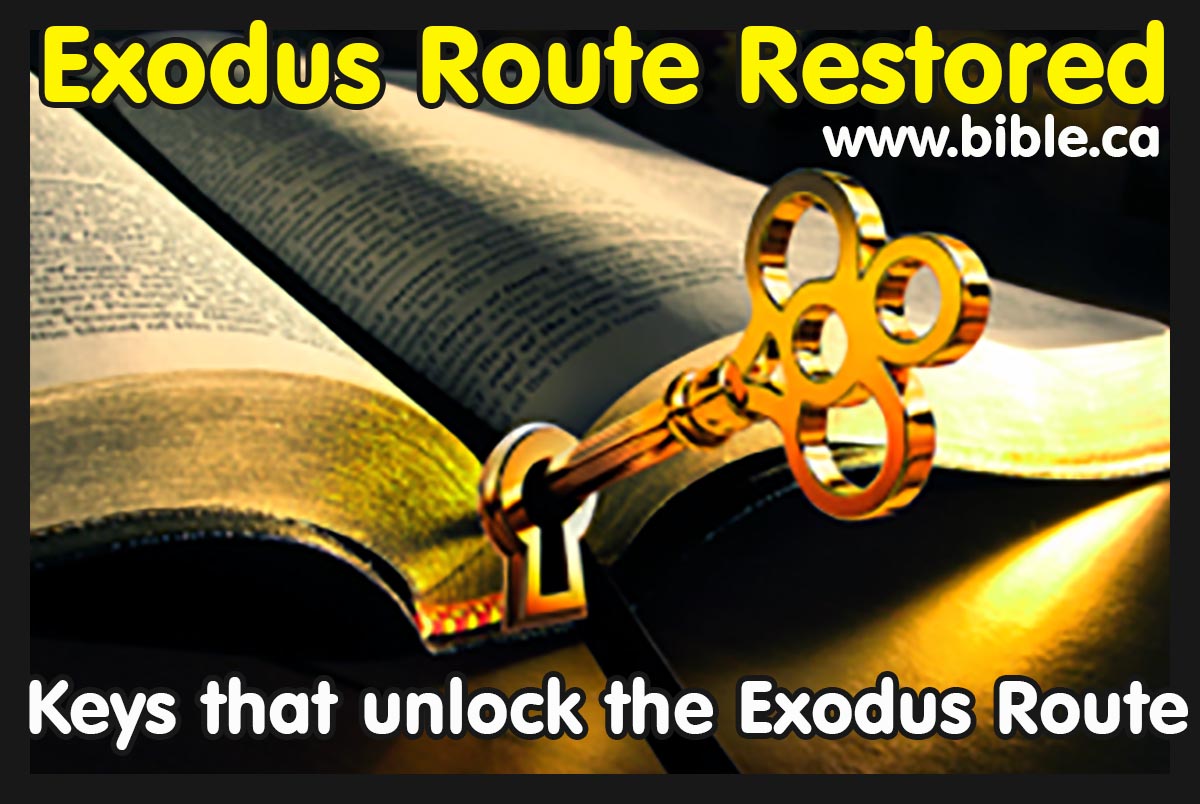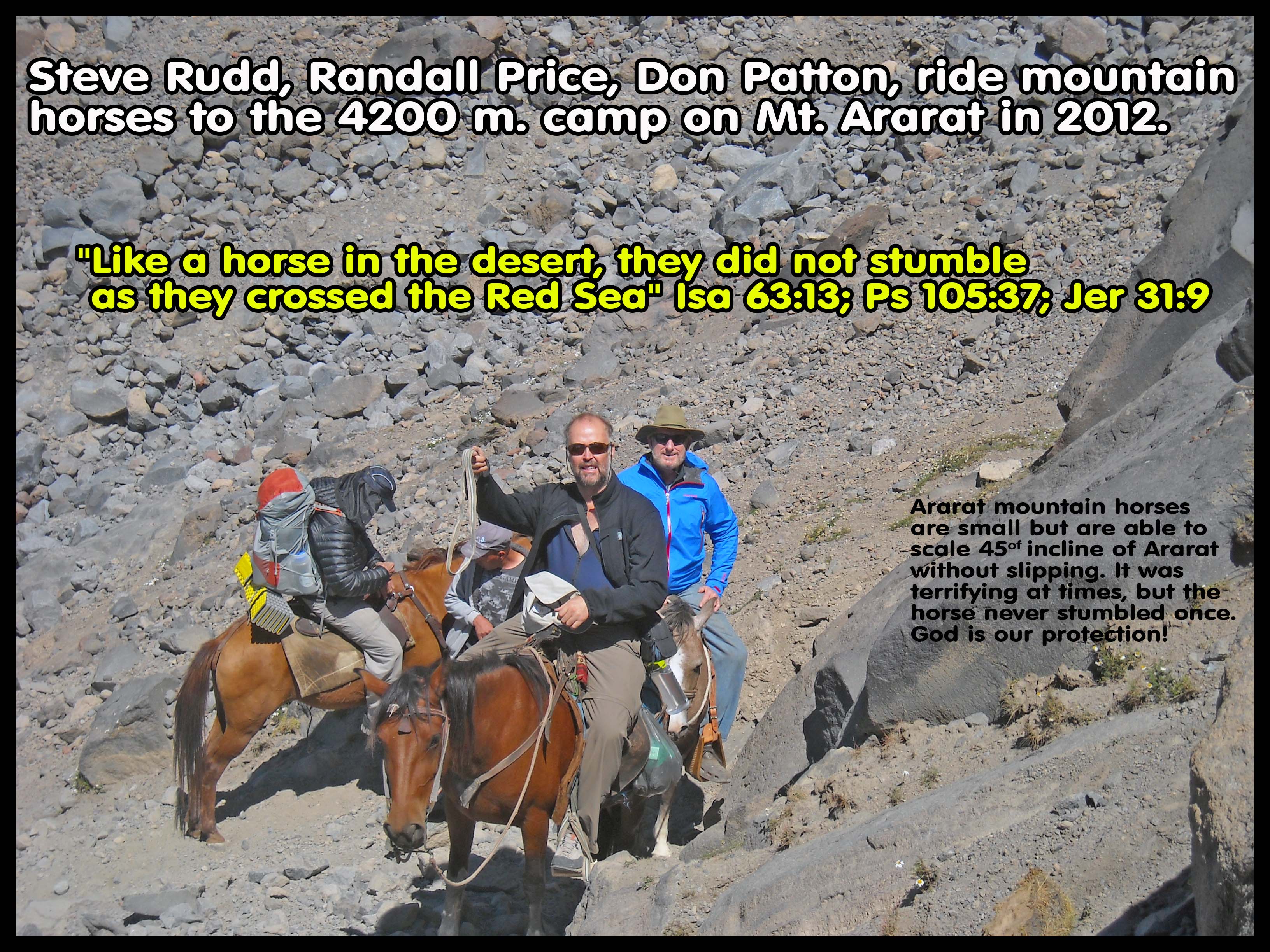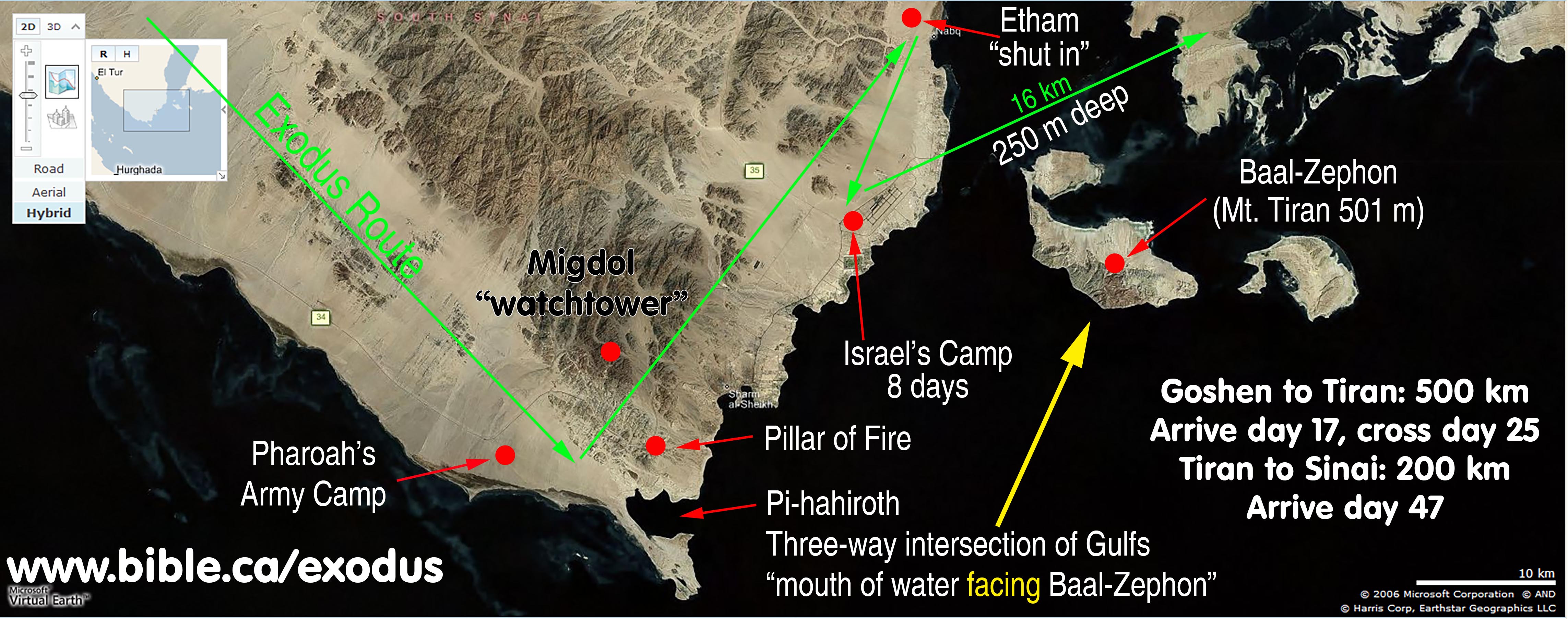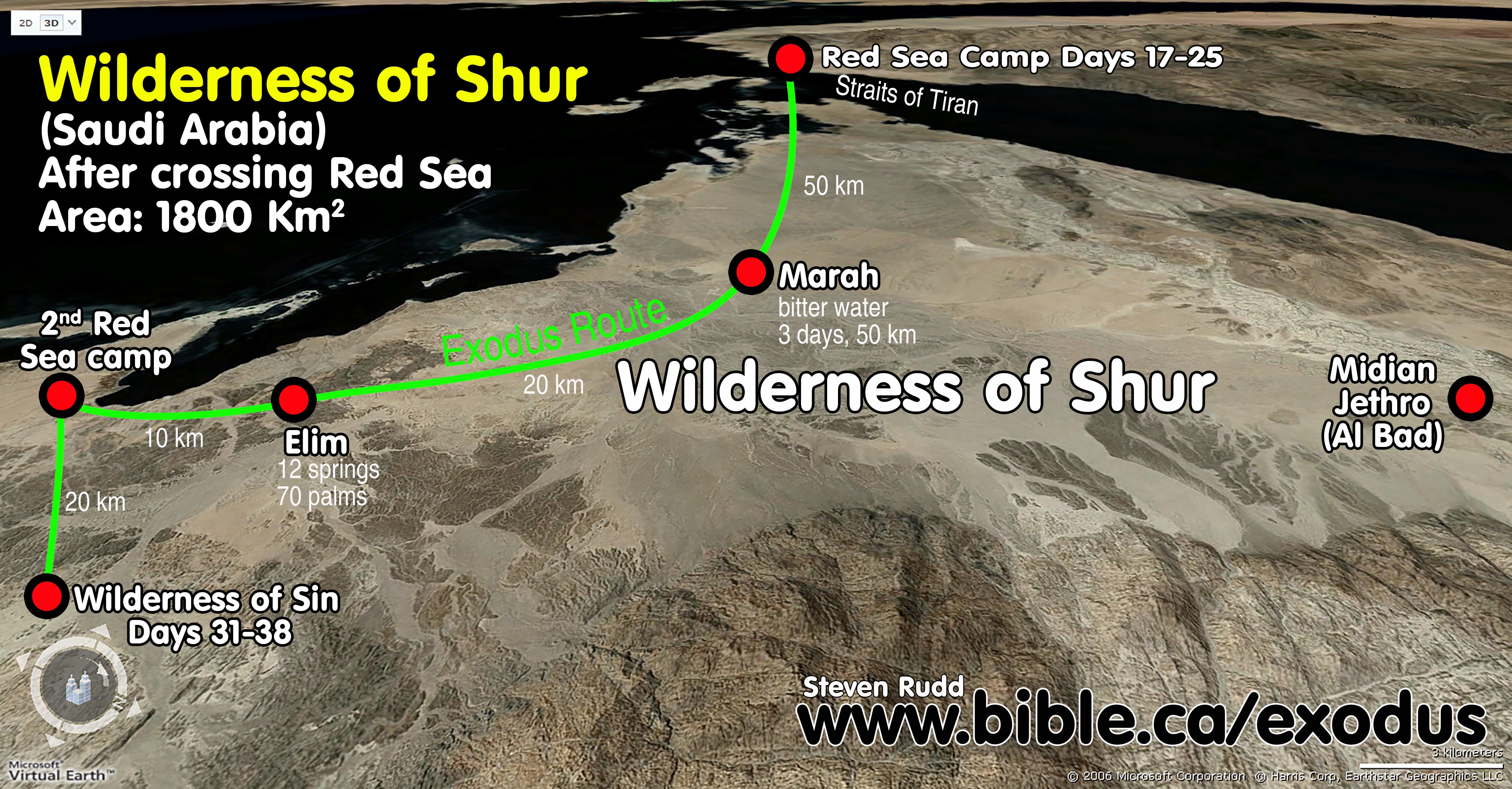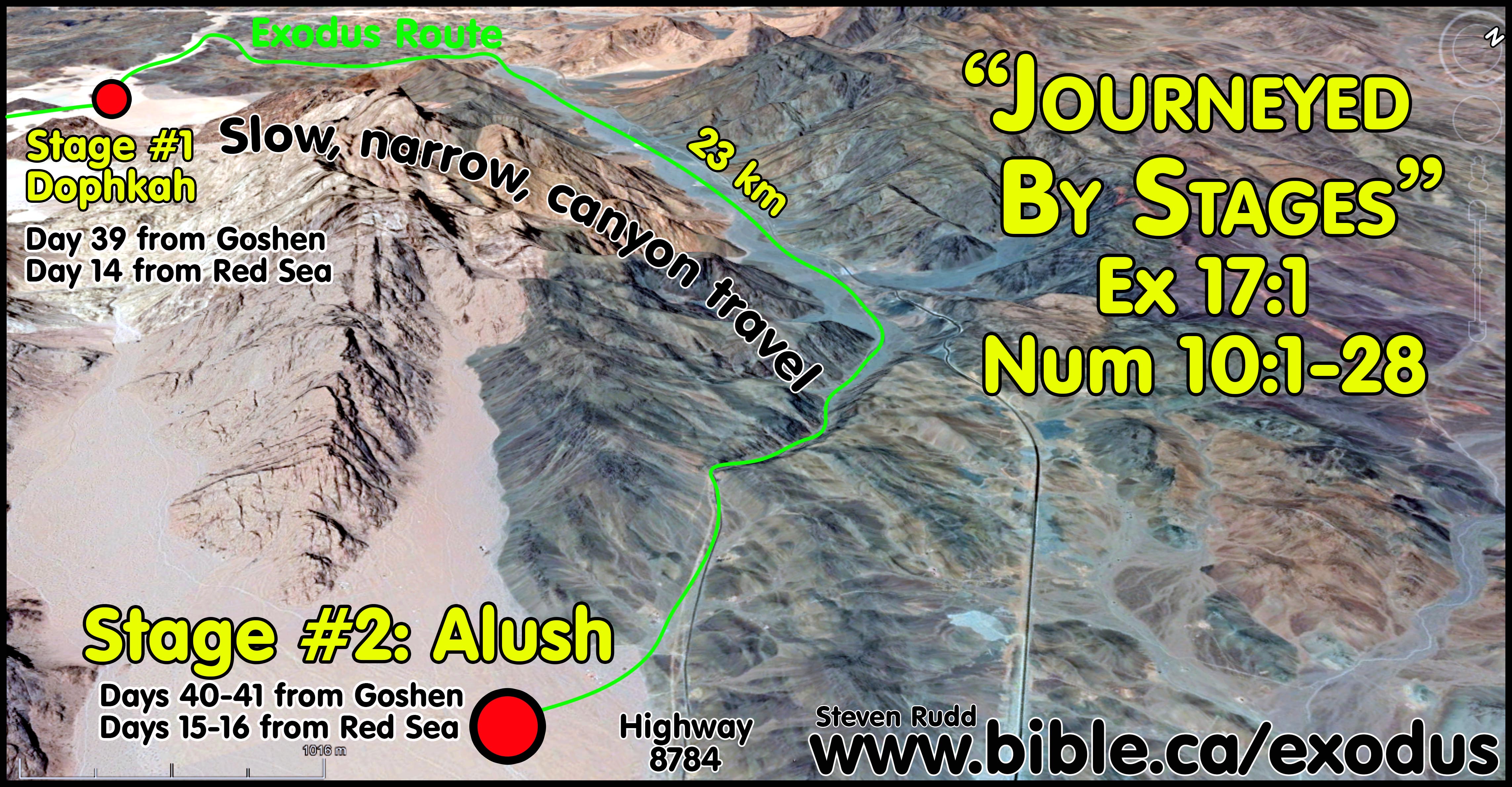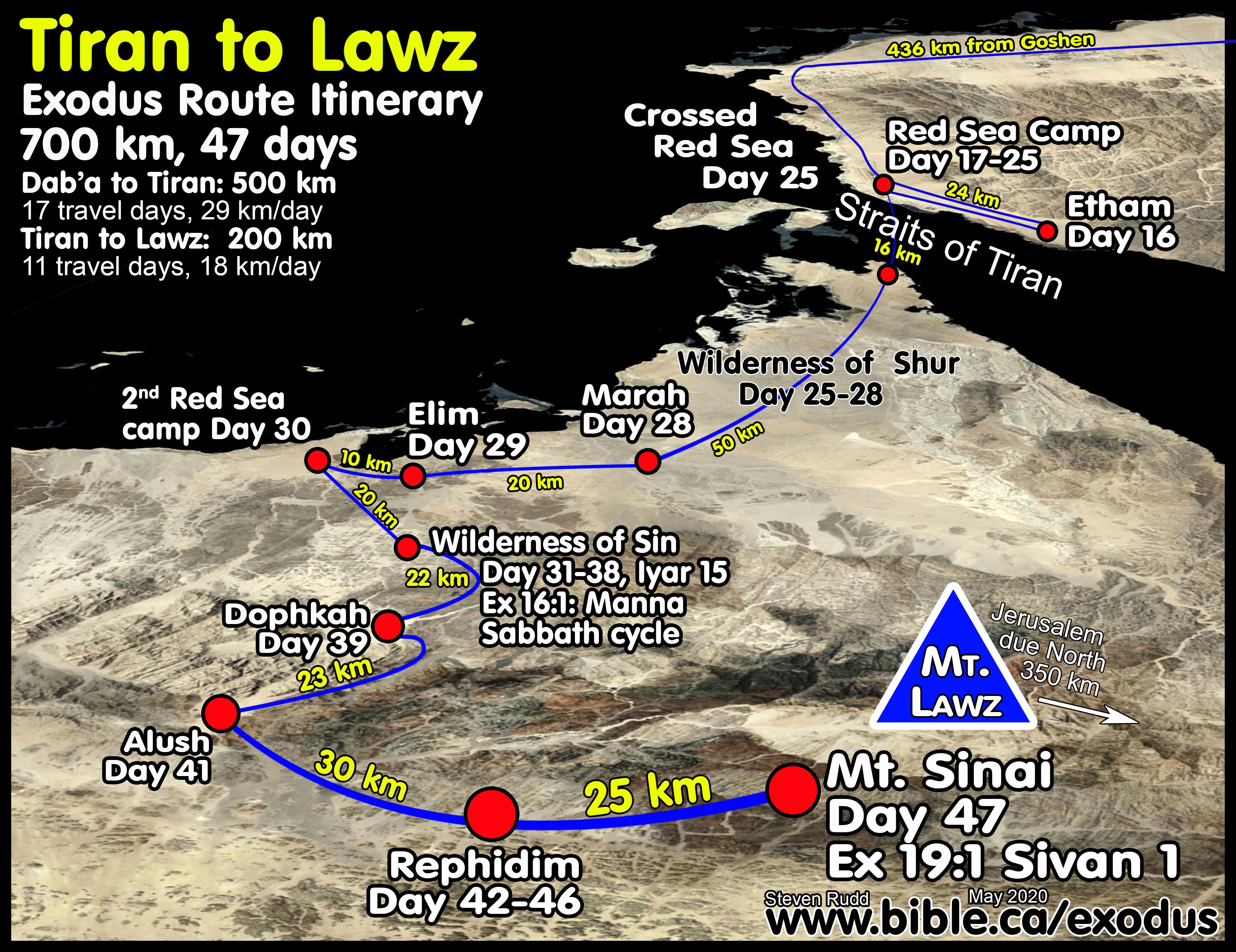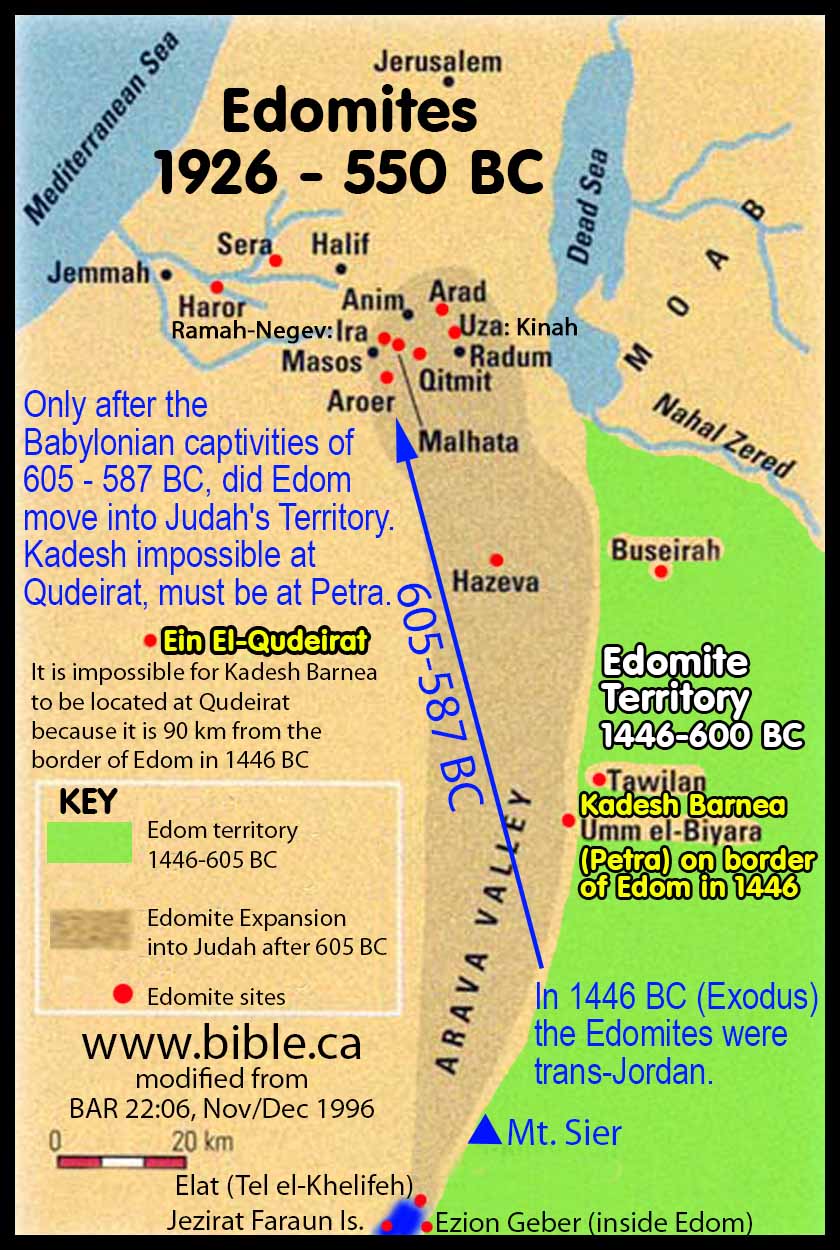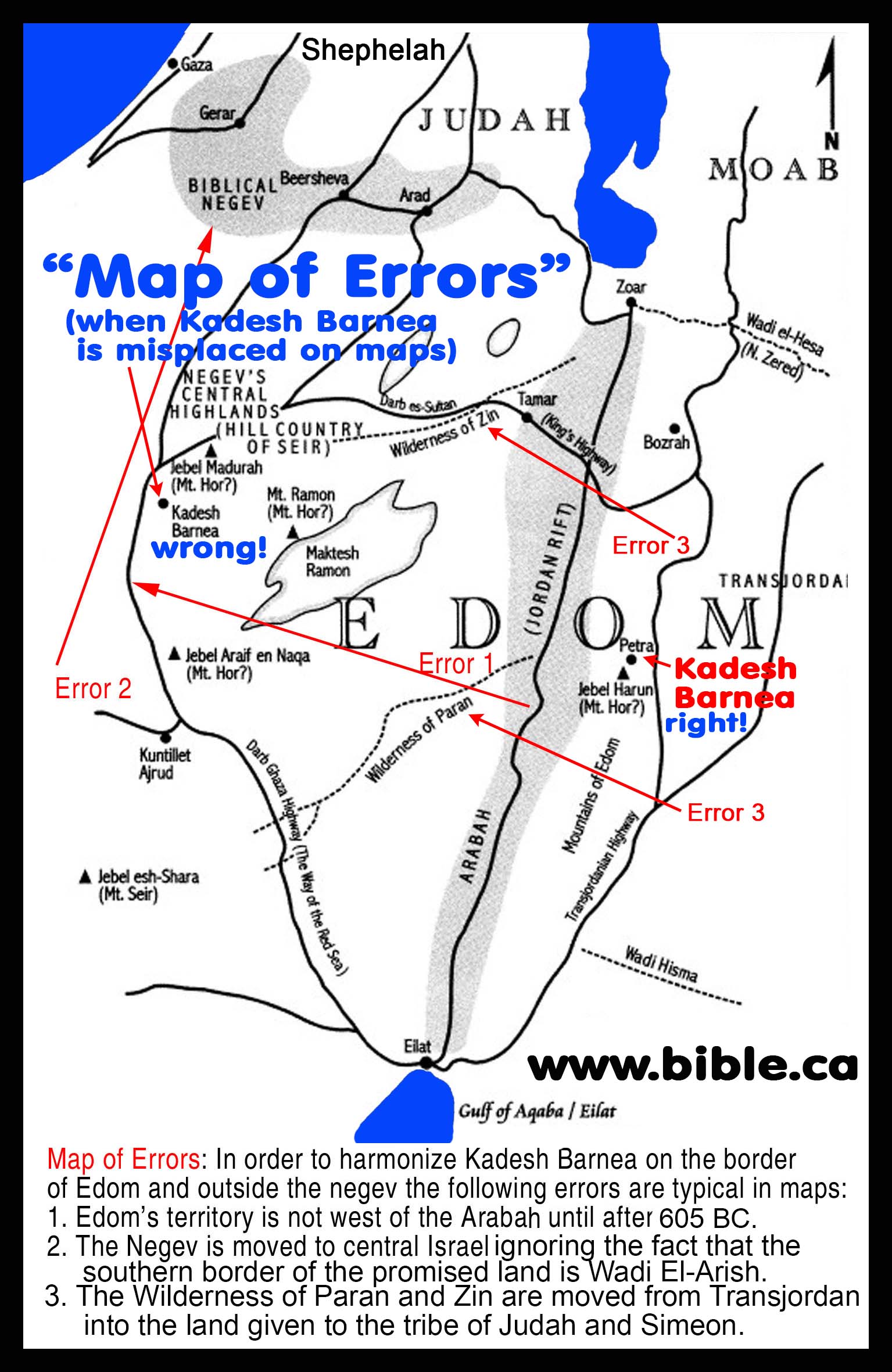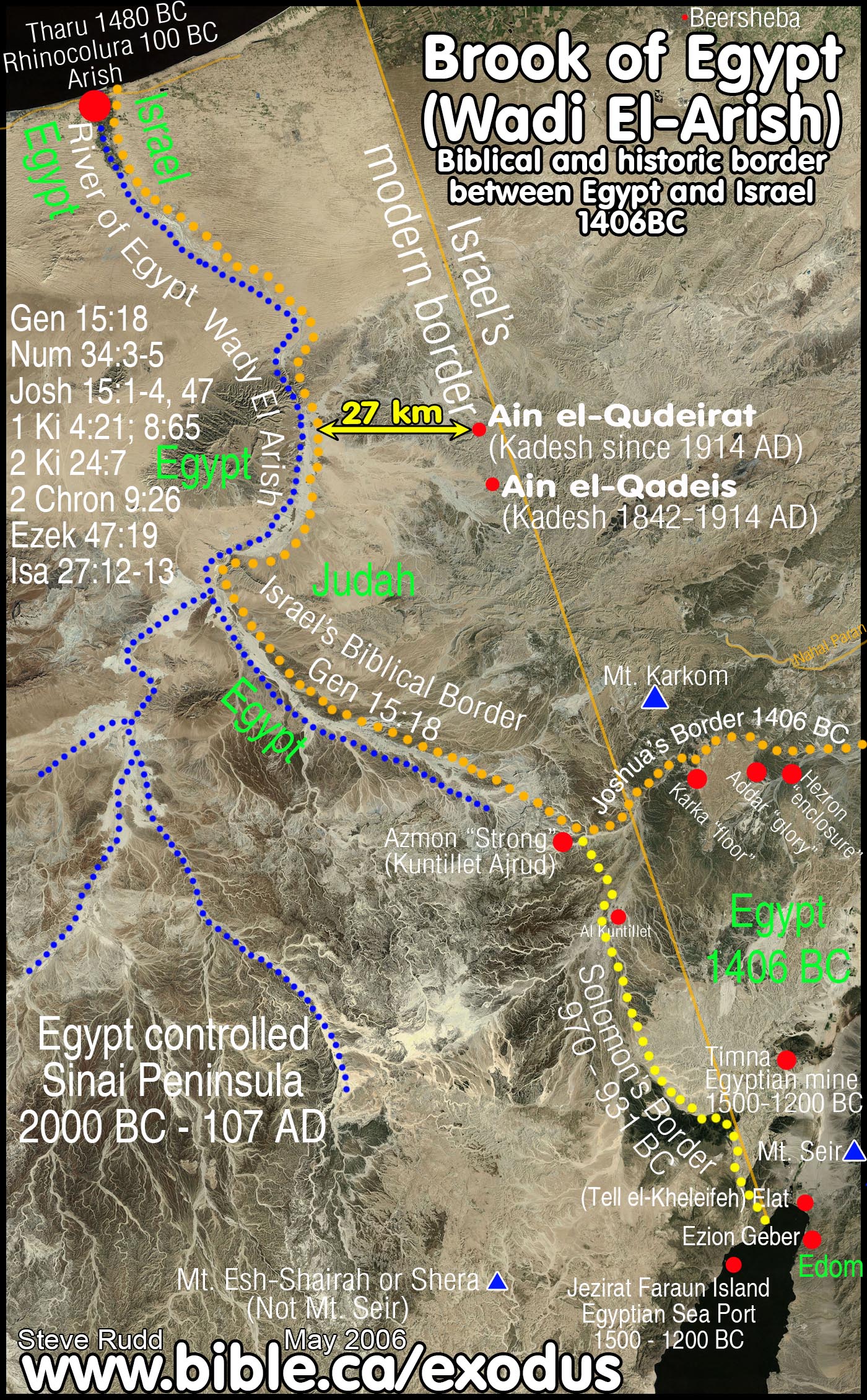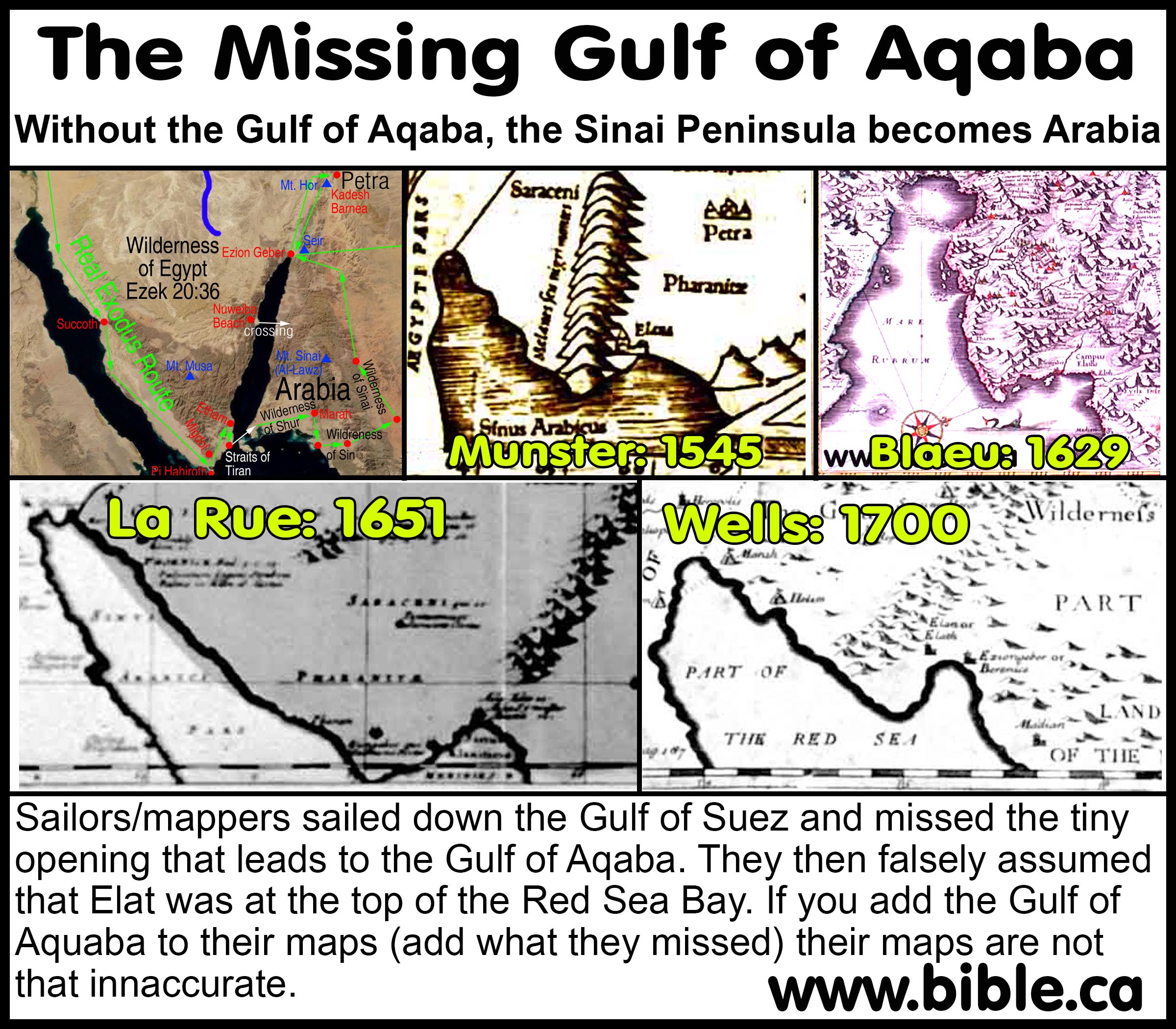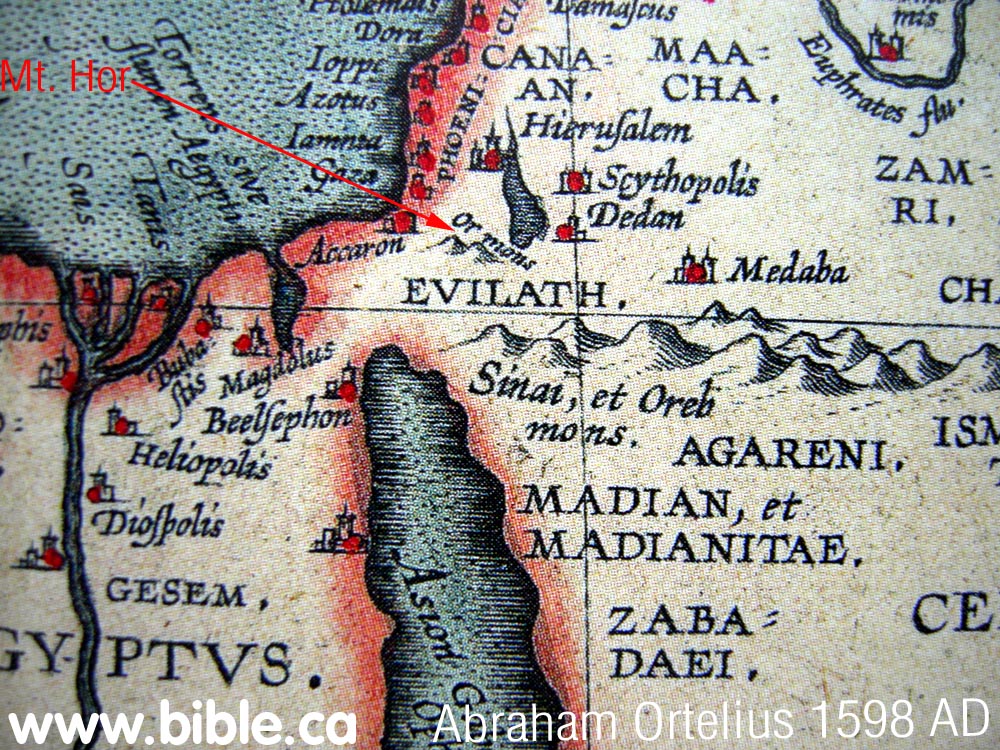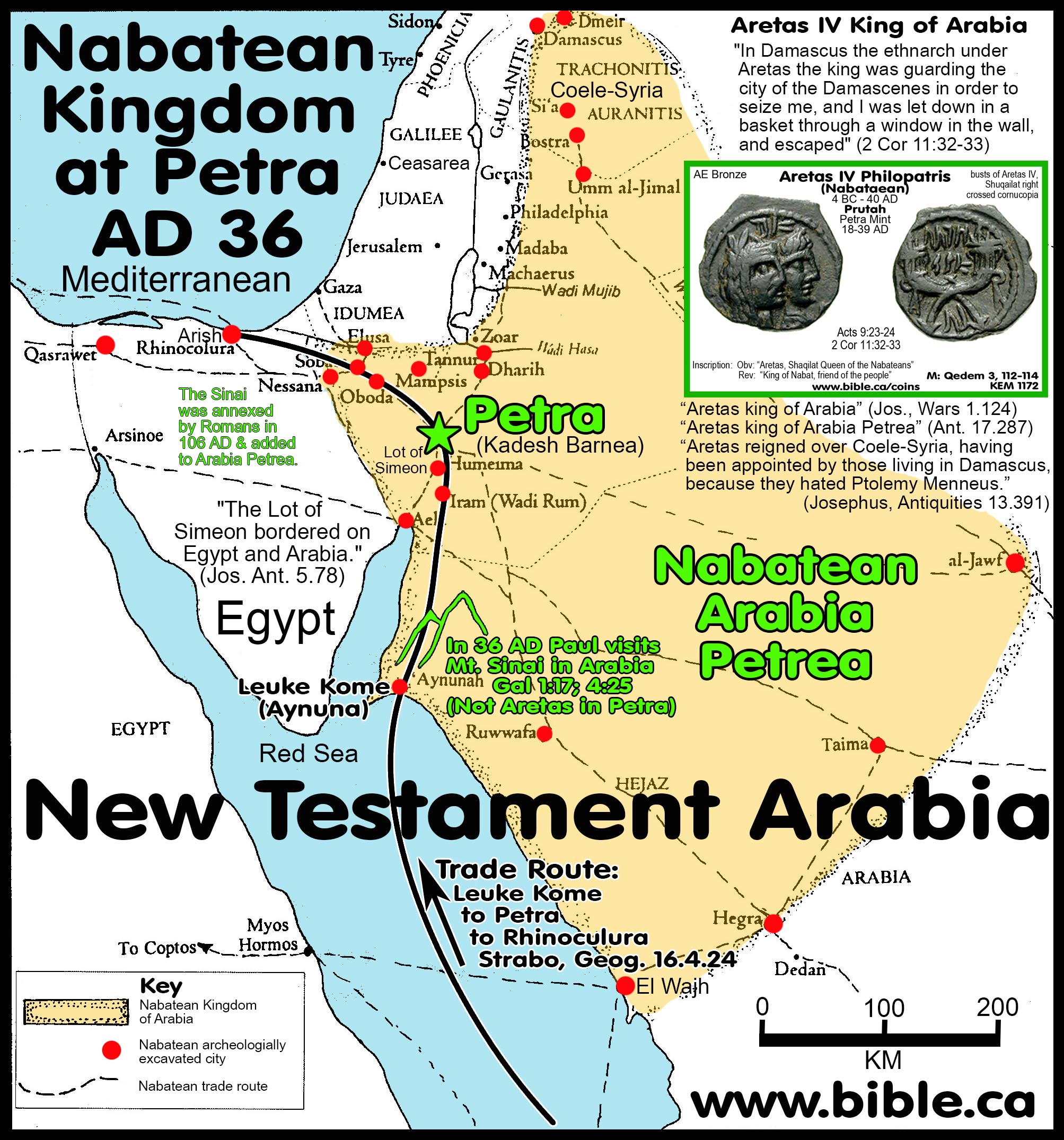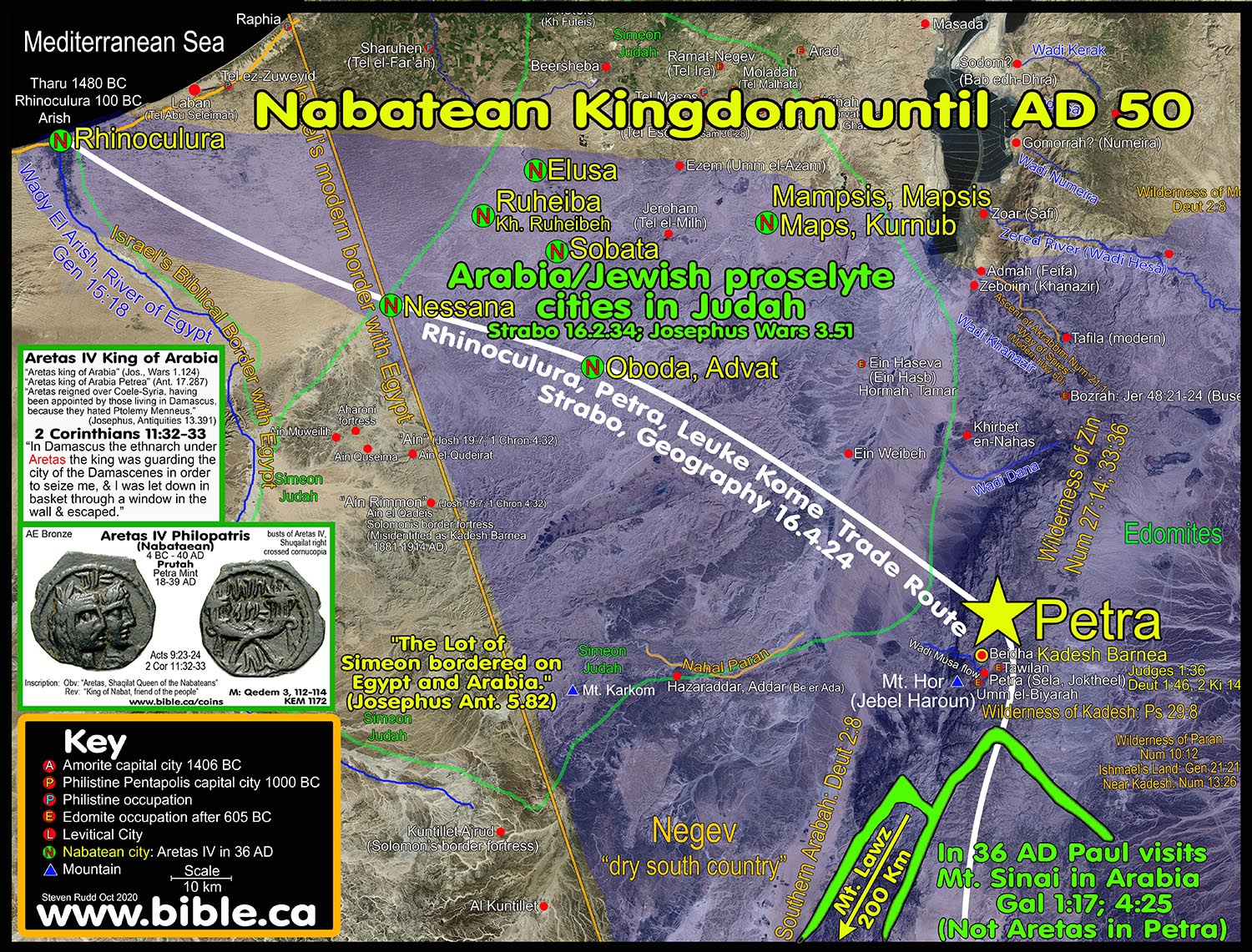Mt. Sinai in Arabia: The Exodus Route Restored!
Proving the exodus
route from the Bible: An Analysis of scriptural proof.
|
Exodus Route Restored:
Don't Make the Monkey Mad! |
||
|
10 Quick facts: 1. The Date of the Exodus: 1446 BC 2. Pharaoh who killed Hebrew children: Amuntotep I: 1532-1511 BC 3. Pharaoh's Daughter who adopted Moses: Hatshepsut: 1526 BC 4. Pharaoh of Moses' flight to Midian in 1486 BC: Thutmoses II/Hatshepsut: 1498-1485 BC 5. Pharaoh of the Exodus: Thutmoses III: 1485/1464 - 1431 BC 6. Red sea crossing: Straits of Tiran on the gulf of Aqaba crossing on day 25 7. Mt. Sinai: Jebel/Mt. Lawz in Saudi Arabia arriving on day 45 spending 11 months 8. Kadesh Barnea at El Beidha beside modern Petra spending 38 years. 9. Crossing the Jordan in 1406 BC, 40 years to the exact day they left Egypt. 10. The Conquest took 6 years and on the first sabbatical year of 1399 BC they set up the tabernacle tent at Shiloh where it stood for 305 years until 1194BC. |
||
Authors note: The exodus route we propose was conceived in 2005 AD, but it is actually a restoration of the ancient view held by first century Christians.
1. Step #1: We began with the Bible as our only guide and blueprint for locating places connected with the exodus. We completely ignored everything EXCEPT the bible: We ignored: maps, history, commentaries and the opinions of archeologists. From this study, we concluded the Scriptures taught that Israel crossed the Red Sea somewhere on the Gulf of Aqaba, forcing Mt. Sinai in Saudi Arabia. (Paul plainly tells us Mt. Sinai is in Arabia: Gal 4:25) We were also able to prove from scripture that Kadesh Barnea must be Transjordan, somewhere south of the Dead Sea in modern Jordan.
2. Step #2: Only after we had concluded our scriptural study, did we begin to consider two important additional witnesses: history and Archaeology. Josephus and Eusebius and others caused us to chose Mt. Lawz as the best candidate for Mt. Sinai. Josephus and Eusebius caused us to choose the general Petra area for Kadesh Barnea. When conflicts arose between the Scriptures , history and Archaeology, we always chose the infallible, all-sufficient, imperishable word of God.
While this may not make Bible doubting archeologists happy, we have more trust in the Bible then the ever shifting opinions of archeologists who are more often looking to disprove the Bible, rather than support it as the book of true ancient history that it really is. Having said this, Archaeology is an important tool in validating the Bible. I have travelled extensively throughout Israel and the Levant. I have been directly involved in many archeological digs under the authority of the IAA (Israel Antiquities Authority). I did not discover this exodus route, I merely restored it to what is revealed in scripture. I hope this book will strengthen your faith in God's inspired word. You can print the maps and glue them into the back of your bible. You can use this material in public presentations and sermons, as long as you do not put any part of this book on the internet or sell it.
![]() Why not visit one of our local
churches? Click
here to locate a congregation in your home town.
Why not visit one of our local
churches? Click
here to locate a congregation in your home town.
Steve Rudd: Contact the author for comments, input or corrections.
|
The Exodus Route |
|
|
|
|
|
|
|
|
50 stops of the Exodus: (4 legs of the Journey)
|
|
|
|
|
|
|
|
|
|
|
Introduction:
1899 BC: Israelites enter Egypt
The Hebrews entered Egypt in 1899 BC when Joseph was sold by his brothers to the Ancient Arabians known as "Ishmaelites".
Archeology has shown from excavations at Ramses (Tel el-Dab'a), that from the time of Jacob entering Egypt in 1876 BC, Asiatics ran the commerce hub located there as an egalitarian society. One of the most stunning archeological finds in history at Tel el-Dab'a was a fractured statue that dated to the 12th Dynasty Pharaohs (1900 BC). The Egyptians were always careful to portray different things that showed the national background of the subjects of their paintings or statues, as well as their status in society. The person portrayed in this statue had a lighter skin than was used in portraying native Egyptians. He also had a flail held across his chest. The flail was meant to symbolize that he was a person with considerable authority, but not a pharaoh; pharaohs were shown with the double crown of Egypt and the ‘uraeus’ or cobra’s head on that crown. He was therefore an ‘Asiatic’, i.e. a Semitic person. His statue had been smashed into pieces by someone who was very angry at him and what he represented, although previous to this he must have been held in high regard. It was slightly larger than life size. It was also associated by some archaeologists with an impressive mansion that its own tomb in the form of a small pyramid. The tomb, however, was empty; someone had removed the mummy, apparently before the smashing took place. This led to speculation that this was a portrayal of Joseph, since all these facts would fit what we know about Joseph from the Bible. It has therefore been called by some “the Joseph statue.” Others think it is instead a statue of Joseph’s father, Jacob, but this does not fit with the youthful appearance; Joseph was 30 years old when he became vizier, but Jacob did not enter Egypt until he was 130 (Exodus 47:9).
1657-1557 BC: Hyksos conquer Egypt for 100 years.
In 1657 BC the Hyksos overthrew the pharaohs of Egypt and built their palaces at Tel el-Daba. The Hyksos ruled for 100 years, displacing the Egyptians as the government of Egypt and were the Pharaohs who "knew Joseph" and cooperated with the Hebrews. Archeology has confirmed that the Hyksos built three palaces at Tel el Daba directly beside the Hebrews.
1557 BC: Rise of the 18th Dynasty "MOSES PHARAOHS" who "Knew not Joseph": (Period of oppression and slavery)
Then the Egyptians over threw the rebel Hyksos government in 1557 BC by AhMOSES I who became the first 18th dynasty Pharaoh who "did not know Joseph". With the Hyksos expelled, Ahmoses I took over their palaces at Tel el-Daba, which explains how Moses was found by Pharaoh's Daughter near where the Hebrews lived. Ahmose I marks the beginning of the period of slavery and oppression as a way to prevent the Hebrews from seeking the throne of Egypt. Exodus 1:11 tells us that the Hebrews were making mud bricks to build the storage cities of Pithom (Tell el-Retaba) and Rameses (Tel el-Dab'a), both of which have been extensively excavated through archeological digs. It may be a puzzle to some would Pharaoh build a storage city in the very town the Hebrews lived in until you remember that this was the main shipping hub at the begging of the Way of Horus. So the Hebrews lived in a city similar to modern port cities with millions of containers being loaded and offloaded from ocean tanker ships. The Slavery and oppression was a political and social policy to make sure the Egyptians never lost control of their country again, like they did under the 100 year period of the Hyksos. "Come, let us deal wisely with them, or else they will multiply and in the event of war, they will also join themselves to those who hate us, and fight against us and depart from the land.” (Exodus 1:10) Notice the Exodus narrative begins with the defeat of the rebel Hyksos and the rise of Ahmose I with a special note how prosperous the Hebrews had become. But for the next 100 years from Ahmose I to Thutmoses III (Pharaoh of the Exodus), the Hebrews went from the management role to slaves and may have lost some of their business skills during this period. However, God saw fit to once again give them a world-class training at another major commerce center like Tel el-Daba at Kadesh Barnea. Kadesh, located at modern Petra, was a triple crossroads of trade where they spent 38 years once again learning trade, commerce and how to run a business. This may explain why even today, the Jews are so incredibly prosperous in the world of business. If only we could get these "natural branches" to believe in Jesus Christ their risen messiah.
1526 BC: Moses is adopted by Hatshepsut into Pharaoh's house.
|
The previous efforts to "let us deal wisely" with the Hebrews was not working and the Egyptians were being out populated productive Israelites. Amuntotep I (1532-1511 BC) decides to kill all the male Hebrew children. This is antitypical to Herod's slaughter of the babies at the time Jesus was born in 1 BC. Hatshepsut was the daughter of pharaoh who drew Moses out of the water and adopted him into the king's household. Hatshepsut was the daughter of Thutmoses I who married her brother Thutmoses II. |
1486 BC: Moses flees to Midian in Saudi Arabia after killing Egyptian age 40:
Pharaoh Thutmoses II (1498-1485 BC) married his sister Hatshepsut who was the adopted mother of Moses. Moses saw the oppression of his fellow Hebrews and killed the Egyptian, which was an act of treason. "By faith Moses, when he had grown up, refused to be called the son of Pharaoh’s daughter, choosing rather to endure ill-treatment with the people of God than to enjoy the passing pleasures of sin, considering the reproach of Christ greater riches than the treasures of Egypt; for he was looking to the reward. By faith he left Egypt, not fearing the wrath of the king; for he endured, as seeing Him who is unseen." (Hebrews 11:24–27) At age 40, Moses fled Egypt to Midian where Jethro, the priest of Mt. Sinai called the "Mountain of God". Although a guess, Moses probably escaped exactly the same route in 1486 BC as he used in the Exodus by travelling down the eastern shore of the Gulf of Aqaba to cross over to Arabia (Midian, wilderness of Shur) by one of the many boats that ferried between the two shores of Arabia and Egypt.
1446 BC: The Exodus begins after the 10 plagues destroy Egypt
The entire population of 2-4 million Jews left Egypt, and the Exodus began. Be warned, that attempting to reduce the migration to 35,000 using a fallacious argument based on the Hebrew word for 1000 [elep] meaning "clans", guts the inspiration of the bible. At the time of the exodus, the city of Tel el-Daba was called, Parunefer meaning "happy journey" because Tel el-Daba is the starting and staging hub of the Way of Horus and was a major commerce center. Moses was forbidden from taking the "Way of Horus" which hugged the Mediterranean coast to Canaan. Instead, he retraced the very route he took 40 years earlier, except this time he crossed the Red sea, not in a boat, but by a miracle of God. Moses arrives at Mt. Sinai and climbs the mountain for a total of eight ascensions up Mt. Sinai. The exodus Route has about 50 stops and traverses 7 wildernesses. We can be certain of only the locations of Goshen (tel El-Dab'a), Ezion-Geber, Dibon, Mt. Nebo and Shittim (Tel el-Hamman) and the wilderness of Shur of Midian in north Saudi Arabia.
Many of the New Testament antitypes and images have their origin in the exodus.
- The Lord's Supper is a type of the Passover meal of Ex 12. Just as the Jews partook of the Passover meal once a year, Christians partake of the Lord's Supper every week: Learn more about the Lord's Supper.
- The pillar of fire was the first physical appearance of the presence of God on earth that went through a series of physical transformations. The presence of God in the Pillar of fire was replaced by the most holy place in the Tabernacle of Moses, which was replaced by the Temple of Solomon, which finally became the body of a Christian individually and the church collectively. (1 Corinthians 3:16-17; 6:19-20; Ephesians 2:19-22) see: detailed study
- The pillar of fire also represented the light of God's word that lights our path: Ps 119:105.
- Our salvation from the slavery of sin happens when we are baptized into Christ, and is a type of the Red Sea crossing when they were saved from the slavery of Egypt and baptized into Moses: 1 Cor 10:1-4. Have you been baptized in water by full immersion as a believer in order to be saved? Take this interactive online Bible study!
- The manna in the wilderness was an antitype of Jesus himself and the Lord's supper: John 6:31–32, 41, 48-51, 52-58
- God as "Our Rock" had is a type of the Rock
Moses struck for water. 1 Cor 10:4.
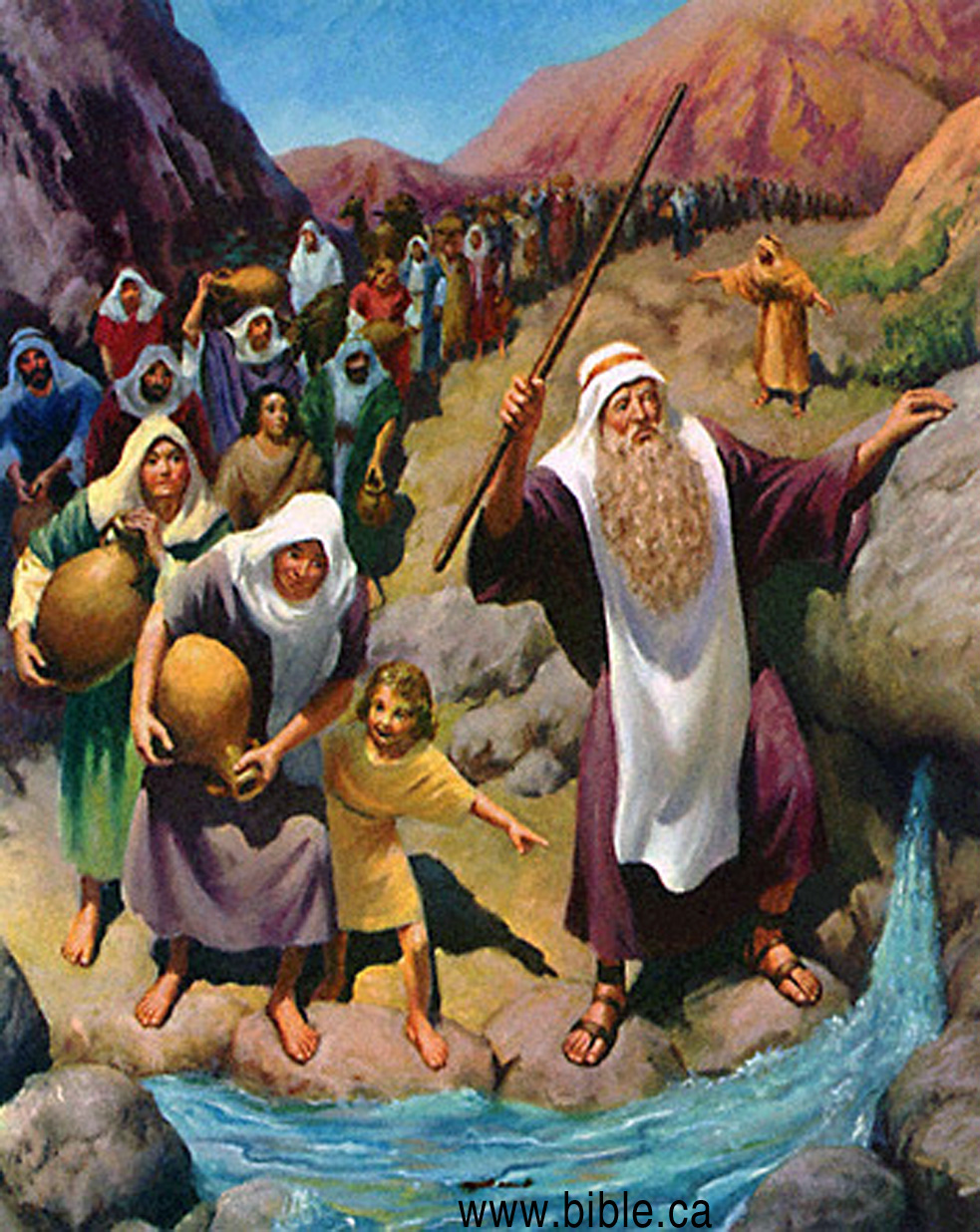
- Mt. Sinai is a type of the heavenly Jerusalem: Hebrews 12:18-24.
- The 38 years in the wilderness at Kadesh Barnea is a type of our earthly life.
- Just as the Hebrews did not stumble "Like a horse in the desert" when they travelled day and night then crossed the Red Sea, so too Christians will never stumble if we walk in the light and imitate Jesus. (Isaiah 63:11-14; Psalm 105:37; 2 Peter 1:10-11)
- Crossing the Jordan is a type of our death and passing into a new spirit world.
- The Promised Land of Israel is a type of heaven.
Six men whose misinformation derailed the discovery of the true exodus route.
The biggest barrier to restoring the exodus route is a general apathy and lack of interest in the subject. Most preachers in the church have no idea what the dat5e of the exodus is. When they do venture to guess, most of the time it is wrong by naming Rameses II (1230 BC) as the pharaoh of the Exodus. What these preacher's don’t know is that the late date of the exodus (1230 BC) guts the inspiration of the Bible. Since 2005 AD I have proposed a Red Sea crossing at the Straits of Tiran and a Mt. Sinai somewhere in north Saudi Arabia most likely Mt. Lawz and Kadesh Barnea located at El Beidha near modern Petra. I did not discover the exodus route, I restored it by using the Bible alone. Only then did I seek outside archeological synchronisms in chronology and cartography as a secondary witness. Six times in history the search for the exodus route has been derailed by persons who distributed false, deceptive or inaccurate information:
- Apion 50 AD: Mt. Sinai in modern Sinai Peninsula
- Apion is the first originator of the idea that Mt. Sinai was located in the modern "Sinai Peninsula" an area the bible calls the "Wilderness of Egypt". Apion fabricated a whole series of lies about the Jewish people. Shockingly Frantz admits that he believes Apion who says Mt. Sinai was in the modern Sinai Peninsula.
- Josephus rejects all the facts Apion puts forward as lies invented by Apion.
- "As for the number of those that were expelled out of Egypt, he hath contrived to have the very same number with Lysimachus, and says they were a hundred and ten thousand. He then assigns a certain wonderful and plausible occasion for the name of Sabbath; (21) for he says, that “when the Jews had travelled a six days’ journey, they had buboes in their groins: and that on this account it was that they rested on the seventh day, as having got safely to that country which is now called Judea; that then they preserved the language of the Egyptians, and called that day the Sabbath, for that malady of buboes in their groin was named Sabbatosis by the Egyptians.” (22) And would not a man now laugh at this fellow’s trifling, or rather hate his impudence in writing thus? We must, it seems, take it for granted, that all these hundred and ten thousand men must have these buboes! (23) But, for certain, if those men had been blind and lame, and had all sorts of distempers upon them, as Apion says they had, they could not have gone one single day’s journey; but if they had been all able to travel over a large desert, and, besides that, to fight and conquer those that opposed them, they had not all of them had buboes in their groins after the sixth day was over; (24) for no such distemper comes naturally and of necessity upon those that travel; but still, when there are many ten thousands in a camp together, they constantly march a settled space [in a day]. Nor is it at all probable that such a thing should happen by chance: this would be prodigiously absurd to be supposed. (25) However, our admirable author Apion hath before told us, that “they came to Judea in six days’ time;” and again, that “Moses went up to a mountain that lay between Egypt and Arabia, which was called Sinai, and was concealed there forty days, and that when he came down from thence he gave laws to the Jews.” But then, how was it possible for them to tarry forty days in a desert place where there was no water, and at the same time to pass all over the country between that and Judea in the six days? (26) And as for this grammatical translation of the word Sabbath, it either contains an instance of his great impudence or gross ignorance; (27) for the word sabbo and sabbath are widely different from one another; for the word Sabbath in the Jewish language denotes rest from all sorts of work; but the word Sabbo, as he affirms, denotes among the Egyptians the malady of a bubo in the groin. 3. (28) This is that novel account which the Egyptian Apion gives us concerning the Jews’ departure out of Egypt, and is no better than a contrivance of his own. But why should we wonder at the lies he tells us about our forefathers, when he affirms them to be of Egyptian original, when he lies also about himself? (Josephus, Against Apion 2.20-28)
- Queen Helena (Constantine's mother) 325 AD: Mt. Sinai in modern Sinai Peninsula
- It was Helena who chose Mt. Musa at St. Catherine's monastery inside the Sinai Peninsula which is found on every Bible map today which is universally rejected today by informed archeologists and Bible students alike.
- Helena chose many sites in the Bible lands, most of which we know today were wrong.
3. Henry Clay Trumbull: 1881 AD: Kadesh Barnea inside the promised land
- Until Trumbull came along, everyone was looking for Kadesh Barnea Transjordan at Petra, in the Arabah valley or in western modern Jordan.
- In 1881 AD Trumbull's fabricated a totally false eyewitness account of Ein el Qedeis and was first to propose it as Kadesh Barnea.
- His deception deflected the search for Kadesh away from its historic Transjordan location at Petra (specifically at El Beidha) to its current location on every Bible map since 1916 AD at Ein Qudeirat, 27 km inside the promised land.
- It took 15 years for the next person to get to Qedeis but by that time the world had remapped Kadesh Barnea according to Trumbull's deception. 15 years later, in 1896 AD, Kades was next visited by Lagrange: "the deception [of Trumbull] was so strong, the disenchantment so deep, that I prevailed on the sheik Suleiman while shouting that he brought us to the wrong place. Suleiman swore by the Prophet that it was 'Ain Kades." (Kadesh Barnea, Nathan Schmidt, Journal of Biblical Literature, Vol 29, no 1, p 69, 1910 AD)
- Here is the Trumbull's lying account of Qedeis: "There was a New England look to this oasis, especially in the flowers and grass and weeds; quite unlike anything we had seen in the peninsula of Sinai. Bees were humming there, and birds were flitting from tree to tree. Enormous ant hills made of green grass-seed, instead of sand, were numerous. As we came into the wady we had started up a rabbit, and had seen larks and quails. It was, in fact, hard to realize that we were in the desert, or even near it." (Kadesh-Barnea, Ein-Qedeis, Henry Clay Trumbull, 1884 AD, p273-275)
- Qedeis
oasis around 1900 AD. Its looks the same today: rocks, dust, totally
devoid of life.
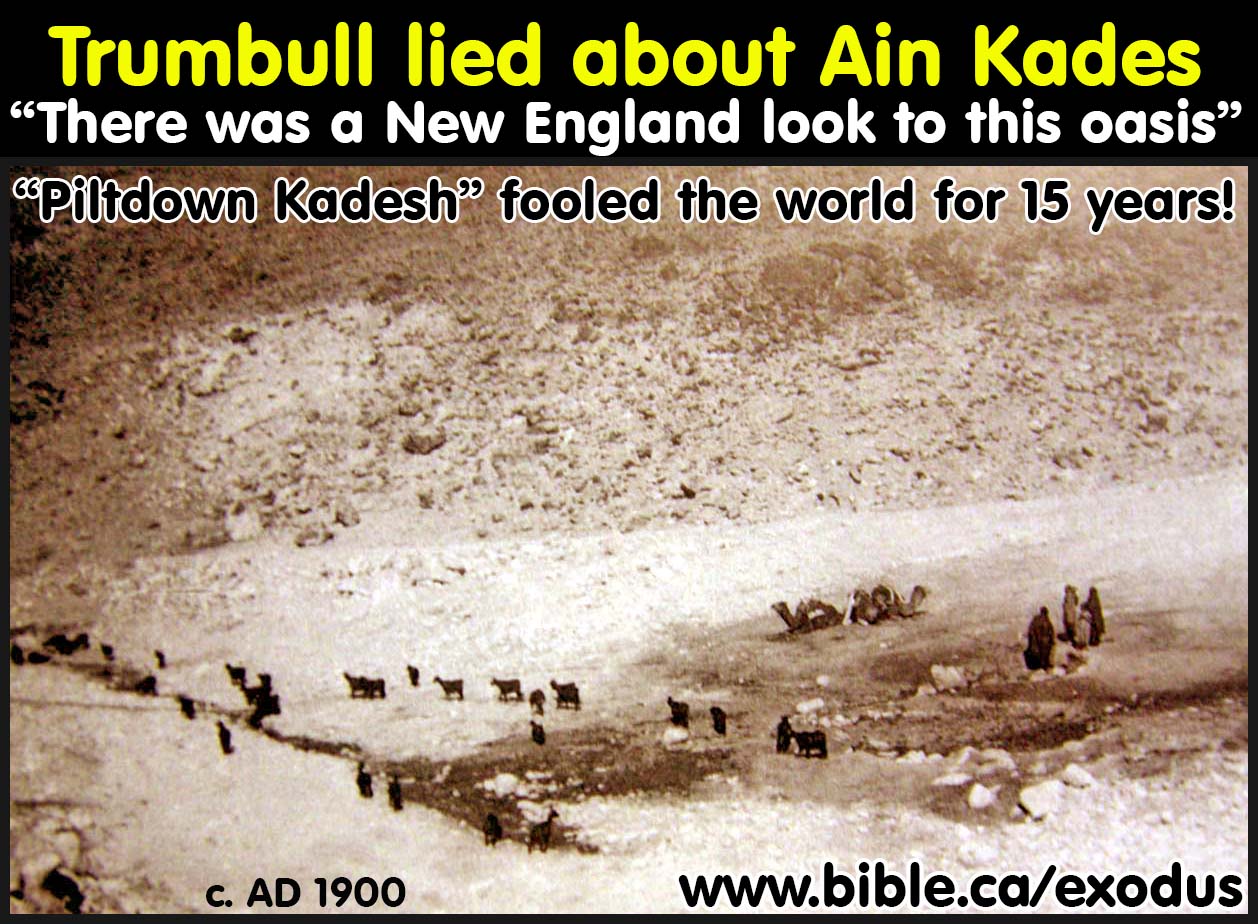
- In 1914 AD Leonard Woolley and T. E. Lawrence visited Kades and commented on the deception of Trumbull: "Mr. H. C. Trumbull, an American, spent a single hour at the spring in 1882, and wrote round his visit a very large book. with fantastic descriptions of the valley ... As a general comment we can only say that this account is as minutely accurate in its measurements as it is inaccurate in its descriptive matter. The valley of Ain Kadeis is unusually naked, even among the valleys of the south country. " (The Wilderness of Zin, C. Leonard Woolley and T. E. Lawrence, CH IV, Ain Kadeis And Kossaima, 1914-1915 AD)
- Woolley and Lawrence published their book in 1916 AD in which they chose Ein El-Qudeirat as Kadesh Barnea, and the entire world jumped on board with them. The new location for Kadesh was about 10 km north at Ein el-Qudeirat. Qudeirat has been the almost undisputed location for Kadesh Barnea from 1916 to the present time. However Qudeirat simply cannot be Kadesh Barnea for a long list of reasons discussed below.
4. Ron Wyatt and Bob Cornuke 1982 AD: Unicorn archeology for Lawz and the Red sea crossing point at the Nuweiba Beach on Gulf of Aqaba
- Wyatt and Cornuke have had a great impact on rethinking the exodus route but have done more damage than good.
- Professional archeologists cringe at the sham archeology of Cornuke and Wyatt, complete with their 18th dynasty chariot wheels, pillars of Solomon, split rock for water and the altar of Moses etc. in support for Mt. Lawz as being Mt. Sinai in northern Saudi Arabia.
- Equipped with a camera and a wild imagination they
present false proof that Lawz is Sinai. Equipped with a Walmart
fish-finder they document the crossing of the Red Sea at the Nuweiba
Beach, complete with those famous non-existent "chariot wheels"
which were nothing more than random coral patches. I have personally
stood on the Nuweiba Beach and scuba divan nearby in the Gulf of Aqaba
and the sharp drop. You can fit the CN Tower in the continental rift at
the Nuweiba
Beach crossing point. I have examined and rejected every bit of
Cornuke and Wyatt's archeological proof of their entire "exodus
route". All of it must be rejected until it is professionally
excavated and examined. Much of it is clearly false information that can
be rejected even without examination.


- In 1978, when Wyatt chose Lawz as Mt. Sinai, followed up with Cornuke in 1982, with their sensationalistic and outrageous "unicorn archeology" they were rightly ignored as fame and fortune charlatans.
- The problem is, that they got one thing right: Mt. Sinai is located in Saudi Arabia and Lawz is the best candidate mountain for Sinai we have.
- I am a firm proponent of Mt. Sinai being located in Saudi Arabia. While I view Lawz as Mt. Sinai, as an archeologist, I have zero archeological evidence to substantiate this. Josephus says that Sinai was the highest mountain in the region and for that reason alone I have chosen Lawz. But one thing is clear: Mt. Sinai MUST be in Saudi Arabia which forces a Red Sea crossing only one possible location: Straits of Tiran.
- Gordon Franz 2005 AD: Mt. Sinai is ANYWHERE but Saudi Arabia
a. In a knee jerk reaction against Wyatt's and Cornuke's "unicorn archeological proofs" of their exodus route, Franz rightly came out swinging and exposed the two for the charlatans that they are. Indeed, Wyatt's and Cornuke's Red Sea crossing is ridiculous and impossible and they basically ignored locating Kadesh Barnea altogether. Everyone jumped on board with Franz and threw the baby out with the unicorn bathwater. But even a blind squirrel finds a nut once in a while because Wyatt's and Cornuke's choice of Mt. Saini was correct.
b. For the last 15 years, Gordon Franz has been the "authority" appealed to by almost everyone as the "expert" that Mt. Sinai CANNOT be in Saudi Arabia. Like Henry Clay Trumbull in 1881 AD, Franz has had a 15 year unopposed campaign at misleading the world away from the actual exodus route. Unlike Trumbull, Gordon Franz is presenting information he truly believes to be correct without any intention for deception. Indeed, he truly believes he is right where as Trumbull went to bed knowing he was a liar and deceiver. Franz is honourably wrong but the deceptive effect of his "sincere misinformation" is the same as Trumbull's.
c. Franz spends the bulk of his time saying where Mt. Sinai CANNOT be and very little constructive analysis of a workable exodus route. The fact his exodus route map route doesn't even go through Ezion Geber between Sinai and Kadesh is an example of his overall sloppiness and lack of understanding of the broader subject. Franz goes to great lengths to define Arabia as pretty much everywhere including the Nile Delta which essentially makes Paul's locative that "Mt. Sinai in Arabia" utterly irrelevant and useless in the search for Mt. Ararat.
d. In separate conversations with several highly credentialed archeologists, I was shocked that they all referred me to Franz as the "go to man" for proof that Mt. Sinai cannot be in Saudi Arabia. It is clear that their confidence in Franz is only exceeded by their paranoia of any association with Ron Wyatt himself or locating Mt. Sinai in Saudi Arabia. This dismissive attitude among professional archeologists in considering Mt. Sinai in Saudi Arabia is as superficial as it is unfortunate.
e. In churches, there is also a general lack of interest in the subject which compounds church leader's misplaced trust they have in Franz's shoddy research conclusions. To them, Franz talks a lot and sounds right and with the general trust of professional archeologists In Franz, the subject is closed.
f. It is important to separate "Wyatt's unicorn archeology for Lawz" with his correct choice of Lawz itself. Refuting Wyatt does not refute Mt. Sinai in Saudi Arabia. Just because Wyatt’s evidences are invalid, does not necessarily mean that there are no valid arguments in favor of identifying Jebel el-Lawz as Mt. Sinai.
- David Rohl & Patterns of Evidence: 2014 AD. Making mush of Bible and Egyptian chronology:
- In his book, "Pharaohs and Kings: A Biblical Quest" (1995 AD), Rohl shifts Egyptian chronology 200 year or more breaking important synchronistic links between the Bible and known archeology.
- Rohl is an agnostic and while some Christians find an affinity for him because he correctly proposes an Exodus around 1446 BC, he slashes and burns everything else about Bible chronology.
- For example, Ramesses II (1250 BC) become Shishak who destroyed Jerusalem in 925 BC. With the Rohl chronology, the Amarna period is contemporary with the David and so on.
- Rohl locates Kadesh Barnea at Mt. Karkom is absurd, since it 35 km east of the Wadi el-Arish, the border between Israel and Egypt. Israel didn't spend 38 years inside the tribal allotment of Simeon and Judea! But this doesn't bother the agnostic Rohl one bit! "The archaeologist who has been overseeing an archaeological survey of the site, Professor Emmanuel Anati, believes it to have been the mountain of the Ten Commandments (i.e. Mount Horeb). He is wrong in this assumption, but he has indeed found one of the most important places in the Exodus story. for this is the true site of Kadesh Barnea the holy gathering place where the multitude of Israel prepared to enter the Promised I and where they commemorated their covenant with Yahweh for the first time on top of the sacred mountain." (The Lost Testament, David Rohl, p223, 2002 AD)
- "The Philistines are scarcely mentioned by Rohl. And for good reason - they utterly destroy his reconstruction. According to the revised chronology, the United Monarchy corresponds to the LB IIA period. The first two kings of the United Monarchy, Saul and David, were very much involved with fighting against the Philistines. But the Philistines did not arrive in Canaan until the reign of Ramesses III at the beginning of the Iron Age (Wood 1991), ca. 800 B.C. by Rohl's reckoning. So we are left with a situation where Saul and David are fighting an enemy who does not appear in the historical or archaeological record until 300 years later!" (David Rohl's Revised Egyptian Chronology: A View From Palestine. Dr. Bryant Wood, 2007 AD)
- In spite of all this, a new group of Rohlite choir boys (Tim Mahoney, Steve Law) are singing his tune with a new series of documentary movies. "Pattern's of Evidence: Exodus" (2014 AD), for example presents Rohl's wild theories as the "hero solution" to all Bible/Archeological problems, if those pesky Christian archeologists would just realize they are wrong and Rohl is right. In fact the movie actually blames Christians at its climax for finding the solution to the problem. In fact, there is no problem between the Bible and archeology for Christian archeologists. Mahoney and Law are preparing a new movie "Pattern's of Evidence: Kadesh Barnea" on locating Kadesh Barnea at Mt. Karkom. You guessed it! Exactly where David Rohl thinks it is. The sensationalism of the movie series smacks of "Wyattism" money making under the pretense of bible fundamentalism. In fact, Rohl's theories destroy the already well established confirmations of Archeology and the Bible. While the Pattern's of Evidence movie series leaves uninformed Christian audiences in shock and awe the same way Chariots of the Gods (Erich von Däniken, 1970 AD) did, informed Bible scholars and Biblical archeologists walk away in shock and horror.
|
I have been to Mt. Karkom three times and while the archeology is fascinating, it cannot be either Mt. Sinai or Kadesh Barnea without gutting the inspiration of the Bible.
Avoid Rohl and his new voice in the "Pattern's of Evidence" movie series. |
|
Main Exhibit Keys that Unlocking the Exodus Route |
|
|
|
|
|
|
KEY#1 The Exodus was a Miracle: (Ex 13:21; Deut 8:4; 29:5; Neh 9:21) Can God prepare a table in the wilderness? Ps 78:19 |
- The exodus was a miracle: Israel traveled 24 hours a day, day and night and their feet didn’t swell, never stumbled, cloths and shoes never wore out, miraculous food and water supply through manna quail. The cloud sheltered them from sun and rain and the pillar of fire gave them light at night.
- "The Lord went in front of them in a pillar of cloud by day, to lead them along the way, and in a pillar of fire by night, to give them light, so that they might travel by day and by night." (Exodus 13:21)
- "The clothes on your back did not wear out and your feet did not swell these forty years." (Deuteronomy 8:4)
- "I have led you forty years in the wilderness. The clothes on your back have not worn out, and the sandals on your feet have not worn out;" (Deuteronomy 29:5)
- "They asked, and He brought quail, And satisfied them with the bread of heaven. He opened the rock and water flowed out; It ran in the dry places like a river. " Psalm 105:37-41
- "Forty years you sustained them in the wilderness so that they lacked nothing; their clothes did not wear out and their feet did not swell." (Nehemiah 9:21)
- "When the Lord has washed away the filth of the daughters of Zion and purged the bloodshed of Jerusalem from her midst, by the spirit of judgment and the spirit of burning, then the Lord will create over the whole area of Mount Zion and over her assemblies a cloud by day, even smoke, and the brightness of a flaming fire by night; for over all the glory will be a canopy. There will be a shelter to give shade from the heat by day, and refuge and protection from the storm and the rain." Isaiah 4:4-6
- Echoing the exodus, Jeremiah says in 595 BC that at the end of the 70 year Babylonian captivity (which began in 605 BC), none who leave bondage for the promised land will stumble!. "Behold, I am bringing them from the north country, And I will gather them from the remote parts of the earth, Among them the blind and the lame, The woman with child and she who is in labor with child, together; A great company, they will return here. “With weeping they will come, And by supplication I will lead them; I will make them walk by streams of waters, On a straight path in which they will not stumble; For I am a father to Israel, And Ephraim is My firstborn.”" (Jeremiah 31:8–9)
- "Then He brought them out with silver and gold, And among His tribes there was not one who stumbled. Egypt was glad when they departed, For the dread of them had fallen upon them. He spread a cloud for a covering, And fire to illumine by night. They asked, and He brought quail, And satisfied them with the bread of heaven. He opened the rock and water flowed out; It ran in the dry places like a river. " Psalm 105:37-41
- "Then He brought them out with silver and gold, And among His tribes there was not one who stumbled." (Psalm 105:37)
- "Then they remembered the days of old, of Moses his servant. Where is the one who brought them up out of the sea with the shepherds of his flock? Where is the one who put within them his holy spirit, who caused his glorious arm to march at the right hand of Moses, who divided the waters before them to make for himself an everlasting name, who led them through the depths? Like a horse in the desert, they did not stumble. Like cattle that go down into the valley, the spirit of the Lord gave them rest. Thus you led your people, to make for yourself a glorious name." (Isaiah 63:11–14)
|
"Like a horse in the desert, they did not stumble as they crossed the Red Sea" Isa 63:13; Ps 105:37; Jer 31:9
Steve Rudd, Randall Price, Don Patton, ride mountain horses to the 4200 m. camp on Mt. Ararat during the 2012 Expedition to find Noah's Ark.
Ararat mountain horses are small but are able to scale the 45 degree incline of Ararat without slipping. It was terrifying at times, but the horse never stumbled once. This is what Isa 63:13 means that God will provide! |
- They were given supernatural help travelling long distances so their feet did not swell and when crossing the Red Sea, none of the elderly tripped or fell down.
- The Exodus Highway is a flat coastal that is 20 km wide and runs
the full length of the 490 km journey from Goshen to the Straits of
Tiran. This coastal plain slowly rises from sea level to the eastern
mountains at 250 meters above sea level. Travel would be fast and easy.
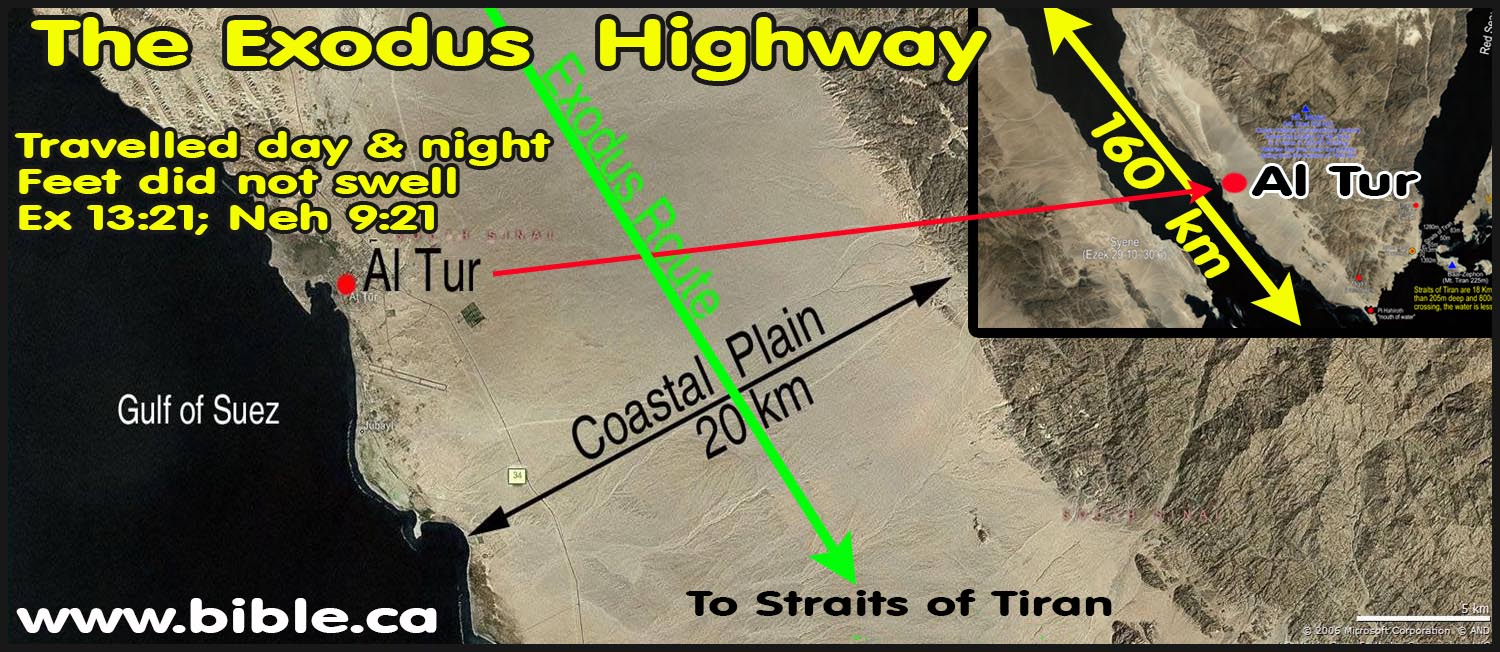
- "Then His people remembered the days of old, of Moses. Where is He who brought them up out of the sea with the shepherds of His flock? Where is He who put His Holy Spirit in the midst of them, Who caused His glorious arm to go at the right hand of Moses, Who divided the waters before them to make for Himself an everlasting name, Who led them through the depths? Like the horse in the wilderness, they did not stumble; As the cattle which go down into the valley, The Spirit of the Lord gave them rest. So You led Your people, To make for Yourself a glorious name." (Isaiah 63:11–14)
- “Indeed, forty years You provided for them in the wilderness and they were not in want; Their clothes did not wear out, nor did their feet swell." (Nehemiah 9:21)
- One of the biggest errors in determining the exodus route is in calculating distances and travel times.
- ERROR 1: "The three day journey to reach the Red Sea crossing point": Since there are three stops between Goshen and the Red sea crossing point, it is wrongly concluded they only travelled three days. This seems like a solid conclusion given the fact that Moses asked Pharaoh to all Israel to make a three day journey to sacrifice to YHWH (Exodus 3:18). Notice however, this was all Moses knew at the time. Even while standing on the shore of the Red Sea, Moses had no idea that God would part the waters until God told him. And three days to what? Red Sea crossing? Mt. Sinai? So reject the idea that a three days journey is any help in determining the location of the Red Sea crossing point.
- ERROR 2: "A group of three million could not move more than 15 km per day." It is amusing how much effort is put into determining the number of kilometers per day the exodus Hebrews could travel, pharaoh's army could travel, a caravan could travel etc. All this calculation is nullified by the fact that Israel travelled day and night with supernatural help. It shocks me that good bible students ignore this in their travel calculations. As for Pharaoh, he would travel by boat from the sea port at the north end of the Gulf of Suez down to the Straits of Tiran quickly. His army would follow on the 20 km wide highway that flanks the entire eastern shore of the Gulf of Suez. When Israel was trapped by the mountains at Etham, the overlooking Egyptian Migdol would send word by passenger pigeon which would arrive in Cairo in 5 hours. This would mean that Pharaoh's army would travel the 490 km from Goshen to the Straits of Tiran in 8 days moving at an easy and slow rate of 62 km per day. (about 37 miles per day). The army and supplies were probably loaded on a fleet of large ships that made the 490 km trip in 3 days! The Straits of Tiran are no problem for the true Exodus route!
- Philo describes a long and difficult journey from Goshen to the Red Sea.
- "having accomplished together a long and desolate journey through the wilderness, destitute of any beaten road, at last arrived at the sea which is called the Red Sea." (Philo, On the Life of Moses, 2:246)
- This essentially guts the idea that they would travel such a short distance to cross at the Ballah, Timsah, Bitter lakes, or the Gulf of Suez.
- Why would I Israel even cross through these small lakes, they would simply go around.
- The total journey took 45 days. Israel crossed the Red sea
on day 25 after which the Bible narrative starts counting 15 days till
they reach Sinai on day 45. Those who propose a Red Sea crossing at
Ballah, Timsah, Bitter lakes, or the Gulf of Suez fail to realize these
were the weekend fishing holes and vacation spots of the Hebrews in while
they lived in Goshen.
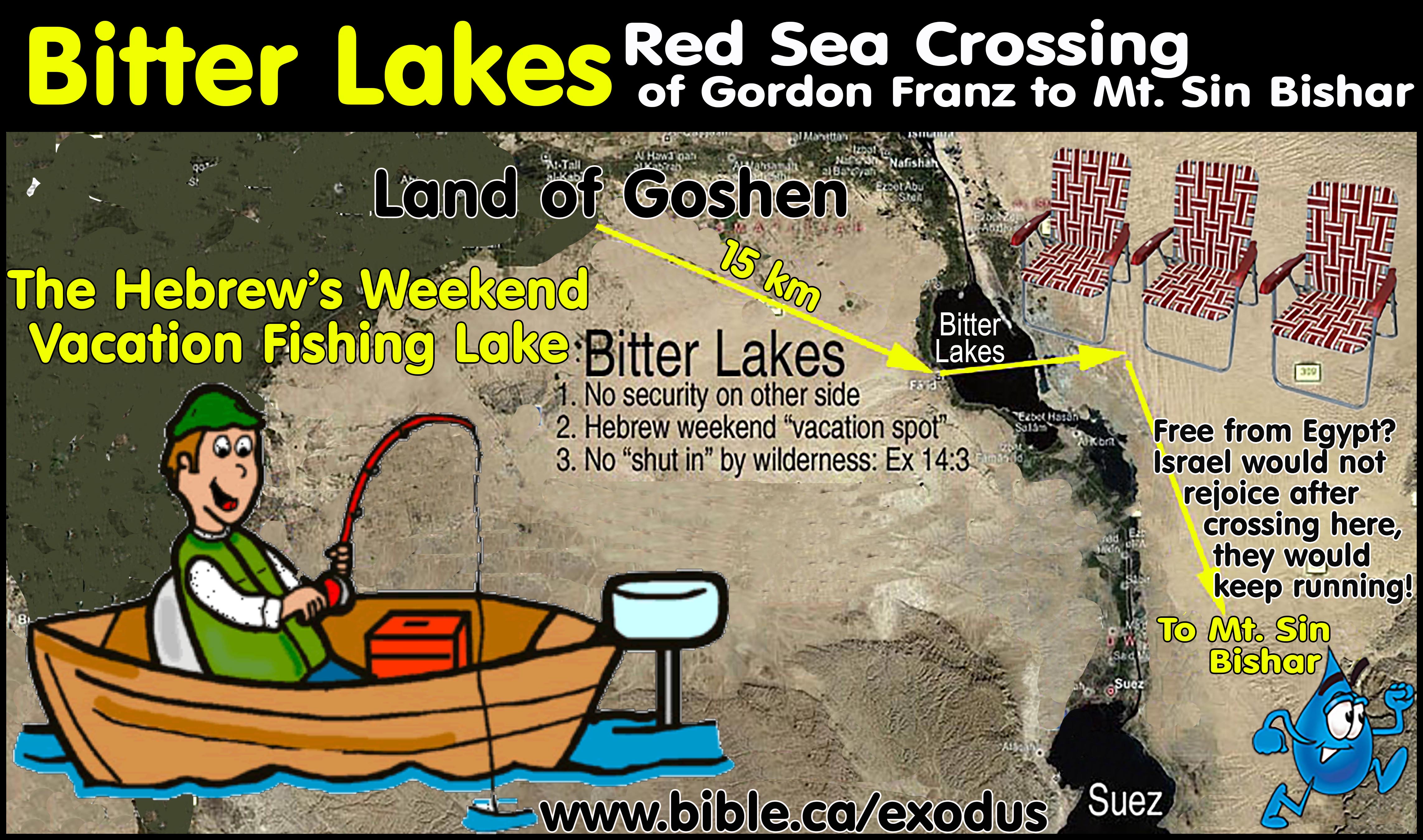
- Franz's "7 day challenge" to walk from Goshen to the Straits of Tiran is ill informed given Israel crossed on day 25 after travelled day and night. More details: Travel times, distances, days of the week
|
Trip |
Distance |
Total days |
Camp days |
Travel days |
Daily rate of travel |
|
Goshen to Red Sea |
490 km |
25 |
8 |
17 |
29 km/day |
|
Red Sea to Sinai |
260 km |
20 |
9 |
11 |
23 km/day |
|
Goshen to Sinai |
750 km |
45 |
17 |
28 |
27 km/day |
|
"The Lord was going before them in a pillar of cloud by day to lead them on the way, and in a pillar of fire by night to give them light, that they might travel by day and by night." (Exodus 13:21) |
|||||
|
|
|
|
|
KEY#2 The Etham Dilemma: "The Great Backtrack when they hit THE WALL" Only the Straits of Tiran fit the geography of Exodus 14:2-3 |
"Tell the sons of Israel to turn back and camp before Pi-hahiroth, between Migdol and the sea; you shall camp in front of Baal-zephon, opposite it, by the sea. “For Pharaoh will say of the sons of Israel, ‘They are wandering aimlessly in the land; the wilderness has shut them in." (Exodus 14:2-3)
- When Israel reached Etham, they hit a huge impassable mountain range.
a. Etham may be derived from Egyptian word for wall/fortification. Hb. šûr = “wall” and Egyptian htm = “wall, fortress”. "Etham is simply Egyptian for Hebrew Shur, both meaning “wall, fortification.”." (The JPS Torah Commentary: Numbers 33:8, 1999 AD)
b. The mountains they hit were known as "THE WALL" or THE ETHAM.
- God told them "now turn back" (backtrack and retrace their steps) and camp at what would be the crossing point of the Red Sea.
- This is how God "baited" Pharaoh to say, "They are wandering aimlessly in the land; the wilderness has shut them in". No
- No other crossing point can satisfy the "Etham Dilemma" where they pass the final camping spot and stop at Etham because of the mountains, then backtrack to the camp where they will cross the Red Sea. Only the Straits of Tiran make Etham work!
- Red Sea crossing points at Ballah, Timsah, Bitter lakes, Suez or the Nuweiba beech fail to meet the Bible requirement and for them, the Etham backtrack is a huge Dilemma. Etham is one of the most interesting and most important locations for determining the exodus route and the crossing of the Red Sea.
- This essentially guts the idea that they would travel such a short distance to cross at the Ballah, Timsah, Bitter lakes, or the Gulf of Suez. Why would I Israel even cross through these small lakes, they would simply go around because NOTHING was "trapping them". Its simple details like these that most miss when considering the Red Sea crossing point.
- Philo also records that Israel was "enclosed like a shoal of fish" and trapped at Etham by the geography.
- "and not being able to escape, for behind was the sea, and in front was the enemy, and on each side a vast and pathless wilderness" (Philo, On the Life of Moses, 1:165-171)
- " the prophet saw that the whole nation was now enclosed like a shoal of fish" (Philo Moses II 250)
- All other proposes crossing points except for the Strait of Tiran have no geographical way of "TRAPPING" Israel. In other words, crossing points at Ballah, Timsah, Bitter lakes, Suez or the Nuweiba beech fail to trap Isael at Etham, then backtrack and camp at the crossing point while waiting for Pharaoh to arrive.
3. There are a number of ways of viewing the Wilderness of Etham:
c. It may be derived from Egyptian word for wall/fortification. Hb. šûr = “wall” and Egyptian htm = “wall, fortress”. "wilderness of Etham Although identified as Shur in Exodus 15:22, this need not imply two versions. Etham is simply Egyptian for Hebrew Shur, both meaning “wall, fortification.”" (The JPS Torah Commentary: Numbers 33:8, 1999 AD) After crossing the Red Sea, they went three days into is the wilderness of Shur. Therefore, the Wilderness of Etham is identical to the Wilderness of Shur.
a. It may be a textual gloss: Etham is not found in the Septuagint (LXX) in Number 33:8. The "Wilderness of Etham" may not exist. It is only found in one passage: Num 33:8. Etham is not in the LXX at Num 33:8. Instead, the Septuagint has the word, "they" which is spelled almost the same, with the vowels removed. Perhaps the Masoretes erred when they added the vowels. Many commentators completely ignore it in Num 33:8.
b. It may simply mean there is a place called Etham on both sides of the Gulf of Aqaba at the straits of Tiran.
c. Perhaps the Straits of Tiran were viewed as a "wall" from both sides. On either side there was no place to go but back or cross to the other side. It was a dead end on both sides!
- The 650 km journey from Goshen to Sinai took 44 days.
- The exodus was a miracle and Israel traveled 24 hours a day, day and night (Exodus 13:21). God gave young and old supernatural help so that they NEVER stumbled: Isaiah 63:12–14; Psalm 105:37.
- The 400 km trip from Goshen (Tel El-Daba) to the Straits of Tiran is a flat 18 km wide packed sand terrain and is absolutely perfect for travel with no ups and downs. A virtual highway! I have also PERSONALLY travelled it and have photos of how perfect it is for easy quick travel. But this path ends with an abrupt mount range just past Tiran at Etham. God told them to stop, turn back, retrace their steps and camp at the crossing point of the Red Sea under the Egyptian Migdol watchtower located at the tri-intersection water way. (Ex 14:2, Num 33:7)
- They arrived on day 17 at the Straits of Tiran.
- Israel crossed the Red sea at the Straits of Tiran on day 25 after which the Bible narrative starts counting 20 days till they reach Sinai on day 45.
- Word was sent via passenger pigeon from the overlooking Migdol in 5 hours to Pharaoh who said: "They are wandering aimlessly in the land; the wilderness has shut them in." The Egyptian Migdol (literally watchtower) at the triple junction forks of the Red Sea was one of the most important and they would clearly report the exact movements of Israel. Ex 14:3. Israel camped 8 days as Pharaoh raced by chariot to the scene down the sandy Egyptian highway and arrived at Tiran on day 25 giving plenty of time for the stragglers to reach the camp. After crossing at Tiran they spent 20 days getting to Sinai on day 45, which includes 8 days camping at Sin to learn the Sabbath cycle.
|
The Etham dilemma is utterly ignored since all other proposed Red Sea crossings provides no block, stop, retrace and camp at the crossing point. The very idea that Israel was outside Egypt's control after crossing at the Bitter Lakes (the Hebrew's weekend fishing vacation spot while they lived in Goshen) or the major Egyptian seaport on the north shore of the Gulf of Suez (I would not rejoice after crossing, I would keep running) is unconscionable. In fact, the Straits of Tiran provide the only workable geography to solve the Etham dilemma. After crossing at Tiran into Saudi Arabia, they were truly "out of Egyptian control". Only then did thy rejoice in the wilderness of Shur, the historic homeland of Ishmael and Jethro of Midian.
|
- Only the Straits of Tiran are workable, given they came to Etham, stopped when they hit the mountain range, and then retraced their steps to camp at the crossing point in wait for the Egyptians to arrive.
- And if I just crossed the "Red Sea" at the Ballah, Timsah or bitter lakes or the north end of the Gulf of Suez, I would not rejoice, I would keep running to escape the Egyptians!
- Only a crossing at the gulf of Aqaba works and only the Straits of Tiran fit the "Etham backtrack" narrative.
- Notice that 90% of the crossing distance is very shallow and that one short section (about 2 km) was 205 meters deep.
- This is where God supernaturally assisted the Hebrews "Like the horse in the wilderness, they did not stumble" (Isaiah 63:11–14) and where Pharaoh's army drowned as he watched safely on the shore.
- Pharaoh survived the Red Sea:
Remember, the Bible nowhere says that Pharaoh (Thutmoses III) drowned in
the Red Sea: "But He overthrew [literally: shook off not drowned or
killed] Pharaoh and his army in the Red Sea, For His lovingkindness is
everlasting." (Psalm 136:15)
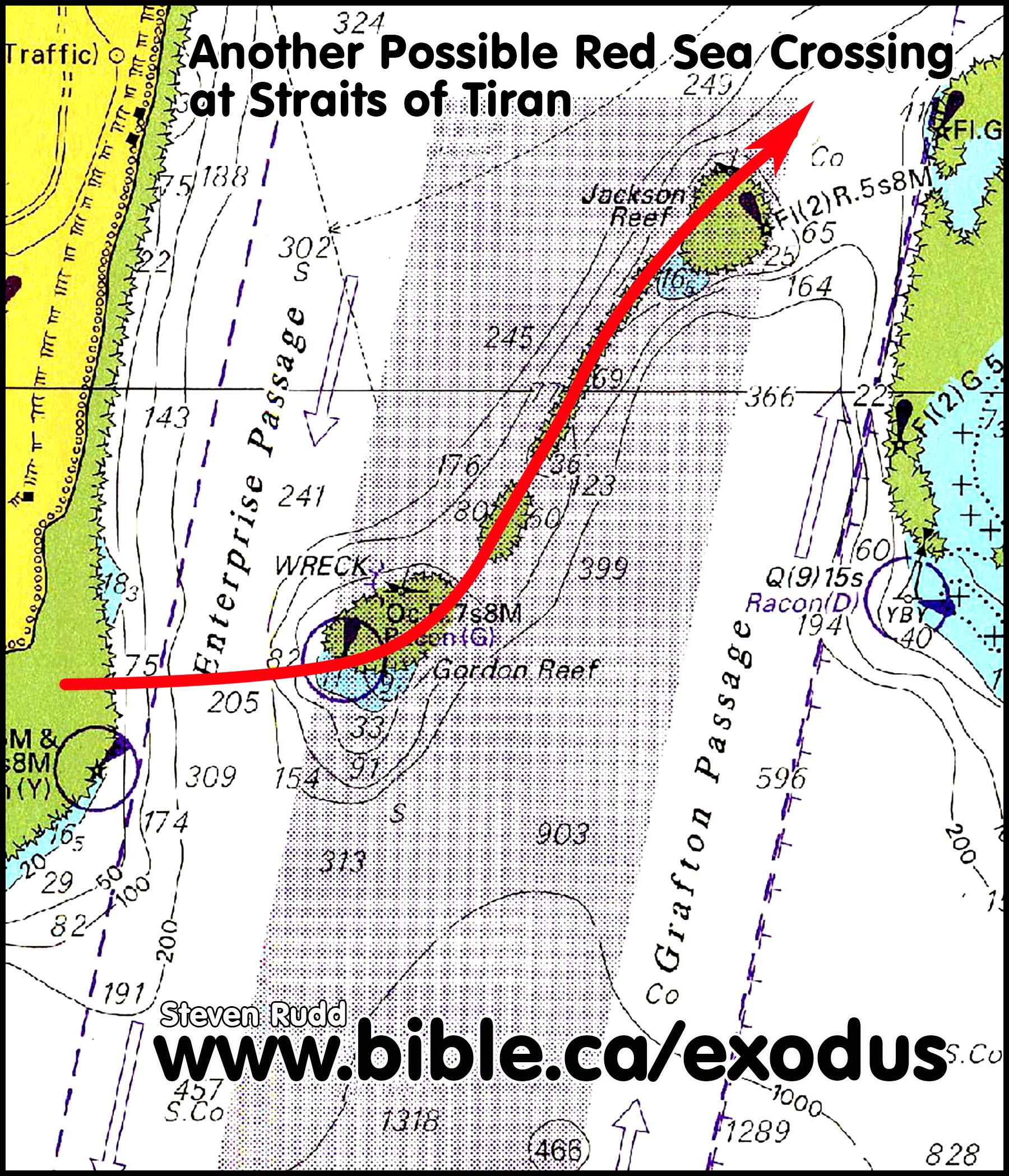
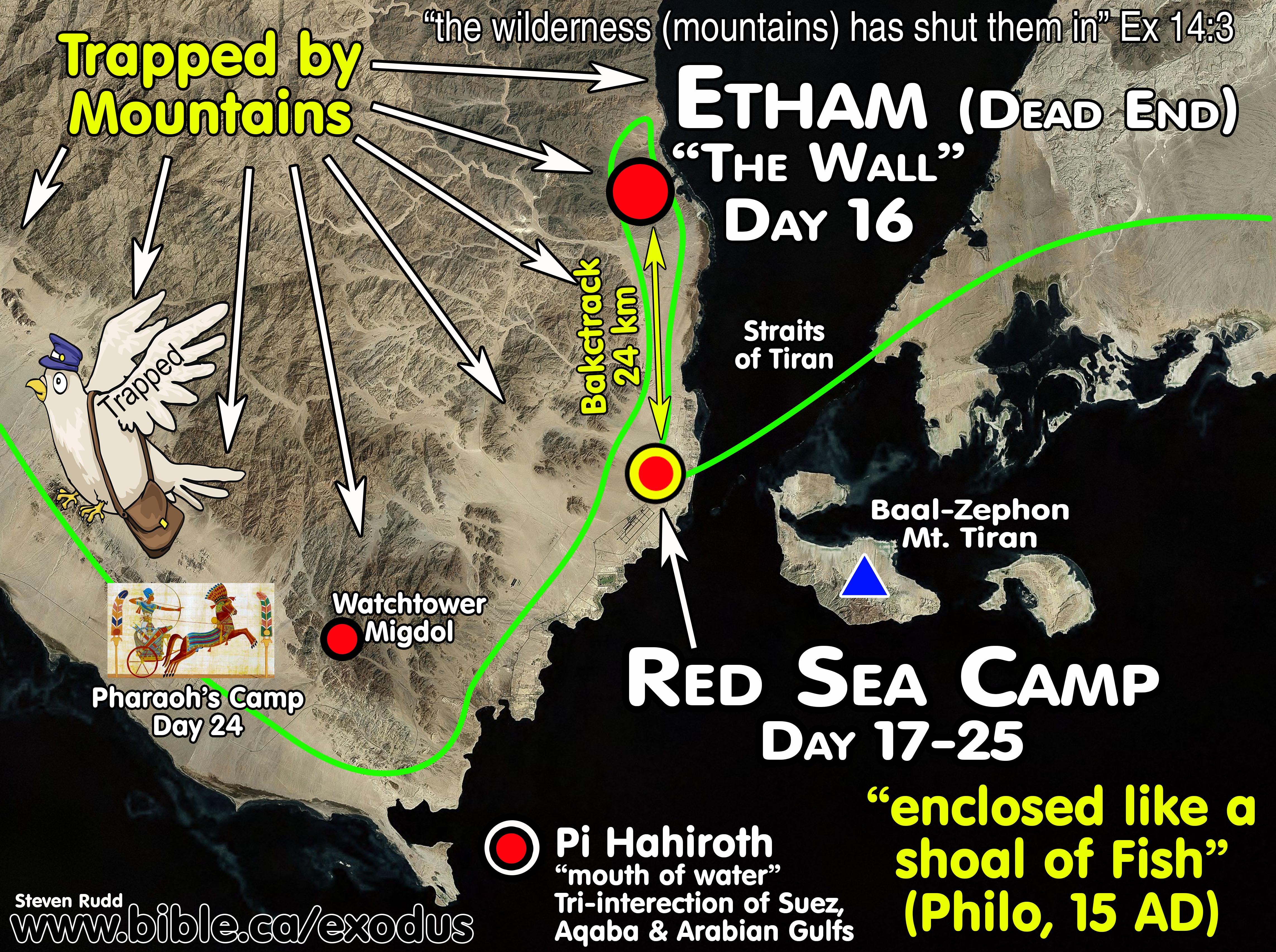
|
|
|
|
|
KEY#3 The second Red Sea camp |
- The body of water that is the RED SEA, must be large enough to facilitate first a crossing, then the second camp after crossing. Only a crossing at the Straits of Tiran allows for a workable second Red Sea camp.
- The itinerary is as follows:
- Three days in the wilderness of Shur (Midian) to reach Marah
- Elim: day 4
- Second red sea camp: day 5: "They journeyed from Elim and camped by the Red Sea. They journeyed from the Red Sea and camped in the wilderness of Sin." (Numbers 33:10–11)
- Wilderness of Sin
- The second Red Sea camp is a huge problem for all who propose a Red Sea crossing at Ballah, Timsah or Bitter lakes. Most of the time their maps simply ignore it altogether in ignorant bliss.
- Red Sea NOT Sea of Reeds. Those who say the Red Sea crossing was at the freshwater lakes of Ballah Lake, Timsah Lake or the Bitter lakes always insist that "Red Sea" = "freshwater sea of reeds".
- They always go into a long study of the Hebrew original. Although the same word "suph" (Red) is used of a freshwater "reeds/plants" in Exodus 2:3 and Isaiah 19:6, we can be certain that Ezion-Geber was on the SALTY Red Sea near Elat in the Territory of Edom: "King Solomon also built a fleet of ships in Ezion-geber, which is near Eloth on the shore of the Red [suph] Sea, in the land of Edom." (1 Kings 9:26)
- No ancient historian ever called the Ballah, Timsah or Bitter lakes the Red Sea and referring to them as the SEA REEDS is a modern fiction to support wrong and failing exodus route.
- Herodotus used the Greek word for RED in describing the Red sea: "there is a gulf extending inland from the sea called Red" (Herodotus, Hist. 2.11.1)
- When pressed for a second Red Sea camp, they will then chose the SALTY Gulf of Suez as the second RED SEA camp.
- Did you catch that? After arguing vociferously that Red Sea means "sea of reeds" saying, "ITS IN THE HEBREW and is a freshwater lake!!!" they place the second Red sea camp on the Gulf of Suez.
- Since the Red Sea is a large salty ocean body of water, we only have two choices: The Straits of Tiran and the north Gulf of Suez crossing.
- The Suez crossing is even a bigger joke because it was the location of a major shipping port for Egypt.
- The Egyptians would sit on lawn chairs waiting for Israel to come to them while sipping on an organic latte made from real GMO free goat milk!
- The high hills would allow the Egyptians to see the entire path of the Red Sea crossing and simply go around to the other side, which is faster and easier than going through the ocean.
- To suggest they were free from Egyptian military control after crossing is absurd.
- Israel would not rejoice if this was the crossing point,
THEY WOULD KEEP RUNNING.
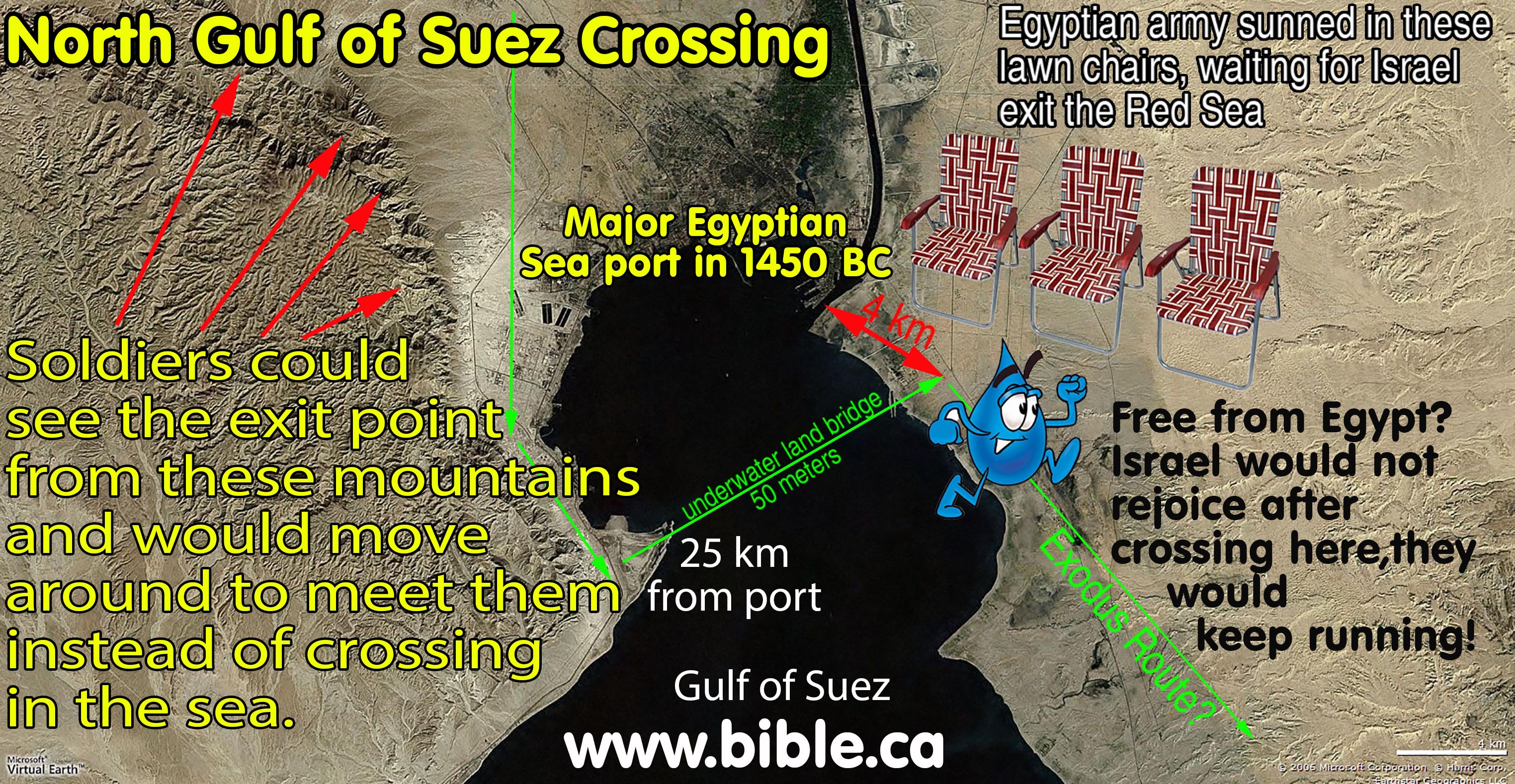
|
|
|
|
|
KEY#4 "Journey in stages" though mountains and difficult terrain: Ex 17:1 |
- Bible texts:
- "Then all the congregation of the sons of Israel journeyed by stages from the wilderness of Sin, according to the command of the Lord, and camped at Rephidim, and there was no water for the people to drink." Exodus 17:1
- "They journeyed from the wilderness of Sin and camped at Dophkah. They journeyed from Dophkah and camped at Alush." Numbers 33:12-13
- Another synchronism I discovered in my research on the exodus route is the fact that between the Wilderness of Sin and Rephidim (Meribah) they "journeyed in stages" in only two legs of the journey from the Wilderness of Sin to Dophkah to Alush to Rephidim.
- This ignored synchronism of "Journey in stages" though mountains and difficult terrain by all others actually is a perfect fit for the Bible exodus route as I have proposed.
- If you check my exodus route map, this is the only time in the entire journey they passed through mountains AND therefore the narrative indicates they had to journey in stages of smaller groups, as opposed to moving as a mass group of 3 million.
- See my exodus route for the stunning synchronism of geography, bible timing/distance after a Red Sea crossing at the Straits of Tiran)
- Little is known about Alush or Dophkah except that they are obviously located in difficult terrain that required moving in stages. Alush or Dophkah are both staging locations between the wilderness of Sin and Rephidim.
- They had to travel in stages, because the entire population was unable to move together at the same time.
- So Moses must have divided up the group and sent them "caravan style" in staggered groups.
- Another synchronism is that the Amalekites attacked when the first group completed the states, exited the mountainous area as they started their way to Rephedim: Exodus 17:7-8
- The Amalekites attacked the first group, who was also short of water before the entire population arrived.
- Something so simple as "journeyed by stages" has been missed by everyone but it is a key to unlocking the exodus route. Any proposed route that cannot account for mountainous or difficult terrain during this section of the journey must be rejected.
|
They Journeyed by stages between the Wilderness of Sin and Rephidim: Ex 17:1 |
|||
|
Location |
Terrain expected from Bible narrative |
Terrain encountered from Tiran to Mt. Lawz near Midian |
Terrain encountered from Ballah to Mt. Sin Bisher |
|
between Red Sea camp and Wilderness of Sin |
Easy |
Easy |
Easy |
|
between Wilderness of Sin and Dophkah |
Difficult and narrow |
Difficult and narrow |
Easy |
|
Difficult and narrow |
Difficult and narrow |
Easy |
|
|
Difficult and narrow |
Difficult and narrow |
Easy |
|
|
between Rephidim and Wilderness of Sinai |
Easy |
Easy |
Easy |
|
Assessment |
|
|
|
|
|
|
|
|
KEY#5 Edom's territory was Transjordan from 1446 - 605 BC This forces Kadesh Transjordan at Petra Most bible maps today wrongly locate Kadesh at Ein Qudeirat |
- Kadesh Barnea is located on the border of Edom and archeologically, it is rather simple to prove that Edom was Transjordan during the exodus in 1446 BC.
- Kadesh Barnea located at Petra is on the historic border of Edom!
- Kadesh Barnea located Ein Qudeirat is impossible because it is 80km west of the Transjordan border of Edom.
- Edom never ventured out of her Transjordan territory until after the attack of Nebuchadnezzar in 605 BC as seen in the Arad Ostraca and Obadiah, Ps 137 etc.
- The Arad ostraca document the first historic incursion of Edom into the territory of Judah after 605 BC
- Kadesh is on the border of Edom with a Transjordan location. Edom never ventured west of the Arabah valley into Judah/Simeon territory until after the first attack by Nebuchadnezzar 605 BC. Qudeirat as Kadesh Barnea is impossible because it is 80 km west of the border of Edom in 1446 BC.
- Learn more about Arad Ostraca .
- Learn more about the history
of Edom.

- The map below on the left is the archeologically and historically correct border of Edom: 1446-605 BC. The map on the right is the "Revisionists Map of Errors" all because they put Kadesh Barnea in the wrong place deep inside the Promised Land:
- Some archaeologists modify the record of the biblical text and archeology of the territory of Edom in a Finkelsteinly manner.
- These revisionists have shockingly moved Edom's Territory 80 km west inside the Promised Land at the time of the Exodus and conquest. Take note that Edom was not one of the nations Joshua fought.
- The revisionists move southern border of Judah 100 km north, ignoring the fact that the southern border of the promised land is Wadi El-Arish.
- The revisionists move the Wilderness of Paran and Wilderness of Zin from their correct Transjordan to INSIDE THE PROMISED LAND given to the tribe of Judah and Simeon. Paran and Zin are clearly not inside Judean lands.
- Perhaps these revisionists might consider moving Kadesh Barnea out of the promised land back to its actual Transjordan location at Petra.
|
Archeologically and historically correct border of Edom: 1446-605 BC |
"Map of Errors" used by revisionists who locate Kadesh at Ein Qudeirat |
|
|
|
|
|
KEY#6 Sinai Peninsula is
Egyptian territory in 1446 BC The River of Egypt is the border between Egypt and Israel |
- Sinai Peninsula=Wilderness of Egypt:
- See Wilderness of Egypt
- Israel was not "out of Egypt" until they exited the Sinai Peninsula at the Straits of Tiran into the wilderness of Shur at Midian. (Saudi Arabia)
- "As I entered into judgment with your ancestors in the wilderness of the land of Egypt, so I will enter into judgment with you, says the Lord God." (Ezekiel 20:36)
- The judgement Ezekiel refers to is when God judged the entire nation of Egypt, as he is about to do to Jerusalem in 587 BC: "Then Moses and the Israelites sang this song to the Lord: “I will sing to the Lord, for he has triumphed gloriously; horse and rider he has thrown into the sea." (Exodus 15:1)
- The Amalekites lived near Mt. Sinai in north Saudi Arabia near Egypt, which can only be the Sinai Peninsula:
- "Now David and his men went up and raided the Geshurites and the Girzites and the Amalekites; for they were the inhabitants of the land from ancient times, as you come to Shur even as far as the land of Egypt." (1 Samuel 27:8)
- Shur would be near the city of Midian near the Straits of Tiran
- "as far as Egypt" can only be the Sinai Peninsula.
- Those who say Israel are "out of Egypt" on the east side of the Ballah, Timsah or Bitter lakes after crossing through them, ignore the historical fact that the port town of Arish (Tharu) was a state prison camp on the eastern border of Egypt:
- "the law be applied against him by cutting off his nose and sending him to Tharu." (Horemheld’s great edict, 108. Edict from Karnak, Texts from the Amarna Period in Egypt (Vol. 5). W. J. Murnane, , E. S. Meltz, p235, 1995 AD)
- After walking 40 km from Goshen and crossing the Red Sea Lake Timsah are you then out of Egypt and safe?
- The prison camp at Arish/Tharu is over 160 km east of Lake Timsah. You can't make this stuff up!
- "I brought your fathers out of Egypt, and you came to the sea; and Egypt pursued your fathers with chariots and horsemen to the Red Sea. " Joshua 24:6 and "And on that same day [the day the left Goshen] the Lord brought the sons of Israel out of the land of Egypt by their hosts." Exodus 12:51. The argument goes like this: Exodus 12:51 says that Israel was "out of Egypt" the moment they left Goshen. Therefore the Sinai Peninsula cannot be part of the land of Egypt. Further, Joshua 24:6 says that Israel was "out of the land of Egypt" when they stood at the shores of the Red Sea. Therefore they were out of Egypt the entire time they were at Mt. Musa (modern Mt. Sinai) which is in the middle of the Sinai Peninsula.
- They travelled through a wilderness IN A ROUNDABOUT WAY to reach the Red Sea but were still inside Egyptian controlled territory until after they crossed the Red Sea:
- "but when they came up from Egypt, Israel went through the wilderness to the Red Sea and came to Kadesh." (Judges 11:16)
- "So God led the people by the roundabout way of the wilderness toward the Red Sea. The Israelites went up out of the land of Egypt prepared for battle." (Exodus 13:18)
- "They set out from Succoth, and camped at Etham, which is on the [far] edge of the wilderness." (Numbers 33:6)
- Philo describes a long and difficult journey from Goshen to the Red Sea: "having accomplished together a long and desolate journey through the wilderness, destitute of any beaten road, at last arrived
- The Red Sea crossing had to be far enough away from Goshen to justify their bitter complaints about being in the wilderness: Exodus 14:11-12
- "Our fathers in Egypt did not understand Your wonders; They did not remember Your abundant kindnesses, But rebelled by the sea, at the Red Sea." (Psalm 106:7)
- When Israel saw the Egyptian army getting ready to attack them: "Then they said to Moses, "Is it because there were no graves in Egypt that you have taken us away to die in the wilderness? Why have you dealt with us in this way, bringing us out of Egypt? "Is this not the word that we spoke to you in Egypt, saying, 'Leave us alone that we may serve the Egyptians'? For it would have been better for us to serve the Egyptians than to die in the wilderness."" Exodus 14:11-12
- This is where any suggested crossing point like near the Bitter Lakes or the northern Suez becomes absurd because they only 25 miles from their homes. Also, the Bitter Lakes are fresh drinkable water. With their herds, they had no concerns of starving or dying of thirst.
- They would never complain, they would just walk home and be home in their own beds by evening!
- The after crossing the Red Sea, there had to be an absolute guarantee of security from Egypt.
- Israel rejoiced after crossing the Red Sea but if they had just crossed near the Bitter lakes THEY WOULD KEEP RUNNING. Three suggested crossing points must be wrong because they provided absolutely no security: 1. Bitter Lakes. 2. Lake Timsah. 3. Northern tip of Gulf of Suez. At these crossing points, the pillar of fire could not protect Israel, since Pharaoh's army would simply go around the lake from both sides and ambush them! Even with Pharaoh's army drowning, these crossing points are so close to Egypt, that a second army, though inferior to the first, would be sent by Pharaoh. The second army would attack Israel from all directions. Therefore, these crossings provide no peace of mind at all.
- After crossing at the Gulf of Aqaba, they knew they were fully secure right there and then with no "what ifs", second thoughts or worries. Therefore, the only crossing point of all our choices that would provide absolute security and peace of mind is the "Straits of Tiran" at the Gulf of Aqaba.
- Two Egyptian copper/turquoise mines were in full operation in 1446 BC in the Sinai:
- The entire Sinai Peninsula is "IN EGYPT" and
has always been under Egyptian control Two ancient Egyptian controlled
copper and turquoise mines at the time of the exodus were located at
Serabit el-Khadim and Timna with a major Egyptian sea port at Jezirat
Faraun Island near modern Elat.

- This means that any Mt. Sinai located inside the modern
"Sinai Peninsula" was not "out
of Egypt".
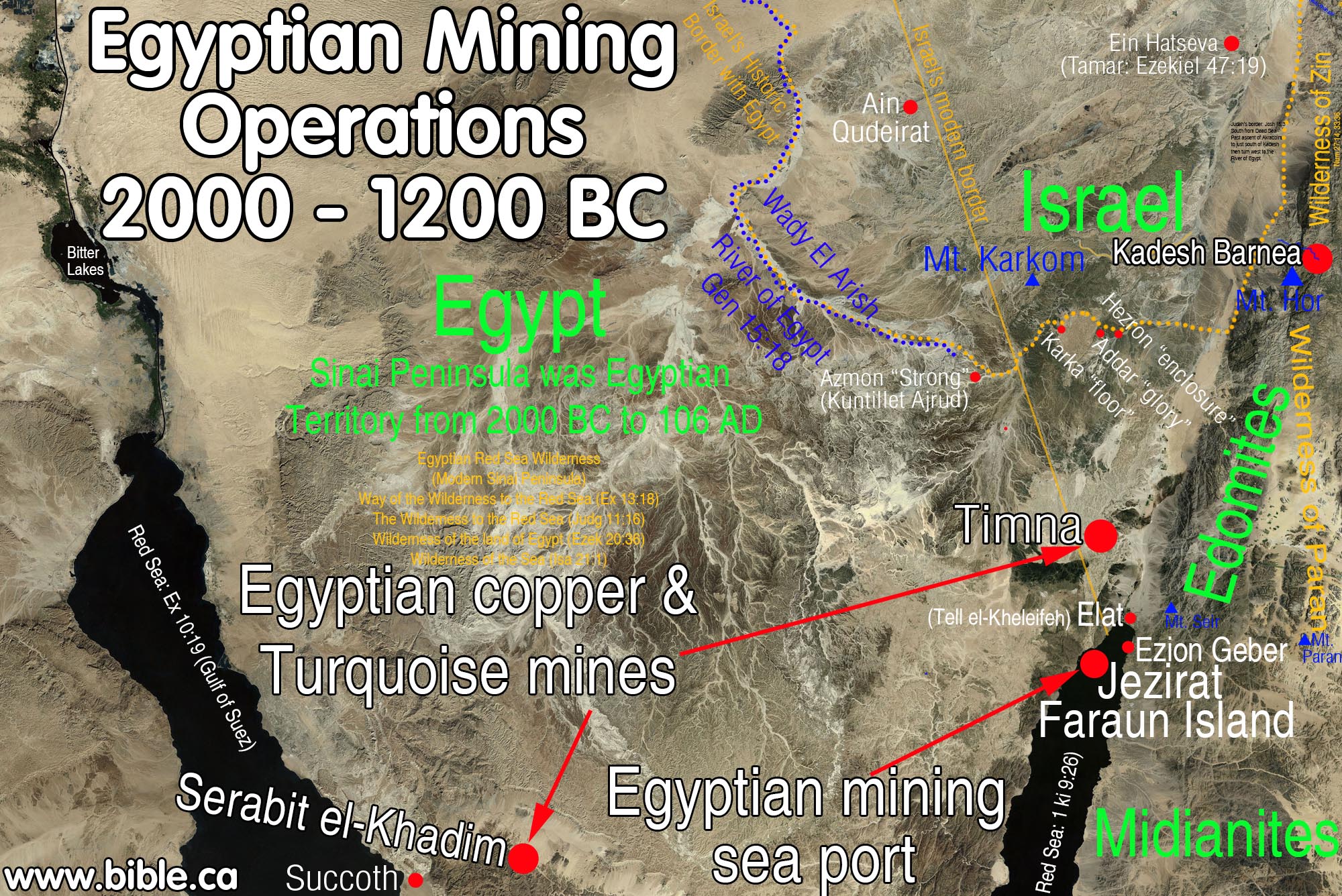
|
|
|
|
|
KEY#7 The River of Egypt is the border between Egypt and Israel Wadi El Arish = River of Egypt Arish = Tharu in 1446 BC and Rhinocolura [lit: cut off nose] in 100 BC |
West of the River of Egypt (Sinai Peninsula) has always been Egyptian territory
|
1. The Bible clearly defines the Sinai Peninsula as Egyptian territory since the border between Egypt and Israel has ALWAYS been the River of Egypt (Wadi El-Arish). Gen 15:18; Num 34:3-5; Deut 11:24; Josh 1:4; 15:1-4, 47; 1 Ki 4:21; 8:65; 2 Ki 24:7; 2 Chro 9:26; Isa 27:12-13; Ezek 47:19; 48:28
|
- MOST BIBLE MAPS ARE WRONG: because they fail to recognize the River of Egypt as the border between Egypt and Israel
- MOUNT SINAI: Any Bible map that locates Mt. Sinai west of the River of Egypt is wrong because they were out of Egypt after crossing the Red Sea. Israel did not spend 11 months at Mt. Sinai still in Egypt.
- KADESH BARNEA: Almost every Bible map since 1916 AD wrongly places Kadesh 27 km east of the River of Egypt at Qudeirat which is inside territory of Judah/Simeon. Israel did not spent 38 years at INSIDE the Promise Land at Kadesh (at Qudeirat).
- The border of Egypt has always been the Wadi el-Arish.
- Notice that Egypt proper ended at the Brook of Egypt: "The king of Egypt [Pharaoh Nico II] did not come out of his land again, for the king of Babylon Nebuchadnezzar had taken all that belonged to the king of Egypt from the brook of Egypt to the river Euphrates." 2 Kings 24:7
- So you think the Sinai Peninsula was outside the control of Egypt? Answer this: Who controlled the "Sinai Peninsula" and to name the country or King who controlled the Sinai at the time of the Exodus.
- Their answer, if they can even think of one, is "I don't know" or "no one" or "it was a barren waste land nobody wanted" or "it was a caravan crossroads between nations" or "it is kind of like asking who owns the Atlantic Ocean: everyone and no one at the same time. The Sinai Peninsula was a kind of "desert ocean" no one controlled."
- Yet all these are wrong. Egypt has always controlled the Sinai just as we see today.
- Josephus specifically calls the Sinai Peninsula "Egypt":
- Time of Joshua: "the lot of Simeon bordered upon Egypt and Arabia." (Josephus, Antiquities 5.78)
- The only place Egypt can border Simeon is the Sinai Peninsula, proving the entire Sinai was Egypt both at the time of the Exodus and in the first century AD when Josephus lived.
- Arish was the eastern border town of Egypt where criminals with their noses cut off were sent at the time of Joshua.
|
ARISH PRISON CAMP: Nose cut off and exiled to the border The fact that Arish was an Egyptian prison town from the time of the Exodus down to Paul, is utterly devastating to those who say the Sinai was not Egypt proper. The port city of Arish was in fact the far eastern border of Egypt at the Wadi el-Arish. It always has been. Any Mt. Sinai located in the Sinai Peninsula is impossible because the entire Peninsula was "inside Egypt" and under Egyptian control. Only a Mt. Sinai in Arabia, on the other side of the Gulf of Aqaba is outside Egypt entirely. |
- The Wadi el-Arish flows into the Mediterranean Sea at Arish. Arish was called Tharu in 1446 BC and Rhinocolura [lit: cut off nose] in 100 BC.
- 1348-1320 BC: "my majesty commands: that every officer who seizes the dues] and taketh the craft of any citizen of the army or of any person who is in the whole land, the law shall be executed against him, in that his nose shall be cut off, and he shall be sent to Tharu. (James Henry Breasted, Ancient Records of Egypt, 1906 AD, Vol 3 p 50-67, The Great Edict of Pharaoh Horemheb, 1300 BC)
- Against Requisitioning Boats Used for State Corvee Duty: "If a private individual makes for himself a boat with its on-board shelter, in order to be able to serve Pharaoh, l.p.h., and if people] of the army [come and appropriate it as if it were for (?)] taxes: then the individual is despoiled of his property and deprived of his abundant means [of doing service. This is a crime!] Something like this should not be done [to controvert] his good purposes. As for every boat which is taxable for the offering halls of Pharaoh, l.p.h., by the two deputies [of the army] …, [if someone comes] and seizes a boat belonging to any member of the army or anybody in the entire land, let the law be applied to him by cutting off his nose and sending him to Tcharu {Tharu}. [As for] an individual who is without a boat, and he gets from someone else a boat for his service obligation, and undertakes on his own to bring wood and is thus fulfilling his obligations [to Pharaoh, l.p.h., …]: [should others] seize and plunder his cargo, and steal it, and the individual stands despoiled of his [means of doing service … so that] he has nothing—This is not good, this report: it is an abuse indeed! My Person had decreed that one should turn away from it. Indeed, [this applies to …, and to] those who contribute to the Private Quarters, and similarly to all the gods’ offerings when they are taxed by the two deputies of the army and …: [if anyone does this, let] the law [be applied] against him by cutting off his nose and sending him to Tcharu {Tharu}." (Horemheld’s great edict, 108. Edict from Karnak, Texts from the Amarna Period in Egypt (Vol. 5). W. J. Murnane, , E. S. Meltz, p235, 1995 AD)
- 15 AD: "Next to Gaza is Raphia, where a battle was fought between Ptolemy the Fourth and Antiochus the Great. [218 BC] Then Rhinocolura, so called from the colonists, whose noses had been mutilated. Some Ethiopian invaded Egypt, and, instead of putting the malefactors to death, cut off their noses, and settled them at Rhinocolura, supposing that they would not venture to return to their own country, on account of the disgraceful condition of their faces." (Strabo, Geogr. 16.2.31, reporting event in 218 BC)
- Notice that Strabo reports even in 15 AD, that it was the Egyptians who settled the criminals. This fact proves the Sinai Peninsula was under Egyptian control both during the Exodus and IN THE MIND OF PAUL. (www.bible.ca/archeology/bible-archeology-exodus-kadesh-barnea-southern-border-judah-territory-river-of-egypt-wadi-el-arish-tharu-rhinocolu.htm)
- In addition to Arish/Rhinocolura and the Bible "slapping us silly in the face till we get it" with 13 verses that the Sinai Peninsula was Egyptian territory with the River of Egypt as the eastern border of Egypt, Josephus actually proves the Sinai Peninsula is also not part of Arabia:
- "However, our admirable author Apion hath before told us, that “they came to Judea in six days’ time;” and again, that “Moses went up to a mountain that LAY BETWEEN EGYPT AND ARABIA, which was called Sinai, and was concealed there forty days, and that when he came down from thence he gave laws to the Jews.” (Against Apion 2.24) Josephus is clearly refuting both the timing and location of Mt. Sinai in the Sinai Peninsula by "fiction writer Apion". So Queen Helina was not the first person to wrongly place Mt. Sinai inside Egyptian territory (Sinai Peninsula) in 325 AD, Apion gets the prize for this deception. Josephus identifies Apion as the first person in history to misplace Mt. Sinai in the Sinai Peninsula as fiction he invented. Read the quote again and suddenly it all becomes clear! Josephus knew Sinai was located in Saudi Arabia but Apion, known for his deliberate corruption of details of the Exodus, moved it into the Sinai Peninsula.
- Solomon built a series of fortresses near the
Egyptian border just east of the Wadi el-Arish in the Negev to protect his
Kingdom

|
|
|
|
|
KEY#8 The Ezion-Geber enigma "It is eleven days’ journey from Horeb by the way of Mount Seir [Edom via Ezion-Geber] to Kadesh-barnea." (Deuteronomy 1:2) |
- The Ezion-Geber enigma is any exodus route map that does not pass through Ezion-Geber as the last of 22 stops between Sinai and Kadesh Barnea. (Num 33:36)
- Ezion Geber is a critical location everybody overlooks in their exodus route maps.
- Any exodus route map that does not pass directly through Ezion-Geber is flat wrong.
- Ezion-Geber was a sea port town on the north end of the Gulf of Aqaba in the land of Edom:
- "Then Solomon went to Ezion-geber and to Eloth on the seashore in the land of Edom." (2 Chronicles 8:17)
- "King Solomon also built a fleet of ships in Ezion-geber, which is near Eloth on the shore of the Red Sea, in the land of Edom." (1 Kings 9:26)
- Since Jezirat Faraun was an Egyptian sea port to facility mining at Timna, Ezion-Geber must be located on the Arabian (eastern) side of the northern tip of the Red Sea in the land of Edom.
- Ezion-geber was inside Edom and Kadesh was on the border with Edom. Edom never ventured out of her Transjordan territory until after the attack of Nebuchadnezzar in 605 BC as seen in the Arad Ostraca and Obadiah, Ps 137 etc. Transjordan Edom is 100 km east of Qudeirat whereas Petra is another perfect fit.
- "It is eleven days’ journey from Horeb by the way of Mount Seir to Kadesh Barnea." (Deuteronomy 1:2)
- The 11 day route between Mt. Sinai at Lawz in Saudi Arabia via Edom (Mt. Seir) through Ezion-Geber to Kadesh Barnea at Petra is a perfect fit.
- Mt. Seir means they passed by the capital city of Edom at Mt. Seir.
- “The Lord came from Sinai, And dawned on them from Seir;
He shone forth from Mount Paran, And He came from the midst of ten
thousand holy ones; At His right hand there was flashing lightning for
them." (Deuteronomy 33:2) Here is Mt. Paran
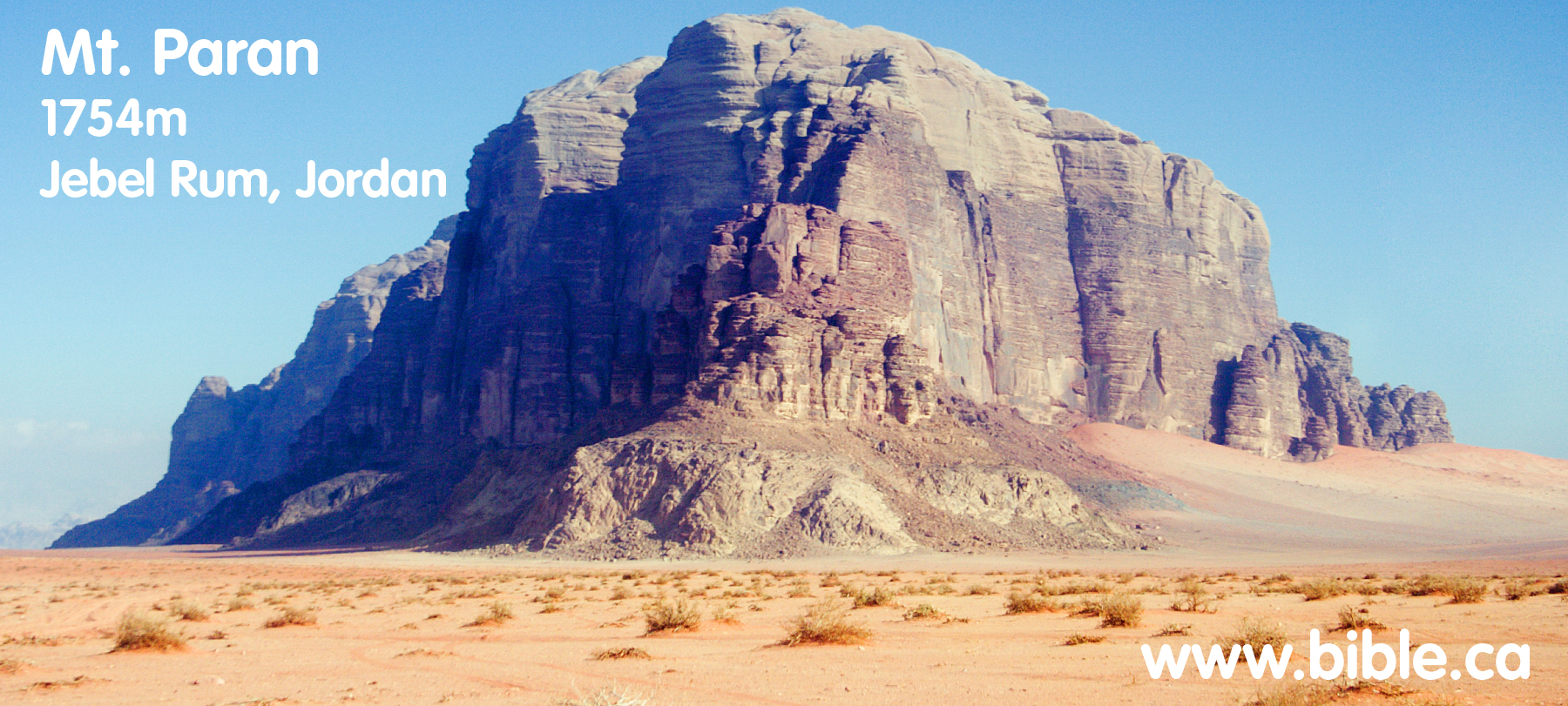
- Ezion-geber supports a Kadesh located at Petra and makes Kadesh Barnea in most Bible maps at Ein Qudeirat impossible for three reasons:
- There is an almost impassable mountain range between Ezion-Geber (near Elat) and Ein Qudeirat. The Arabah Valley Between Ezion-geber and Petra is a flat wide, easy down hill walk.
- Ezion-Geber was the LAST of 22 stops between Sinai and Kadesh but is geographically at the halfway point if Kadesh is Ein Qudeirat. The idea that 135 km journey (as the bird flies) from Ezion-Geber to Ein Qudeirat is ONE STOP through the mountains is impossible to harmonize. Even worse with a Mt. Sinai located anywhere in the Sinai Peninsula. I have driven the modern road between Elat and Qudeirat many times and the route is impossible for a large population.
- Exodus Routes that suffer from the Ezion-Geber Enigma:
- Gordon Franz's Sinai at Mt. Sin Bisher is absurd since Ezion-geber is the last stop before a Kadesh at Qudeirat. Indeed, Franz totally ignores Ezion-Geber on his exodus route map. Even if he did have the route between "his Sinai" and "Woolley/Lawrence's Kadesh" at Qudeirat, pass through Ezion-Geber, the Israelites would have to traverse a huge mountain range not once BUT TWICE.
- Even worse is a mount Sinai at Gebel Khashm et-Tarif (Hashem el-Tarif) because Israel would go 21 stops a total distance of 50 km to reach Ezion-Geber then because of the mountains, be forced to backtrack and PASS Khashm et-Tarif on route to Kadesh at Qudeirat.
- Check your exodus route map to see if the last stop before Kadesh passes directly past the north end of the Gulf of Aqaba at Ezion-Geber. If it does not, throw it out as wrong.
|
|
|
|
|
KEY#9 "Piltdown Kadesh" vs. Biblical Kadesh Barnea |
Indiana Jones: "Balloq's medallion only had writing on one side? You sure about that?" Sallah: "Positive!" Indiana: "Balloq's staff is too long. Indiana." Both: "They're digging in the wrong place!"
"For 100 years they have been digging for Kadesh in the wrong place"
Detailed study of the history of the search for Kadesh Barnea.
Kadesh Barnea at Petra and the "Piltdown Kadesh" on all our modern Bible maps at Ein Qudeirat
- PILTDOWN KADESH: Since 1916 AD all Bible maps wrongly place Kadesh Barnea at Ein Qudeirat after Woolley/Lawrence chose it at that location.
- It is impossible for Ein Qudeirat to be Kadesh, since it is 27 km deep inside the promised land.
- Edom and the Negev are such a problem to those who want Ein Qudeirat to be Kadesh, that they move Edom to inside Judah and the Negev north of Beersheba.
- As the largest oasis in the Sinai Peninsula, Joshua identifies Ein Qudeirat as "Ain" not Kadesh: Joshua 19:7; 1 Chron 4:32 as part of Simeon's Territory
- The location of Kadesh must satisfy these facts:
- Kadesh is Transjordan, south-east of the salt sea. (Numbers 34:3-5; Joshua 15:1-4)
- Kadesh Barnea was on the border of Edom: Num 20:16. Archeology has proven the fact that Edom was historically Transjordan (east of the Arabah) until they first moved into Judean territory after the Babylonian captivity. This means that before 586 BC Edom's territory was always Transjordan. Ein el Qudeirat is nowhere near the border of Edom, which disqualifies it as Kadesh. Modern Bible maps make a grave error of locating Edom well into the Negev, not because of archeological evidence, but because they know the border of Edom was beside Kadesh. In a spectacular display of circular reasoning these maps bring the border of Edom right beside Ein el Qudeirat, where they wrongly believe Kadesh is located. Kadesh Barnea, wilderness of Paran and Wilderness of Zin must be outside all boundaries of Israel, including the Negev. No Bible passage says that Kadesh Barnea, Paran or Zin were ever part is Israel or located in the Negev, or the western edge of the Arabah.
- Kadesh is near Mt.
Hor, the burial place of Aaron. This photo take from an altar on the
summit of a mountain at Petra looking east to Mt. Hor where Aaron was
buried.
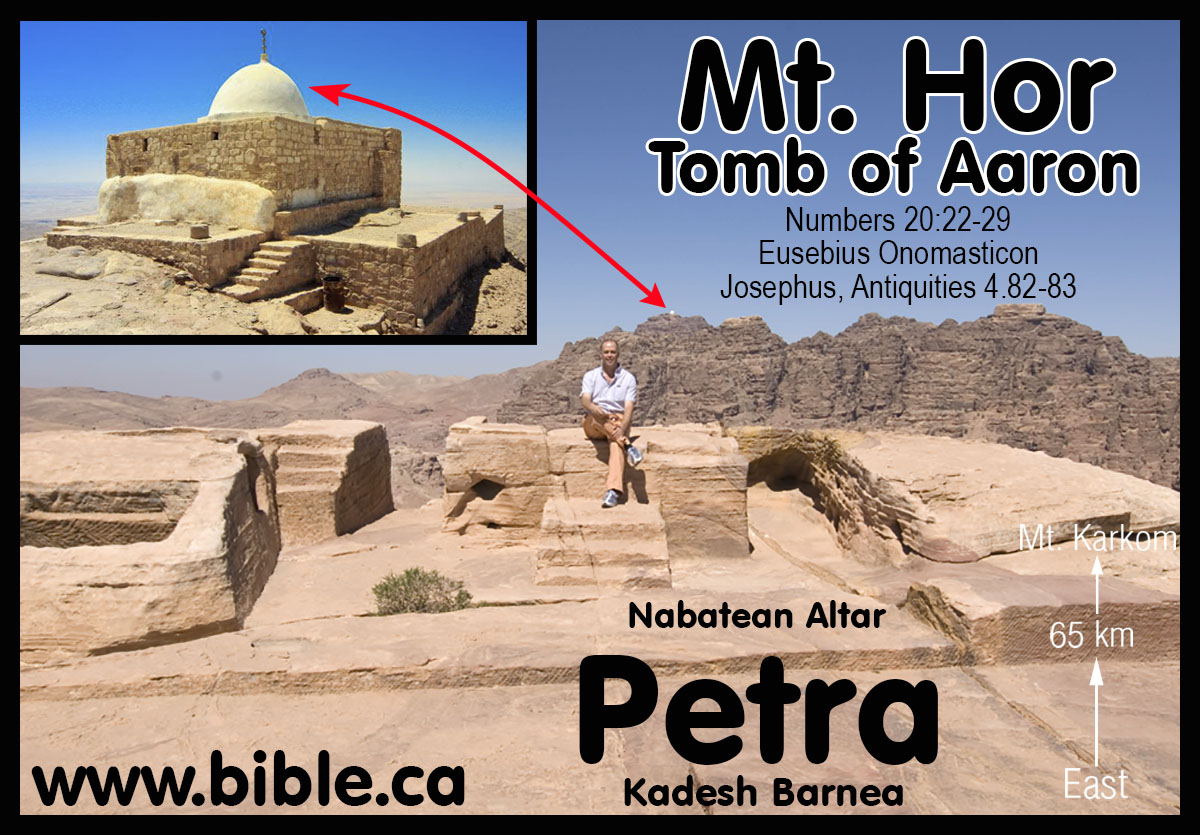
- Moses brought water from a rock at Kadesh
- Kadesh is a burial city because 2 million Hebrews died at Kadesh Numbers 14:29-35
- Ancient and modern sources who located Kadesh Barnea is located at Petra:
- Ancient sources who locate Kadesh Barnea is located at Petra:
i. Josephus stated that the burial place of Aaron was at Petra:
1. Josephus stated that the burial place of Aaron was at Petra. "Then it was that Miriam, the sister of Moses, came to her end, having completed her fortieth year since she left Egypt, on the first day of the lunar month Xanthicus. They then made a public funeral for her, at a great expense. She was buried upon a certain mountain, which they call Sin; and when they had mourned for her thirty days ... Now when this purification, which their leader made upon the mourning for his sister, as it has been now described, was over, he caused the army to remove and to march through the wilderness and through Arabia; and when he came to a place which the Arabians esteem their metropolis, which was formerly called Arce, but has now the name of Petra, at this place, which was encompassed with high mountains, Aaron went up one of them in the sight of the whole army, Moses having before told him that he was to die, for this place was over against them." (Josephus, Antiquities 4.82-83)
ii. In 325 AD Eusebius (and Jerome in 400 AD) wrote the Onomasticon, which is a "dictionary of places" and locate Kadesh at Petra:
1. The Onomasticon says that in their day, you could still see the rock Moses struck at Kadesh and the tomb of Aaron were at Petra.
2. At Petra, the 1 km long Siq that the water was channeled down is called, the "wadi of Moses" according to ancient tradition.
3. Eusebius writes: "Kadesh Barnea (or Cades Barnea): "Kadea Barne. The desert which extends to (the city of) Petra a city of Arabia. There Mariam went up and died, and there the doubting Moses struck the rock to give water to the thirsty people. The tomb of Mariam herself is pointed out there even now. There also Chodollagomor beat the chiefs of the Amalakites." (Eusebius, Onomasticon, round brackets are Eusebius') Footnote #: 580. Kadēa Barnē. Numbers 32:8; K. 112:8; L. 270:4. Textual variant city of Palestinē (Greek) instead of Arabia. This reflects again the uncertainty of editorial additions and of the use of Arabia in the Onomasticon (K. 110:27). Latin combines K. 112:7 and K. 112:8. Some confusion in order of this and the next three entries. A summary of biblical information from Numbers 21:1, 11; Numbers 27:14 and Genesis 14:7. A tomb tradition is here. No location is given other than near Petra (K. 142:7). Procopius repeats the entry in 332D and 1021D. It also is reaffirmed by Jerome in Commentary on Ezekiel 38:23(cf. K. 46:26). In Interpretation of Hebrew Names "Cades, holy or change" (63); "Cades, alteration or holy" (80); "Cadesbarne, selected change or changeableness" (80). (The Onomasticon, Eusebius, 325AD)
4. Eusebius writes: "Mt Hor: ōr. Mountain on which Aaron died near the city of Petra. There is now pointed out the rock which flowed for Moses (which Moses struck and gave water to the people)." Footnote #: 979. ōr. Numbers 20:22, 28; K. 176:7; L. 291:88. Mt. near Petra (K. 142:7). Cf. K. 126:19 and K. 46:14 for Aaron's death. See K. 150:23 for Mt. Seir. Josephus Antiquities IV, 4, 7 tells of Aaron's death up on the mountain range that encloses Petra. In Interpretation of Hebrew Names "Or, passionate" (77) and "Or, light" (83). (The Onomasticon, Eusebius, 325AD)
5. Eusebius writes: "Kadēs. Where the spring "of judgment" was. Footnote #: 579. Kadēs. Genesis 14:7; K. 112:7; L. 269:3. Simple biblical notation. In Hebrew Questions Jerome says "Cades is a place near Petra called the spring of judgment where God judged the people". (The Onomasticon, Eusebius, 325AD)
6. Eusebius writes: "Beroth. "Of the sons of Jakeim (Iacim)." Place in the desert where Aaron died. It is pointed out (still today) ten miles from Petra on the summit of the mountain." (The Onomasticon, Eusebius, 325AD)
7. Eusebius writes: "Barnea (same as Kadesh Barnea): "Barne: This is Cades Barne, on the desert which extends up to the city of Petra." (Eusebius, Onomasticon, round brackets are Eusebius') Footnote #: 213. Barnē. Joshua 10:41; K. 46:26; L. 247:74. Identified with the desert stretching south of Petra (K. 142:7) and more frequently Kadēs Barnē (K. 112:8). (The Onomasticon, Eusebius, 325AD)
8. Eusebius writes: "Petra. City in the land of Edom in Arabia which is called Iechthoel. This is also called Rekem by the Assyrians (Syrians). Footnote #: 762. Petra. Judges 1:36; K. 142:7; L. 279:71. No letter division in the Vatican Greek manuscript here. Procopius 1048B has Petra in Idumala (K. 102:23). On Tabula Peutinger it is 48 miles south of Theman (K. 96:18). It is an important reference for the Onomasticon and all the Roman road systems. It is also called Rekem (K. 144:7 and K. 36:13). Mt. Hor (K. 176:7) is nearby. The Nabatean influence lasted into the Roman period of the Onomasticon. Petra was one of the Nabatean cities given autonomy about 106 A.D. with the establishment of the Roman Province of Arabia. It was a great city in the 3rd and 4th centuries. The Christians of Petra were persecuted by Diocletian. (The Onomasticon, Eusebius, 325AD)
9. Eusebius writes: "Rekem. It is also Petra, city of Arabia, "whose ruler Rocom the children of Israel killed. It is said he was also king of Madiam." Footnote #: 773. Rekem. Numbers 31:8; K. 144:7; L. 280:94. Identity and summary of biblical information (Joshua 13:21; Numbers 31:8; cf. K. 142:7 and K.36:13, for Petra, named Rekim by Josephus). In Interpretation of Hebrew Names "Recem, variety or painting". (The Onomasticon, Eusebius, 325AD)
10. Notice that Eusebius sees two different Cades, but the true Cades (or Kadesh Barnea) is next to the wilderness of Paran, also known as the desert of the Saracens: "Gerara. The Geraritike is now called after this, (the region) beyond the Daroma. Twenty-five miles south of Eleutheropolis. It is the old southern boundary of the Chanaanites and a royal city of the Philistines (metropolis of Palestine). It is located, as Scripture affirms, "between Cades and Sur" (i.e., between) two deserts. The one adjoins Egypt whence the people came having come through the (straits of the) Red Sea. The other (true) Cades extends up to the desert of the Saracens." (The Onomasticon, Eusebius, 325AD) Of course the Bible does not say that Gerar is between Kadesh Barnea and Shur, but that Abraham lived there, then moved and sojourned near Gerar. Eusebius and the Madaba map correctly place Gerar, but confuse its position in relation to Kadesh and Shur. Even today people misread Gen 20:2 the same way Eusebius did.
11. Eusebius writes: "Asasan Thamar (Asasonthamar). Where the Amorrites dwelled whom Chodollagomor destroyed is located near the wilderness of Cades. It is said there is a village Tharmara (a fort Thamara) one day journey from Mapsis on the road from Hebron to Ailam. [Elat on the Red Sea, see Ailam] Today there is a garrison (Roman fort) of soldiers there." Footnote #: 8: Asasan Thamar (Asasonthamar). Genesis 14:7; K. 8:6; L. 234:84. On the Madaba Map there is a Thamara located as suggested by Eusebius here. Tabula Peutinger has a Thamaro 52 or 53 miles from Jerusalem while Ptolemy's list (V, 15, 5f) has a Thamaro about 55 miles distant. The Notitia Dignitatum (74:40) has a Tarba and (74:46) a Thamarra both of which have a garrison. Alt found a fort at Qasr el Juheiniye and he is followed by many locating the fort there and the village at 'ain el 'Arus. Aharoni more recently (TEJ, 1963, p.30ff) suggests 'Ain Husb which is about a day's walk (32 km) from Kurnub which is generally identified with Mapsis (cf. also Avi-Yonah) and has a large Roman fort as well as Nabatean and Iron II sherds. The Madaba Map using Jerome's spelling has located properly Mampsis. Many Nabatean, Roman-Byzantine levels excavated at Kuroub. It shows a revival in the fourth century A.D. as also does Oboda (Avdat, 'Abda, and K. 176:9).This may be indicated by "village" in Greek and "oppidum" in Latin (cf. K. 10:25). II Chronicles 20:2 identified Thamar with En Gedi or at least locates it in the district of En Gedi (86:16). Jerome in Hebrew Questions says, "his city which we now call Engaddi, is rich in balsam and palms since Asason Thamar translated into our language is city of the palms'" (18) (cf. Judges 1: 16, Ezekiel 47: 29). (The Onomasticon, Eusebius, 325AD)
12. Eusebius writes: "Ailam (Ailath). Is situated at the extremity of Palestine between the southern desert and the Red Sea where cargo was transported by ship from both Egypt and India. A detachment of the Tenth Roman Legion is stationed there. Properly called Aila today (it was formerly pronounced Ailath) from whence the ancient people the Ailamites whose king was Chodollagomor [who is mentioned in the Acts of the Apostles]. Another Ailam of the foreigners (of Palestine) is noted in Kings." Footnote #: 6: Ailam (Ailath). Genesis 14:1; K.6:17; L. 234:75. In the Vulgate we find Ailath, Elath, and Aila for this same site. Palestine is the southern part of Syria. This word is missing in the Vatican Manuscript. Technically the southern limits of the Onomasticon should be Ailam (Ailath). The ruins are inland about one mile from Aqabah but not as far inland as Tell el Kbeleifah which is probably the older Ezion Geber (K. 36:l, cf. K. 34:23, 62:13, Josephus Antiquities, IX, 12, 1). It was the end of the road going north to Damascus and the terminus of the overland road west to the Mediterranean. In Jerome's time it was a very busy port (Vita Hilariaris, 18, and cf. Commentary on Ezekiel 47:18). Eusebius does not indicate its size but it may be inferred that it was a polis. A bishop was present at Nicea. Eusebius uses some army source and the text is useful for noting the deployment of the Roman legion. The Tenth is located here. The Notitia Dignitatum (73:18f.) verifies this entry. The Tabula Peutinger, 820 has a Haila 83 miles from Petra and 150 miles southeast of Gaza which fits this site at el 'aqaba. The city in II Samuel 10:16 is in northeast Transjordan. The Syriac text notes it is a city of the Philistines. The Greek allophulos usually means Philistines but once or twice we cannot be positive, so in this present translation the general term "foreigners" has been preferred, especially when Jerome does not have Filistine. He has Filistine in K. 7:15, K. 21:2, K. 3:25, K. 119:3 but more often uses transliteration allofylorum (see Appendix I). (The Onomasticon, Eusebius, 325AD)
13. The Onomasticon references two "Kades": One near Gerar and but the "true Cades" at Petra. Eusebius places Arad near the Desert of Kadesh Barnea, but the Madaba map places Arad between Beersheba and Egypt rather than between Beersheba and the Dead sea. However the Madaba map is not to scale and has huge distortions of distance and relative size. "Arad. City of the Amorrites near the desert of Cades. There is now (shown) a village four miles from Malaatha, and twenty from Hebron. Tribe of Juda." (The Onomasticon, Eusebius, 325AD)
iii. 400 AD: Jerome: En-mishpat, Kadesh, Spring of Judgement is at Petra: Gen 14:7
1. "Gen 14:7: And they returned and came to the fountain of judgement, that is, to Cades. Because Cades was so named later on, it is specificied by way of anticipation; and it refers to a place near Petra, which is called 'The Fountain of Judgement', because God judged the people there" (Saint Jerome's Hebrew Questions on Genesis, translated by C. T. R. Hayward, p 46, Gen 14:7, 1995 AD)
2. "Kadēs. Where the spring "of judgment" was. Footnote #: 579. Kadēs. Genesis 14:7; K. 112:7; L. 269:3. Simple biblical notation. In Hebrew Questions Jerome says "Cades is a place near Petra called the spring of judgment where God judged the people". (The Onomasticon, Eusebius, 325AD)
3. "No location [for Kadesh Barnea] is given other than near Petra (K. 142:7). Procopius repeats the entry in 332D and 1021D. It also is reaffirmed by Jerome in Commentary on Ezekiel 38:23(cf. K. 46:26). In Interpretation of Hebrew Names "Cades, holy or change" (63); "Cades, alteration or holy" (80); "Cadesbarne, selected change or changeableness" (80). (The Onomasticon, Eusebius, 325AD)
- Modern sources who locate Kadesh Barnea is located at Petra:
i. 1856 AD Arthur Penrhyn Stanley:
1. "It is moreover one of the few facts localised by anything like an authentic tradition,-in this case preserved by Josephus, the Talmudists, Eusebius, and Jerome, --that Kadesh was either identical, or closely connected with Petra." (Sinai and Palestine, in connection with their history, Arthur Penrhyn Stanley, 1856 AD, p84-99)
2. "It [Mt Hor at Petra] is one of the very few spots connected with the wanderings of the Israelites, which admits of no reasonable doubt." ... "If there be any ground for this conclusion, Petra assumes a new interest. Its rock-hewn caves may have served in part for the dwellings, in part for the graves of the Israelites ; it is dignified as the closing scene of the life both of Miriam and Aaron". ... Is it too much to suppose that this point and Mount Hor were long regarded as the two sacred spots-of Petra ; that the scene of the death and sepulture of Aaron was designedly fixed in view of this, the innermost sanctuary of the Holy Place of " Kadesh ; " that this sanctity was retained through the successive changes of Pagan and Christian worship; and that the pilgrims of the Desert mounted these time-worn steps, and traced their inscriptions upon the rock, on their way to the only spot, whence they could see the grave of Aaron?" (Sinai and Palestine, in connection with their history, Arthur Penrhyn Stanley, 1856 AD, p84-99) Note: In 1901 AD, Robinson comments on Stanley, who said Kadesh was at Petra: "Stanley in his Sinai and Palestine (pp. 92-8) identifies Sela' or Petra with Kadesh, which is absurd." (Modern Kadesh or Ein Kadis, George L. Robinson, The Biblical World, Vol. 17, No. 5., May, 1901AD) Of course, there is nothing absurd about Petra being Kadesh. Stanley's ill informed belief that the city carved in stone we see today, like the "Treasury" dates back to the Exodus is indeed absurd! Stanley was wrong to suggest that Petra as we see it today, is the result of the Hebrews in 1446 BC when in fact the city we see today was carved by the Nabataeans in 350 BC. But Stanley was right in correctly locating Kadesh at Petra. He was a lone voice of truth, who needed the help of modern archeology to make the correct conclusions we are making today almost 150 years later.
ii. In 1891 AD Keil & Delitzsch state they are certain that Mt. Hor is located at Petra. In a most puzzling confusion, Keil & Delitzsch located Kadesh at Ein Qedeis, but located Mt. Hor 100 km east of Qedeis, at Petra. Both Kadesh and Mt. Hor were on the border of Edom and Mt. Hor was only "one stop" from Kadesh: Numbers 20:22; 33:37. This makes it impossible for Kadesh to be located 100 km west of Mt. Hor at Qedeis The border of Edom cannot be both the Arabah valley AND at Ein Qedeis! Keil & Delitzsch write: "Death of Aaron at Mount Hor. - The Israelites left Kadesh [which Keil & Delitzsch believed was at Ein Qedeis), and passed along the road just mentioned to Mount Hor. This mountain, which was situated, according to Num. 33:37, on the border of the land of Edom, is placed by Josephus (Ant. iv. 4, 7) in the neighbourhood of Petra; so also by Eusebius and Jerome: "Or mons, in quo mortuus est Aaron, juxta civitatem Petram." According to modern travellers, it is Mount Harun, on the north-western side of Wady Musa (Petra), which is described by Robinson (vol. ii. p. 508) as "a cone irregularly truncated, having three ragged points or peaks, of which that upon the north-east is the highest, and has upon it the Muhammedan Wely, or tomb of Aaron," from which the mountain has received its name "Harun," i.e., Aaron (vid., Burckhardt, Syr. pp. 715, 716; v. Schubert, Reise, ii. pp. 419ff.; Ritter, Erdkunde, xiv. pp. 1127ff.). There can be no doubt as to the general correctness of this tradition; for even if the Mohammedan tradition concerning Aaron's grave is not well accredited, the situation of this mountain is in perfect harmony with the statement in v. 23 and Num. 33:37, viz., that the Israelites had then reached the border of the land of Edom." (Keil & Delitzsch, 1867, Num. 20:22-29)
iii. In 1871 AD, Jamieson, Fausset, Brown give Petra as one of two locations on the Arabah Valley for Kadesh: "they came ... to Kadesh—an important encampment of the Israelites. But its exact situation is not definitely known, nor is it determined whether it is the same or a different place from Kadesh-barnea. It is supposed to be identical with Ain-el-Weibeh, a famous spring on the eastern side of the desert [Robinson], or also with Petra [Stanley]. (Jamieson, Fausset, Brown, 1871 AD, Num 13:26)
iv. In 1908AD: "Yet ever since Dean Stanley in 1856 (Sinai and Palestine, pp. 152, 153, 161) identified Jebel Nebi Haroun with Mt. Hor, and Petra with Kadesh-Barnea, most commentators have adopted without question his conclusion. (The True Mount Hor, Jebel Maderah. George L. Robinson, The Biblical World, Vol. 31, No. 2., Feb., 1908, p 86-100)
v. In 1910 AD, Nathan Schmidt, after considering Weibeh, Kades and Qudeirat, rejected them all and concluded that Kadesh was in fact at Petra: In choosing the location of Kadesh, Schmidt rejected Qudeirat in favor of Petra in 1910 the same way that Stanley rejected Weibah in favor of Petra in 1856: "It seems to me even more probable that Petra was the original scene of these stories. Here the great Deliverer (Cp. my article "The Jerahmeel Theory and the Historic Importance of the Negeb," Hibbert Journal, vi. 2 January, 1908, pp 339ff.) performed the miracle of piercing the rock and sending the wonderful stream through the Sik, and here his older brother Aaron died on the peak of Mt. Hor. In earlier times the gulf of 'Akabah reached farther north than it does to-day [note: Schmidt is wrong about water levels. Solomon's fortress at Elat -Tell el-kheleifeh was built on a hill 500 meters from the shore of the Red Sea less than 12 feet above current sea level. This proves sea levels have not changed much in 3000 years.], and a passage from the eastern side over to El Tih may not have been as easy as it is at present. Nomadic tribes pushing northwest from the land of Midian no doubt found their way down into the Negeb through the defiles of Mt. Seir (Jebel Sharra). The Idumaean clans that camped around Moserah and Zin probably brought with them the traditions of their heroes. Their way from Sinai-Horeb to Kadesh Barnea and Mt. Halak is likely to have led them through the Valley of Moses and put the reputed resting place of Aaron in Petra." (Kadesh Barnea, Nathan Schmidt, Journal of Biblical Literature, Vol 29, no 1, 1910 AD, p75-76)
|
|
|
|
|
KEY#10 Carsten Niebuhr discovers the Gulf of Aqaba in 1762 AD Without the Gulf of Aqaba, the Sinai Peninsula becomes Arabia |
Step aside Christopher Columbus, Carsten Niebuhr discovers the Gulf of Aqaba in 1762 AD
- Herodotus:
484 BC had no idea the Gulf of Aqaba existed:
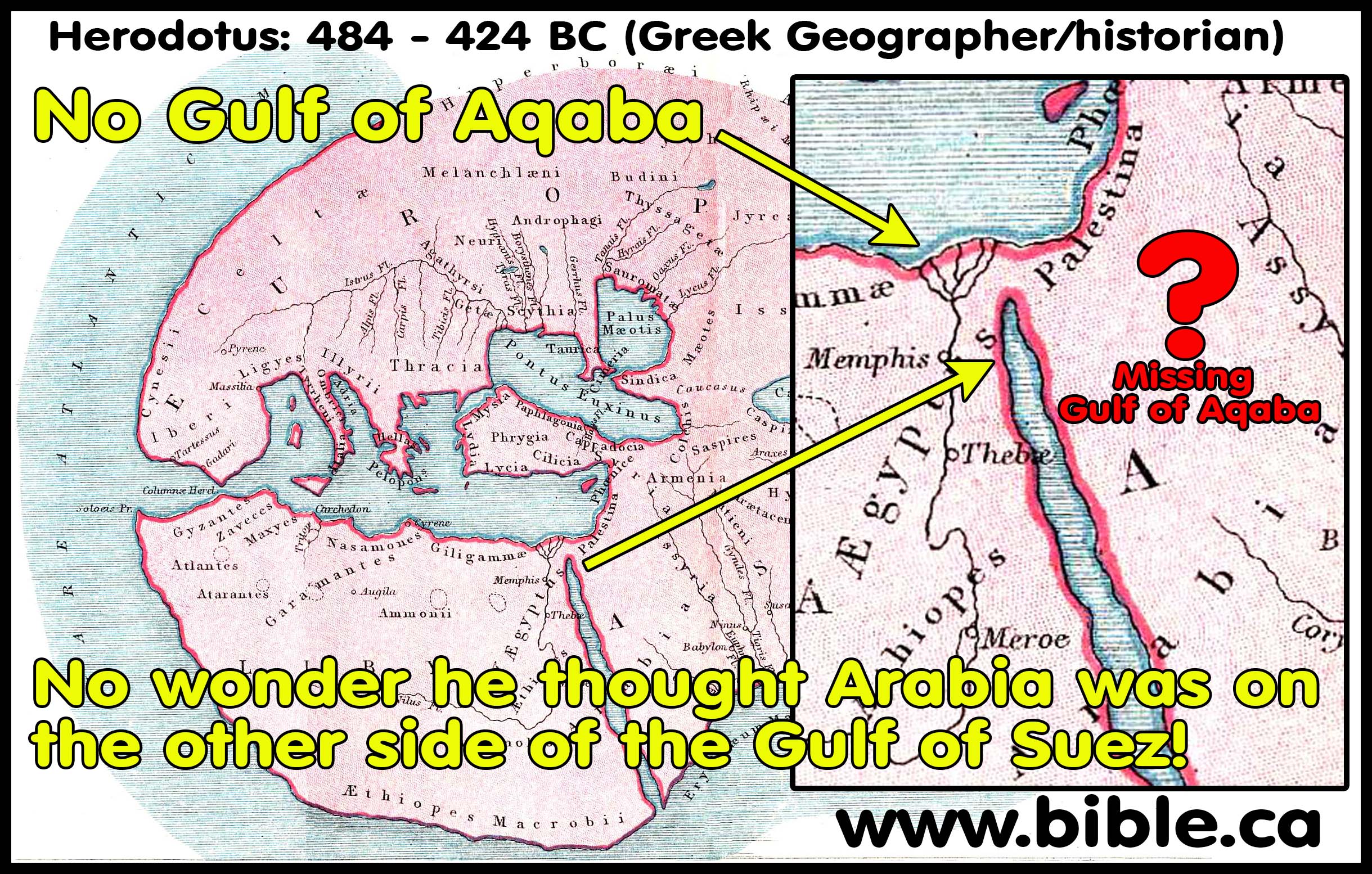
- MOST OF THE EXODUS ROUTE MAPS OF THE RENAISSANCE WERE WRONG: Without the Gulf of Aqaba, Arabia begins in the Sinai Peninsula!
- Let begin by taking note a few exceptions to this ignorance of the Sinai Peninsula and the Gulf of Aqaba.
- Agatharchides:
169 BC is unique in that he is one of the few geographers of his day
that understood the Gulf of Aqaba calling it the "Laeanites
Gulf". He restricts "Arabia" to south and east of the Gulf
of Aqaba. Agatharchides did not sail down the Laeanites Gulf, but says
the Arabs live on the east/south shore of the Gulf of Aqaba and that at
the end of the Gulf, is Petra! No Arabians lived in the Sinai Penisula.
As he sails down the Red Sea towards the Indian Ocean, he describes all
the various tribes of Arabians. No Arabians lived in the modern Sinai
Peninsula.
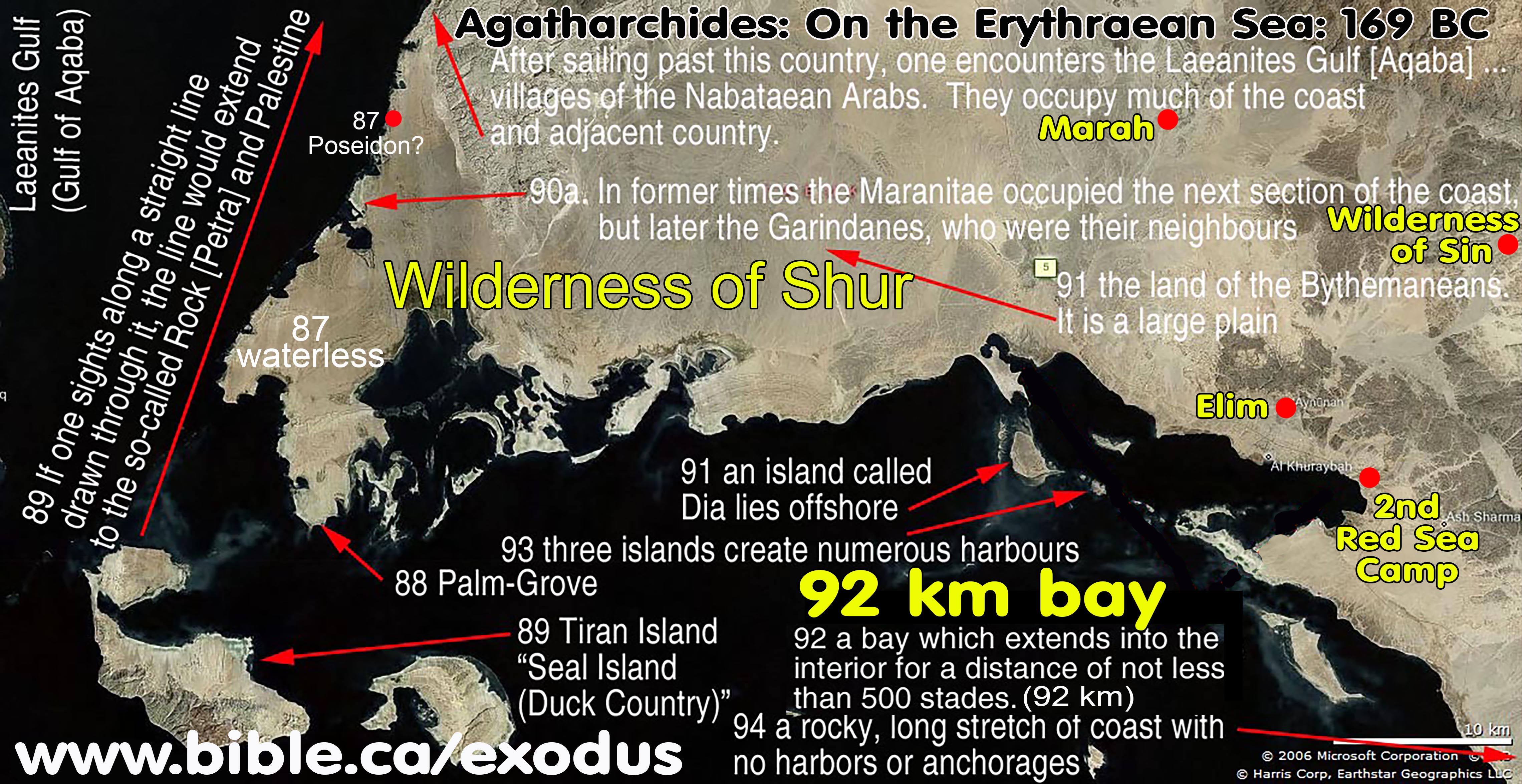
- Strabo:
15 AD is one of the few ancient
cartographers who understood the gulf of Aqaba and gives us great insight
into how Apostle Paul and Josephus viewed the Sinai Peninsula as NOT part
of Arabia: "There is said to be a passage thence across, of
1260 stadia, to the city Aila (Aelana) [Elat], situated on the innermost
recess of the Arabian Gulf [Red Sea]. This recess has two branches, one, in the direction of Arabia [south of Gulf of Aqaba] and Gaza [north of
Gulf of Aqaba], is called Ailanites
[Gulf of Aqaba], from the city upon it; the other [Gulf of Suez] is in
the direction of Egypt, towards Hereopolis, to which from Pelusium is the
shortest road (between the two seas).
(Strabo, Geogr. 16.2.30) So finally when a cartographer correctly maps
the gulf of Aqaba, they correctly exclude the Sinai Peninsula from Arabia
and locate Arabia on the south of the gulf of Aqaba!

- The Peutinger
Map 330-381 AD is one of the oldest extant maps in the world and was
likely authored during the Constantine years, correctly draws the Gulf of
Aqaba in distinction with the Gulf of Suez. Not surprisingly, Mt. Sinai
is exactly where Constantine's mother chose it from a dream inside the
Sinai Peninsula at the traditional location at Mt. Musa. Kadesh Barnea,
although is not named, its original late bronze (1446 BC) location
at the Nabatean city of Petra (100 BC), which was called Sela, during the
monarchy (1000 BC). What is interesting, is that Josephus
and Eusebius both place Kadesh Barnea at Petra. So while the location of
Mt. Sinai was chosen by a dream, Kadesh Barnea was a known location
through Josephus and Eusebius
and his Onomasticon.

- Heinrich Bunting Hem of Germany (1585 AD) who drew a
rough version of the gulf of Aqaba, but most did not. Heinrich Bunting Hem,
lived in Germany during the Renaissance, in the 16th century. This
century Protestant revolution took place in Germany. It appears that he
was one of the few Renaissance cartographers who understood the Gulf of
Aqaba. He has a north Suez crossing, Kadesh Barnea south of Beersheba and
places Midian at Elat at the north end of the Gulf of Aqaba. The map is
clearly early since it still uses the I in place of J I the alphabet
which the KJV of 1611 also used.
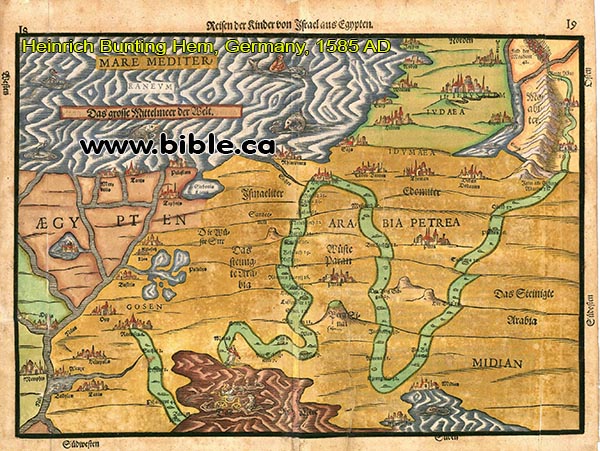
- In 1762 AD, Carsten Niebuhr is one of the first to
actually draw the Gulf of Aqaba kind of correctly, although his
understanding was limited. He also placed the "Straights of
Tiran" on the map! This is the crossing point of the Red Sea,
although he probably didn't know it at the time. However he incorrectly
mapped the north end of the Gulf of Aqaba as a "forked tongue".
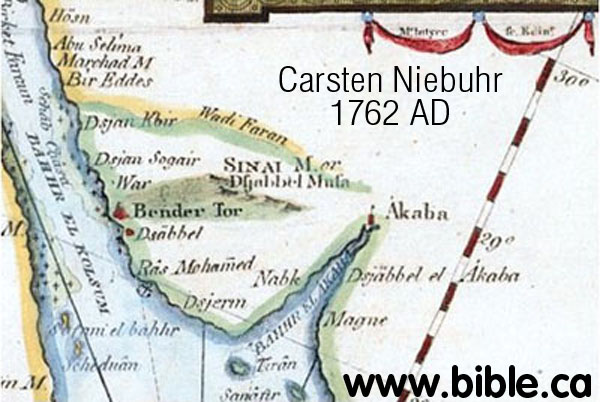
- See the entire Exhibit of Ancient and Antique Exodus route maps: www.bible.ca/archeology/bible-archeology-maps.htm.
- Without the Gulf of Aqaba, Arabia begins in the Sinai Peninsula and the Red Sea crossing must be at the Bitter Lakes area or the north Gulf of Suez! You will never find truth when the truth option is not on the table!
- Here is a full discussion of the rediscovery of the Gulf of Aqaba and its impact on the exodus route: catalogue of over 50 historic exodus route maps.
|
|
|
|
|
KEY#11 If you want to know how Paul defined Arabia, just ask and Josephus, Strabo and Herodotus because they never call Sinai Peninsula "Arabia". Josephus calls the Sinai Peninsula "Egypt" in Antiquities 5.78 |
A. Arabia at the time of Paul's conversion in 36 AD was the Nabatean kingdom with Petra as the capital city
- Mt. Sinai is located in Arabia not the Sinai Peninsula:
- Some have generated the fiction that the Nabatean Kingdom headquartered at Petra controlled the Sinai Peninsula. This is false.
- The Nabateans never controlled the Sinai Peninsula even though they did travel through their caravan routes crossed the Sinai of Egypt. full study on Arabia at the time of Paul.
- Paul is the antitype of Moses in 24 direct parallels; one of them being both Moses and Paul received the law at Mt. Sinai.
- Paul Went to Arabia (Mt. Sinai) immediately after being converted: "But when God, who had set me apart even from my mother’s womb and called me through His grace, was pleased to reveal His Son in me so that I might preach Him among the Gentiles, I did not immediately consult with flesh and blood, nor did I go up to Jerusalem to those who were apostles before me; but I went away to Arabia, and returned once more to Damascus." (Galatians 1:15–17)
- "This is allegorically speaking, for these women are two covenants: one proceeding from Mount Sinai bearing children who are to be slaves; she is Hagar. Now this Hagar is Mount Sinai in Arabia and corresponds to the present Jerusalem, for she is in slavery with her children. But the Jerusalem above is free; she is our mother." (Galatians 4:24–26)
|
24 ANTITYPES: Paul is the Antitype of Moses as Lawgiver of New Covenant |
|
1. Chosen from birth for special purpose 2. Outsider "Trojan horse" brought into highest level of inner circle 3. Top education the world had to offer at the time 4. Rejected earthly/fleshly position, riches and prestige for invisible Heavenly treasures by faith enduring the rather and persecution from his former life. Rejected earthly for heavenly 5. Faith took action before directed by God: 6. Murder involved in their conversions 7. Both were rejected as a deliverer by their brethren at first 8. Both were visited by God with a bright light in wilderness 9. Kings tried to kill them 10. Both immediately fled to Mt. Sinai and received instruction 11. Both asked the Unknown God to identify Himself as "I AM". 12. Returned to Egypt/Jerusalem only after king to who had tried to kill him was dead. 13. Both received instructions on the law at Mt. Sinai 14. Fellow Hebrews rejected the message 15. Fellow Jews returned to slavery. 16. Both performed miracles 17. Both speech problems 18. Both saw incredible visions and revelations that affected them physically 19. Both repeatedly asked God for a request but were denied 20. Both were law givers 21. Veiled Mystery of Moses removed by Christ/Paul 22. Stone vs. Spirit 23. Became fearful during the mission and deeded reassuring 24. Moses prophecies his replacement is Christ: Acts 3:22-23 |
B. In 36 AD, ARABIA = NABATAEA= PETRA:
- The Nabatean Petrae kingdom WAS Arabia in the first century AD
- First century Arabia was the Nabatean Kingdom at Petra
- Arabia was a separate country from Rome when Aretus I,II, III, IV were the kings. Notice Aretas is called the KING OF ARABIA:
- Aretas king of Arabia (Jos., Wars 1.124)
- Aretas king of Arabia Petrea (Jos. Ant. 17.287)
- "he also persuaded Hyrcanus to fly to Aretas, the king of Arabia, and to lay claim to the kingdom" (Josephus, Wars of the Jews 1.124)
- Aretas IV (4 BC - 40 AD) was the King of Arabia when Paul was converted at Damascus in 36 AD:
- "In Damascus the ethnarch under Aretas the king was guarding the city of the Damascenes in order to seize me, and I was let down in a basket through a window in the wall, and so escaped his hands." (2 Corinthians 11:32-33)
- In Paul's mind Arabia was Aretas IV.
- Here is the coin I have excavated of Aretas IV at Kirbet
El-Maqatir (Ephraim of John 11) in 2013, Cav1:
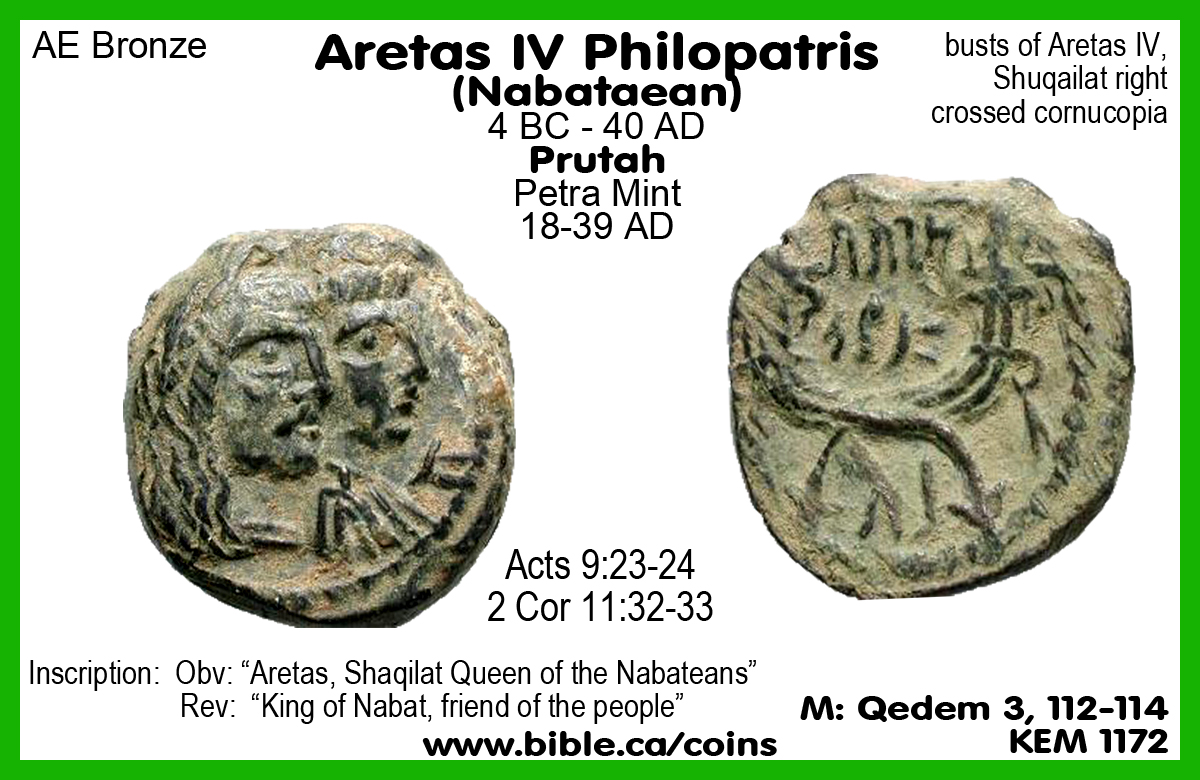
- The Nabateans extended their territory to the Negev, and controlled the trade routes from ports in Gaza and eventually took control of Damascus under Aretas III:
- "Nabatean Occupation: After Alexander’s death, independent kingdoms arose in Arabia. The Nabateans occupied the land vacated by the Edomites in northwest Arabia on the eastern side of the Aravah. They controlled the trade routes from southern and eastern Arabia to the Mediterranean. The Nabateans were nomadic herders who opposed Greek rule and culture (Bowersock, Roman Arabia, 13–14). They had considerable wealth, being the middlemen of the spice trade. By the time of the Maccabees in the second century bc, the Nabateans were relatively peaceful, settled traders (except for an episode of piracy on the Red Sea, for which they were “punished” by Ptolemaic naval forces), as opposed to other Arab tribes who were nomadic and violent (Bowersock, Roman Arabia, 20–21)." (The Lexham Bible Dictionary, Arabia, 2016 AD)
- The domain of Aretas IV Philopatris (4BC-40 AD) as king of Nabatean Arabia Petrea at Paul's conversion in 36 AD was as follows:
- Petra is Transjordan and the capital city of first century Arabia: "Since therefore Antipater saw that Hyrcanus did not attend to what he said, he never ceased, day by day, to charge feigned crimes upon Aristobulus, and to calumniate him before him, as if he had a mind to kill him; and so, by urging him perpetually, he advised him, and persuaded him to fly to Aretas, the king of Arabia; and promised, that if he would comply with his advice, he would also himself assist him, [and go with him]. (15) When Hyrcanus heard this, he said that it was for his advantage to fly away to Aretas. Now Arabia is a country that borders upon Judea. However, Hyrcanus sent Antipater first to the king of Arabia, in order to receive assurances from him, that when he should come in the manner of a supplicant to him, he would not deliver him up to his enemies. (16) So Antipater having received such assurances, returned to Hyrcanus to Jerusalem. A while afterward he took Hyrcanus, and stole out of the city by night, and went a great journey, and came and brought him to the city called Petra, where the palace of Aretas was." (Josephus, Antiquities 14.14-16)
- The Sinai Peninsula was outside Arabia and considered the land of Egypt when Joshua gives Simeon his land which bordered on EGYPT: "The lot of Simeon, which was the second, included that part of Idumea which bordered upon Egypt and Arabia." (Josephus, Antiquities 5.78)
- The Arab Peninsula from the Persian Gulf to the Red Sea up to the Gulf of Aqaba and Transjordan.
- Macherus was on the border between Rome and Arabia: The area east of the Salt Sea, west of Machaerus where John the Baptist was beheaded: "Macherus, which is a place on the borders of the dominions of Aretas and Herod" (Josephus, Antiquities 18.111)
- Arabia controlled the eastern portion of Syria around Damascus:
- "Aretas reigned over Coele-Syria, being called to the government by those that held Damascus, by reason of the hatred they bare to Ptolemy Menneus. He also made thence an expedition against Judea, and beat Alexander in battle, near a place called Adida; yet did he, upon certain conditions agreed on between them, retire out of Judea." (Josephus, Antiquities 13.391)
- "Aretas reigned over Coele-Syria, having been appointed by those living in Damascus, because they Ptolemy Menneus." (Josephus, Antiquities 13.391)
- At their zenith of territorial expansion and control under Aretas IV Philopatris (4BC-40 AD), the Nabateans occupied a collection of towns (Oboda, Sobata, Elusa, Ruheiba, Nessana, Mampsis, Advat) just south of Beersheba in Judah.
- Oboda was founded in the early Greek period (300 BC).
- However, around 25 AD, the Romans had learned to use the Monsoon winds to successfully sail directly by sea which decimated the Nabatean economy.
- Then these cities were destroyed 40-70 AD and the Nabateans were driven back to their Transjordan territory.
- "According to the archaeological evidence Oboda was settled for the first time at the end of the 4th century or early in the 3rd century bc by the Nabateans, who established a halt there on the caravan route from Petra to Gaza. The conquest of Gaza by Alexander Jannaeus, the Hasmonean monarch, in about 100 bc put an end to the Nabatean hold on the Negev. At the end of the 1st century bc, during the reign of Aretas IV, Oboda was rebuilt and enjoyed a period of glory, as is well attested by numerous inscriptions and other archaeological finds. In about the middle of the 1st century ad the city was sacked, probably by newly arrived nomadic tribes from Arabia, whose rock drawings and graffiti were found on rocks around the site." (The Archaeological Encyclopedia of the Holy Land, Oboda, 1986 AD)
- "After his death Obodas was buried at Oboda, the town named after him. Obodas was deified and—as evidenced by Nabatean and Greek inscriptions—his cult persisted at Oboda until the 3rd century ad. Without waiting for Augustus’ confirmation Aretas IV (4 bc–ad 40), son of Obodas, ascended the throne. In his coins and inscriptions he is known by the title ‘he who loved his people’. During his reign the kingdom reached its highest point, both economically and in its architecture, sculpture, painting and pottery. Except for the dispatch by Aretas of a military force to quell some riots in Judea after Herod’s death in 1 bc (Josephus, Antiq. xvii, 287), and a mention of him as ruler of Damascus in ad 39 (2 Cor. 11:32), there is little about him in the ancient sources. On the other hand an exceedingly large number of inscriptions, dated by the years for which Aretas IV had reigned, have been found in every quarter of the kingdom, from northern Arabia in the south to southern Syria in the north, and to Oboda and Sobata in the west. These testify to the great expansion of the kingdom. The decline set in during the reign of Malichus II (ad 40–70), the first-born son of Aretas IV. First the Nabateans lost Damascus. In ad 67 Malichus sent an army to help Vespasian in the siege of Jerusalem (Josephus, War iii, 68). Otherwise he is little mentioned. It was in his time that the Romans learned to make use of the southwest monsoon. Earlier in the 1st century ad Hippalus had discovered that the monsoon made it possible to sail safely to India and back and they were therefore able to bring spices and aromatics directly from India to Alexandria and thence to Rome, dealing a mortal blow to the Nabatean economy. In about ad 50 it seems to have suffered another blow. New tribes migrated from Arabia to the southern parts of the kingdom and penetrated the Negev, where they destroyed Oboda and the forts on the Petra-Gaza road." (The Archaeological Encyclopedia of the Holy Land, Nabateans, 1986 AD)
- The Nabatean kingdom was conquered by Trajan in 106AD:
- "Rome annexed Nabatean kingdom and added the Sinai Peninsula FROM EGYPT to form the New triplet Arabia in 106 BC under Trajan. "It was not until 106 ad that the Romans officially annexed Nabatea and the “area around Petra” (Millar, Roman Near East, 94). Eventually, Rome extended their territory as far as Meda’in Saleh—300 miles south of Petra. Rome designated three sub-regions within Arabia: Arabia Petraea (Sinai and the old territory of Nabatea), Arabia Felix (the southwestern coast of the Arabian Peninsula), and Arabia Deserta (roughly the rest of Arabia). The Romans would control Arabia until the rise of the Islamic Arabian Empires of the seventh century." (Lexham Bible Dictionary, Arabia, 2016 AD)
- The Romans annexed of the Sinai Peninsula from the Egyptians in 106 BC where it was formally labelled Arabia Petraea by the Romans.
- If the Sinai Peninsula was not considered Arabia at the time of Paul, it is impossible for Mt. Sinai to be located in the modern Sinai Peninsula.
B. Ask Josephus where "Arabia" was and find Mt. Sinai in Transjordan Saudi Arabia!
- Josephus calls the Sinai Peninsula "Egypt". When Joshua gave Simeon his land in the Negev it Josephus said it bordered on EGYPT:
- "The lot of Simeon, which was the second, included that part of Idumea which bordered upon Egypt and Arabia." (Josephus, Antiquities 5.78)
- The only place Egypt can border Simeon is the Sinai Peninsula, proving the entire Sinai was Egypt both at the time of the Exodus and in the first century AD when Josephus lived.
- Josephus never calls the Sinai Peninsula "Arabia": NOT EVEN ONCE!
- Josephus uses the word Arabia/Arabian 241 times and NEVER ONCE IN REFERENCE TO THE SINAI PENINSULA.
- Josephus did not consider the modern Sinai Peninsula to be Arabia.
- It is clear that Josephus used the term Arabia exclusively as Transjordan, whose capital was located at Petra.
- Rome annexed the Sinai Peninsula FROM EGYPT in 106 BC under Trajan.
- The Romans annexed of the Sinai Peninsula in 106 BC where it was formally labelled Arabia Petraea by the Romans.
- "It was not until 106 ad that the Romans officially annexed Nabatea and the “area around Petra” (Millar, Roman Near East, 94). Eventually, Rome extended their territory as far as Meda’in Saleh—300 miles south of Petra. Rome designated three sub-regions within Arabia: Arabia Petraea (Sinai and the old territory of Nabatea), Arabia Felix (the southwestern coast of the Arabian Peninsula), and Arabia Deserta (roughly the rest of Arabia). The Romans would control Arabia until the rise of the Islamic Arabian Empires of the seventh century." (Lexham Bible Dictionary, Arabia, 2016 AD)
- Josephus was a soldier of the first Jewish was in 66 AD at Gamla but was captured by the Romans in 69 AD.
- Coins at Gamla were minted while Josephus was part of the rebel forces fighting Rome in the First Jewish War 66-69 AD)
- Here is one of the Gamla revolt coins I excavated at
Khirbet el-Maqatir in 2013 AD, Cav1:
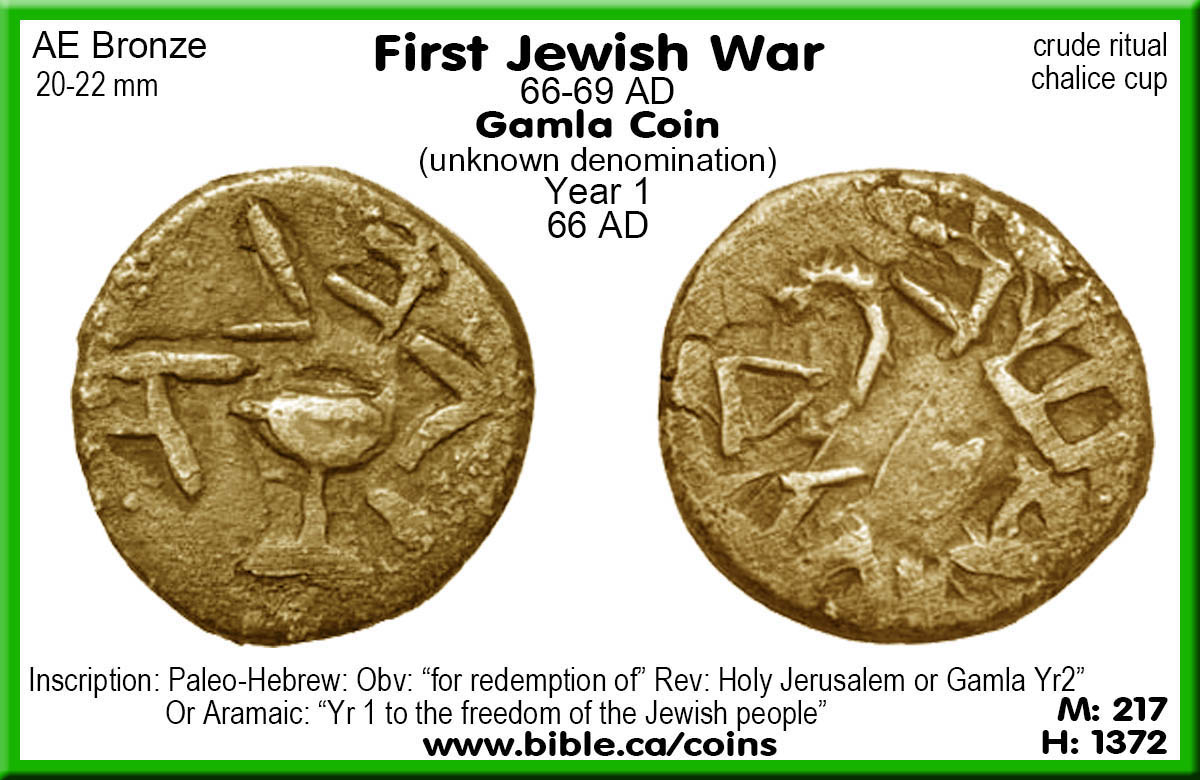
- While in jail, Josephus found favor and composed his famous Jewish Wars. (Rather fitting, since he had just been captured and Jerusalem was destroyed at the same time)
- King Agrippa II buys a copy of Joseph's book and actually describes his capture, captivity and writing his book: "As for myself, I have composed a true history of that whole war, and all the particulars that occurred therein, as having been concerned in all its transactions; (48) for [at Gamla] I acted as general of those among us that are named Galileans, as long as it was possible for us to make any opposition [First Jewish War: 66-69 AD]. I was then seized on by the Romans, and became a captive. Vespasian also and Titus had me kept under a guard, and forced me to attend them continually. At the first I was put into bonds; but was set at liberty afterward, and sent to accompany Titus when he came from Alexandria to the siege of Jerusalem; (49) during which time there was nothing done which escaped my knowledge; for what happened in the Roman camp I saw, and wrote down carefully; and what information the deserters brought [out of the city], I was the only man that understood them. (50) Afterward I got leisure at Rome; and when all my materials were prepared for that work, I made use of some persons to assist me in learning the Greek tongue, and by these means I composed the history of those transactions; and I was so well assured of the truth of what I related, that I first of all appealed to those that had the supreme command in that war, Vespasian and Titus, as witnesses for me, (51) for to them I presented those books first of all, and after them to many of the Romans who had been in the war. I also sold them to many of our own men who understood the Greek philosophy; among whom were Julius Archelaus, Herod [king of Chalcis], a person of great gravity, and king Agrippa himself, a person that deserved the greatest admiration." (Josephus, Against Apion 1.47-51)
- After 70 AD when Josephus wrote his famous book, the Nabatean empire had lost its presence in the Negev of Judea and was now entirely Transjordan.
- This explains why to Josephus, Arabia was not in southern Judea and certainly never in the Sinai Peninsula.
- A careful study of original sources will prove that in the first century, the Nabatean's did not control the Sinai Peninsula.
C. Strabo (15 AD) viewed "Arabia" as Petra with a territory the northern Arabian Peninsula between the
- In the mind of Strabo, Arabia was east of Judea, south of Syria, west of the Euphrates and the northern portion of modern Saudi Arabia to the exclusion of the Sinai Peninsula.
- Strabo defines "Arabia proper" as being Transjordan: "Above [ie to the east: East-up map] Judæa and Cœle-Syria, as far as Babylonia and the river tract, along the banks of the Euphrates towards the south, lies the whole of Arabia" (Strabo, Geography 16.3.1)
- Strabo says Arabia begins from Babylon and goes west through the Arabian Desert. "ARABIA commences [begins] on the side of Babylonia with Mæcene. In front of this district, on one side lies the desert of the Arabians, on the other are the marshes opposite to the Chaldæans, formed by the overflowing of the Euphrates, and in another direction is the Sea of Persia." (Strabo, Geography 16.4.1)
- Strabo continues to define "Arabia" through Eratosthenes, as being Transjordan in north Saudi Arabia in distinction to "Arabia Felix": "I return to the opinions of Eratosthenes, which he next delivers respecting Arabia. He is speaking of the northern and desert part, lying between Arabia Felix, Cœle-Syria, and Judæa, to the recess of the Arabian Gulf." (Strabo, Geography 16.4.2)
- Strabo defines Arabia proper as being Transjordan, south of the gulf of Aqaba, east of the main branch of the Red Sea (south of the Straits of Tiran) and west to the Persian gulf: "When we were describing Arabia, we included in the description the gulfs which compress and make it a peninsula, namely the Gulfs of Arabia [section below the tri-intersection of the Gulfs of Suez, Aqaba and Arabian] and of Persis [Persian gulf near Babylon]. (Strabo, Geography 17.1.1)
- Strabo calculates the length of the Red Sea from the Gulf of Aqaba to the Indian Ocean and says the area south of the Aqaba and east of the Red Sea is ARABIA: "The part of the Arabian Gulf along the side of Arabia, if we reckon from the recess of the Ælanitic bay, is, according to the accounts of Alexander and Anaxicrates, 14,000 stadia in extent; but this computation is too great." (Strabo, Geography 16.4.4)
- Strabo may have defined Lower Egypt as being the Sinai Peninsula. The southern limit of the Gulf of Aqaba may be not only where the Gulf of Aqaba intersects the Red Sea at the Straits of Tiran, but also the full length of the Gulf of Aqaba as well: "But Lower Egypt and the country as far as the Lake Sirbonis were sea, and confluent perhaps with the Red Sea at Heroopolis, and the Ælanitic (Aqaba) recess of the gulf." (Strabo, Geogr. 17.1.35)
- Agatharchides: 169 BC describes "Arabia" in great detail, including the various Arabian tribes.
- Agatharchides first specifically defines the gulf of Aqaba (Laeanites Gulf), then says that Arabia lies to the south of the gulf of Aqaba and east of the Arabian Sea (Main branch of the Red Sea south of the Gulf of Aqaba)
- Agatharchides did not sail down the Laeanites Gulf (Aqaba), but says the Arabs live on the east/south shore of the Gulf of Aqaba and that at the end of the Gulf, is Petra!
- Agatharchides never says that any Arabians lived in the Sinai Penisula.
- As he
sails down the Red Sea towards the Indian Ocean (Erythraean Sea), he
describes all the various tribes of Arabians.

D. This provides conclusive proof that in the mind of Paul, Agatharchides, Strabo and Josephus, that Arabia WAS NEVER the Sinai Peninsula, contrary to what the fiction writers or those with an overactive imagination boldly assert.
- Those who say the Sinai peninsula was how Paul defined Arabia, are perpetuating a fiction, creating confusion and causing a hindrance the true location in north Saudi Arabia.
- The location of Arabia proper really hasn't ever changed, from the time of the Exodus (1446 BC) when Israel arrived at Mt. Sinai down to the time of when Paul visited Mt. Sinai in 36 AD.
- There has never been a time in history that the Sinai Peninsula was defined as Arabia.
|
|
|
|
|
KEY#12 ISHMAEL IS ARABIA: Find Ishmael, find Sinai! The wilderness of Shur and Paran is where Ishmael lived Ishmael = Midian Hagar is Sinai |
|
"This is allegorically speaking, for these women are two covenants: one proceeding from Mount Sinai bearing children who are to be slaves; she is Hagar. Now this Hagar is Mount Sinai in Arabia and corresponds to the present Jerusalem, for she is in slavery with her children. But the Jerusalem above is free; she is our mother. For it is written, “Rejoice, barren woman who does not bear; Break forth and shout, you who are not in labor; For more numerous are the children of the desolate Than of the one who has a husband.” And you brethren, like Isaac, are children of promise. But as at that time he who was born according to the flesh persecuted him who was born according to the Spirit, so it is now also. But what does the Scripture say? “Cast out the bondwoman and her son, For the son of the bondwoman shall not be an heir with the son of the free woman.” So then, brethren, we are not children of a bondwoman, but of the free woman." (Galatians 4:24-31) |
- HAGAR = ISHMAEL = MIDIAN= ARABIA = MT. SINAI: Paul's Allegory in Gal 4 about Mt. Sinai:
- It is actually shocking that for all the efforts to locate Mt. Sinai, that so many completely ignore the fact that Paul located Mt. Sinai, NOT ONLY in Arabia, but where Hagar lived.
- In 2066 BC Abraham and Hagar are the parents of Ishmael who became the Ishmaelite tribe.
- In 2066BC Abraham and Ketura are the parents of Midan who became the Midianites.
- Ishmael and Midian were brothers who lived in the same exact geographic location and intermarried to become one people by the time Joseph entered Egypt in 1899 BC
- In 225 BC, Demetrius the Chronographer connected Moses living in Midian as the place Abraham sent his two sons Ishmael and Midian to live.
- "There is, therefore, no inconsistency in Moses and Zipporah having lived at the same time. And they lived in the city of Midian, which was named from one of the sons of Abraham. For it (i.e.Scripture) says that Abraham sent his sons to the East to settle there. And (it says that) for this reason also, Aaron and Miriam said at Hazeroth that Moses had married an Ethiopian woman." (Eusebius, Preaparatio Evangelica 9:29.1-3, quoting Demetrius the Chronographer, 225 BC)
- This places the burning bush and the Mountain of God in Saudi Arabia.
- Find Ishmael; find Sinai because ISHMAEL IS ARABIA.
- The Bible is quite explicit that Ishmael lived Transjordan in the wilderness of Shur and the wilderness of Paran.
- Ishmael NEVER lived in the Egyptian territory of the
Sinai Peninsula as witnessed by their absence during the conquest of
Joshua in 1406-1399 BC
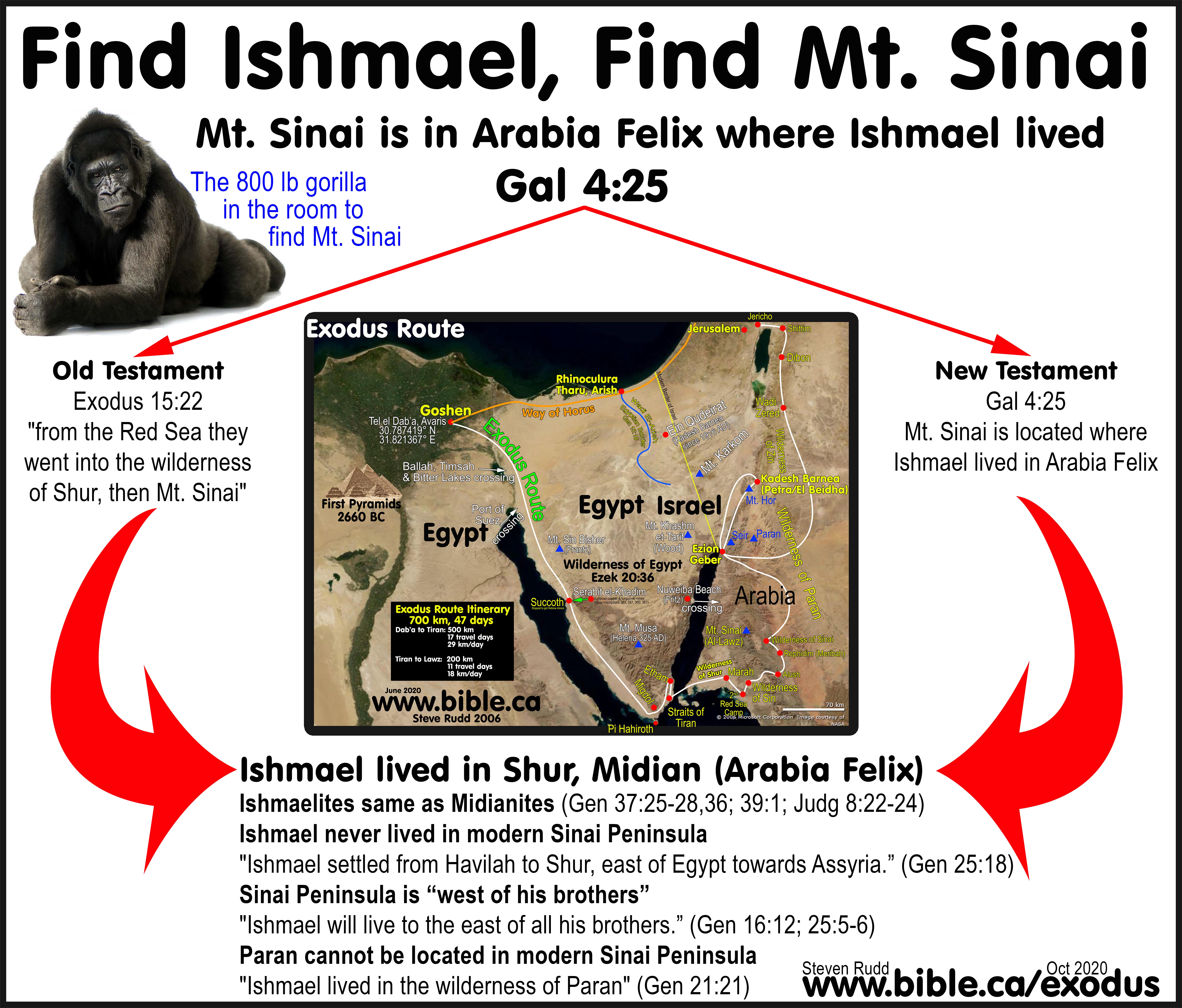
- FIND MIDIAN, FIND BURNING BUSH, FIND SINAI: Ishmaelites = Midianites = Midian: There is almost universal agreement that Midian was in north west Saudi Arabia, beside the Straits of Tiran. The Ishmaelites and the Midianites were both sons of Abraham through different mothers around 2066 BC. By the time Joseph being sold by his brothers in f separate origins had intermarried and become the same people as far back as when Joseph was sold into slavery in 1899 BC. Midian was Abraham's son through Keturah Gen 25:2; Ishmael was Abraham's son through Hagar. Although originally different sons of Abraham, the Midianites and Ishmaelites melded into a single group of people from the same region.
|
Gordon Franz gives the store away! |
"I would agree with the proponents of Jebel al-Lawz that Midian is in the area of northwestern Saudi Arabia today. I think most scholars would attest to that (Parr 1989: 39-66; 1996: 213-218)." (Gordon Franz, Is Mount Sinai In Saudi Arabia?, Bible and Spade, Volume 13, Page 105, 2000 AD) |
- Midianites and Ishmaelites are used interchangeably in the story of selling Joseph to Egypt: Gen 37:25-28,36; 39:1; Judg 8:22-24.
i. "Then they sat down to eat a meal. And as they raised their eyes and looked, behold, a caravan of Ishmaelites was coming from Gilead, with their camels bearing aromatic gum and balm and myrrh, on their way to bring them down to Egypt. Judah said to his brothers, "What profit is it for us to kill our brother and cover up his blood? "Come and let us sell him to the Ishmaelites and not lay our hands on him, for he is our brother, our own flesh." And his brothers listened to him. Then some Midianite traders passed by, so they pulled him up and lifted Joseph out of the pit, and sold him to the Ishmaelites for twenty shekels of silver. Thus they brought Joseph into Egypt. " Genesis 37:25-28
ii. "Meanwhile, the Midianites sold him in Egypt to Potiphar, Pharaoh's officer, the captain of the bodyguard." Genesis 37:36
iii. "Now Joseph had been taken down to Egypt; and Potiphar, an Egyptian officer of Pharaoh, the captain of the bodyguard, bought him from the Ishmaelites, who had taken him down there. " Genesis 39:1
- The Midianites were also called Ishmaelites who oppressed Israel 7 years and Gideon beat them in battle: "Then the men of Israel said to Gideon, "Rule over us, both you and your son, also your son's son, for you have delivered us from the hand of Midian." But Gideon said to them, "I will not rule over you, nor shall my son rule over you; the Lord shall rule over you." Yet Gideon said to them, "I would request of you, that each of you give me an earring from his spoil." (For they had gold earrings, because they were Ishmaelites.) " Judges 8:22-24
- Ishmael lived in the wilderness of Shur: updated map to extend Ishmael to shur
- “He [Ishmael] will be a wild donkey of a man, His hand will be against everyone, And everyone’s hand will be against him; And he will live to the east [Transjordan] of all his brothers.”" (Genesis 16:12)
- "They settled from Havilah to Shur which is east of Egypt as one goes toward Assyria; he settled in defiance of all his relatives." (Genesis 25:18)
- "He lived in the wilderness of Paran, and his mother took a wife for him from the land of Egypt." (Genesis 21:21)
- The Ishmaelites are grouped with other Transjordan tribes: "The tents of Edom and the Ishmaelites, Moab and the Hagrites; Gebal and Ammon and Amalek" Psalm 83:6
- "Transjordanian tribes of Gad and Manasseh, subjected the Hagrites and took control of their territory “until the [Assyrian] exile” (1 Chr 5:10, 19–22). Since the Hagrites are listed with other Transjordanian enemies of Israel during the preexilic period—Edom, the Ishmaelites, and Moab (Ps 83:7—Eng 83:7)—it appears that the hostilities continued even afterwards." (ABD, Hagrites)
- Ishmael lived in the wilderness of Paran
- Kadesh Barnea (modern Petra) was in the larger wilderness of Paran on the border of Edom. It is interesting that while Ancient Arabia (the Ishmaelites) did not live at Petra, in the first century, Nabatean Arabia had its capital city at Petra, which was still inside the wilderness of Paran, the ancient wilderness where Ishmael lived.
- The wilderness of Paran is Transjordan because when Moses spoke the words of Deuteronomy in the Wadi Zared, he was near Mt. Paran: "These are the words which Moses spoke to all Israel across the Jordan in the wilderness, in the Arabah opposite Suph, between Paran and Tophel and Laban and Hazeroth and Dizahab." (Deuteronomy 1:1)
- Shur is on the far side of the Red Sea crossing: "Then Moses led Israel from the Red Sea, and they went out into the wilderness of Shur; and they went three days in the wilderness and found no water." (Exodus 15:22)
- Paran is located after they left Mt. Sinai to Kadesh: "the sons of Israel set out on their journeys from the wilderness of Sinai. Then the cloud settled down in the wilderness of Paran." (Numbers 10:12)
- "they proceeded to come to Moses and Aaron and to all the congregation of the sons of Israel in the wilderness of Paran, at Kadesh; and they brought back word to them and to all the congregation and showed them the fruit of the land." (Numbers 13:26)
- The Amalekites lived near Mt. Sinai in north Saudi Arabia:
- "Now David and his men went up and raided the Geshurites and the Girzites and the Amalekites; for they were the inhabitants of the land from ancient times, as you come to Shur even as far as the land of Egypt." (1 Samuel 27:8)
- Shur would be near the city of Midian near the Straits of Tiran and "as far as Egypt" is the Sinai Peninsula.
|
Gen 25:18 |
Ishmael settled |
from Havilah to Shur |
which is east of Egypt as one goes toward Assyria |
|
1 Samuel 15:7 |
Amalekites |
from Havilah as you go to Shur |
which is east of Egypt |
|
1 Samuel 27:8 |
Amalekites from ancient times |
as you come to Shur |
even as far as the land of Egypt |
- ADD PARAN midian TO MAP correct ismalite spelling check amelakites maybe remove
- Mt. Sinai is located in the territory of Ishmael/Midian which is Transjordan in the wilderness of Shur and the wilderness of Paran in Saudi Arabia but never in the Sinai Peninsula. Gal 4:25 says that Mt. Sinai is in Arabia, where Ishmael lived.
OVERALL CONCLUSION:
- My thesis has used the "Bible only" to determine the exodus route and without history or archeology.
- Once the information from scripture was exhausted, only then did I supplement with cartography, history and archeology.
- Scripture alone is the only infallible record of history and it trumps the opinions of men, including me.
- RED SEA CROSSING:
- Scripture alone leads us to conclude that only the Straits of Tiran was the Red Sea crossing point.
- This forces the Wilderness of Shur (Ishmael and Midian) in north western Saudi Arabia.
- Any crossing point on the Gulf of Aqaba forces Mt. Sinai to be in north Saudi Arabia.
- MOUNT SINAI:
- Most important, of course, is that most miss the gorilla in the room in Paul's statement: "Now this Hagar is Mount Sinai in Arabia" (Galatians 4:25) Paul directly associated Mt. Sinai with the historic territory of the Ishmaelites/Midianites (Hagar), in Saudi Arabia.
- Gordon Franz and all his vacuous ruminations about Arabia starting at the Suez Canal, was located was looking for the wrong thing. Forget finding Arabia. Paul's point in Gal 4:25 is simple: Find Ishmael, find Sinai. This rules out the entire Sinai Peninsula and utterly refutes Franz by his own words, since he locates Ismael in the land of Midan near Mt. Lawz in Saudi Arabia.
- With Josephus, Jebel Lawz fits his description that "Sinai was the highest mountain in the region".
- There is nothing archeology can provide to support Mt. Lawz is Mt. Sinai.
- Ignore 100% of Ron Wyatt's unicorn archeological proofs.
- KADESH BARNEA:
- Using Scripture alone to tracing the southern border of Judah, we can prove beyond doubt, Kadesh Barnea is Transjordan southeast of the Salt Sea.
- With Josephus, we are able to pin Kadesh at Petra.
- With Archeology, El Beidha 5 km north of Petra becomes the best location for Kadesh.
- Even with extensive professional excavations at Petra or El Beidha, there is nothing from archeology that provides any direct occupational evidence for the Hebrews in either location.
- Josephus confirms the ancient tradition that Aaron was buried at Mt. Hor, 3 km to the west of Petra on the eastern side of the Arabah valley.
- Other evidentiary synchronisms for Kadesh at Petra include: the spring of Moses (Ein Musa), the river of Moses (Wadi Musa = the Siq), Petra being a burial city, modern Jews refer to their funerals as a "Kadesh" (holy).
- Most important, unlike Piltdown Kadesh at Ein Qudeirat where most modern bible maps put Kadesh since 1914 AD, Petra is not inside the promised land.
- When you use the Bible as your infallible guide and get the chronology right, the geography right, the archeology right and the history right you restore the Exodus route. Praise God!
The Great Exodus Psalm:
"He divided the sea and caused them to pass through, And He made the waters stand up like a heap. Then He led them with the cloud by day And all the night with a light of fire. He split the rocks in the wilderness And gave them abundant drink like the ocean depths. He brought forth streams also from the rock And caused waters to run down like rivers. Yet they still continued to sin against Him, To rebel against the Most High in the desert. And in their heart they put God to the test By asking food according to their desire. Then they spoke against God; They said, "Can God prepare a table in the wilderness? "Behold, He struck the rock so that waters gushed out, And streams were overflowing; Can He give bread also? Will He provide meat for His people?" Therefore the Lord heard and was full of wrath; And a fire was kindled against Jacob And anger also mounted against Israel, Because they did not believe in God And did not trust in His salvation. Yet He commanded the clouds above And opened the doors of heaven; He rained down manna upon them to eat And gave them food from heaven. Man did eat the bread of angels; He sent them food in abundance. He caused the east wind to blow in the heavens And by His power He directed the south wind. When He rained meat upon them like the dust, Even winged fowl like the sand of the seas, Then He let them fall in the midst of their camp, Round about their dwellings. So they ate and were well filled, And their desire He gave to them. Before they had satisfied their desire, While their food was in their mouths, The anger of God rose against them And killed some of their stoutest ones, And subdued the choice men of Israel. In spite of all this they still sinned And did not believe in His wonderful works. So He brought their days to an end in futility And their years in sudden terror. When He killed them, then they sought Him, And returned and searched diligently for God; And they remembered that God was their rock, And the Most High God their Redeemer. But they deceived Him with their mouth And lied to Him with their tongue. For their heart was not steadfast toward Him, Nor were they faithful in His covenant. But He, being compassionate, forgave their iniquity and did not destroy them; And often He restrained His anger And did not arouse all His wrath. Thus He remembered that they were but flesh, A wind that passes and does not return. How often they rebelled against Him in the wilderness And grieved Him in the desert! Again and again they tempted God, And pained the Holy One of Israel. They did not remember His power, The day when He redeemed them from the adversary, When He performed His signs in Egypt And His marvels in the field of Zoan, And turned their rivers to blood, And their streams, they could not drink. He sent among them swarms of flies which devoured them, And frogs which destroyed them. He gave also their crops to the grasshopper And the product of their labor to the locust. He destroyed their vines with hailstones And their sycamore trees with frost. He gave over their cattle also to the hailstones And their herds to bolts of lightning. He sent upon them His burning anger, Fury and indignation and trouble, A band of destroying angels. He leveled a path for His anger; He did not spare their soul from death, But gave over their life to the plague, And smote all the firstborn in Egypt, The first issue of their virility in the tents of Ham. But He led forth His own people like sheep And guided them in the wilderness like a flock; He led them safely, so that they did not fear; But the sea engulfed their enemies. So He brought them to His holy land, To this hill country which His right hand had gained. He also drove out the nations before them And apportioned them for an inheritance by measurement, And made the tribes of Israel dwell in their tents. Yet they tempted and rebelled against the Most High God And did not keep His testimonies, " Psalm 78:13-56
BECOME A CHRISTIAN TODAY:
Today in your personal life, when you reach your "Ethan" and feel "trapped" with nowhere to go while the Devil keeps his eye on you from his Migdol military watchtower, remember that God will always provide the way of escape. We escape the slavery to sin when we are baptized by full immersion like Israel through the Red Sea. As Christians, we are "the church in the wilderness" awaiting the time when our Saviour Jesus/Joshua returns from spying out the land and we will cross the Jordan to live with God forever in the promised land of Heaven.
|
Why not attend a good Bible believing local church in your own home town this Sunday. Click here to find the closest assembly of Christians to your house. |
By Steve Rudd: 2005 - October 2016: Contact the author for comments, input or corrections.

